Vol.IX,No.4 PUBLISHEDQU.-yiTERLY June,1023
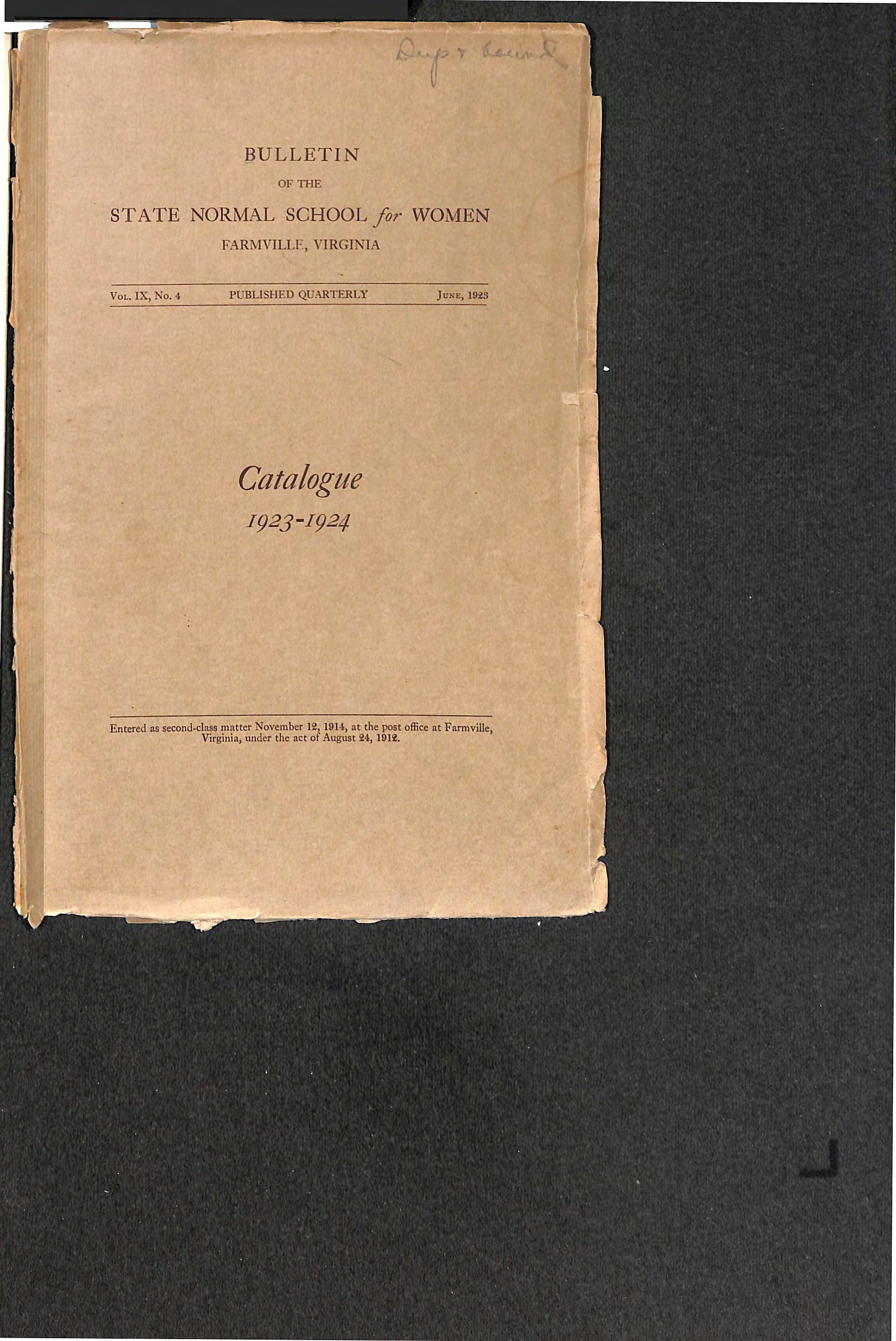
Catalogue
1923-1924
Entered assecond-class matter November 12,1914,atthe postoffice atFarmvUle, Virginia,undertheactofAugust24,1912.
:j"v. y /V
OFTHE
BULLETIN
STATENORMALSCHOOLforWOMEN/ I-ARMVIUJ-, MRGINIA
1"
V>P

\: k .1

,r \v

Vol.IX,No.4

FARMVILLE,VIRGINIA
PUBLISHEDQU.-\RTERLY June,1923
CATALOGUE
1923-1924
PUBLISHEDBV
TheState NormalSchoolForWomen
Farmville,Virginia
1923
OFTHE
BULLETIN
state normal school/or women
Saf

PORTSMOUTH. VA.: PRINTCRAFT PRESS, INC.
'■5: AS
ir I I T Ml I V - .^.r T- lirf^i'.i v'yi
1923

TABLE OF CONTENTS PAGE ImportantNotice 5 Calendar 8 ScheduleAppointments 9 VirginiaNormalSchoolBoard 10 Faculty 11 StandingCommittees 16 BusinessDepartment 17 OfficersofStudentOrganizations 18 ClassGifts 20 GeneralInformation: HistoryoftheSchool 21 Purpose 22 Location 22 Buildings 22 A Word to Division Superintendents 23 Discipline 23 Student Government Association 24 ReligiousLife ofthe School 24 Young Womens Christian Association 25 VirginiaNormalLeague 26 CunninghamMemorialLoanFund 26 State Loan Fund 27 Alumna; Association 27 LibraryandReading-Room 28 LiterarySocieties 28 Pi Kappa Omega Society 29 Student Publications 29 StateScholarships Expenses 30 EntranceRequirementsand Classification 32 RequirementsforTeachinginTrainingSchool 33 Accredited Schools 34, Coursesand Certificates 3^ Record ofStudents 36 Instrumental Music 37 CourseofStudy: Course 1 38 Course II 35 CourseIII 41 CourseIV 43 Course V 45

4 Table of Contents PAGE DepartmentsofInstruction; Biology 46 ChemistryandPhysics 50 Drawing 5a Education 54 English 66 Geography 7a Handwriting 76 HistoryandSocialSciences 77 HomeEconomics 81 IndustrialArts 85 Latin 87 Mathematics 90 ModernLanguages 94 Music 98 PhysicalEducation 102 Reading 104 TrainingSchool; Faculty 105 Organization 105 JuvenileLibrary 106 TrainingSchoolAnnouncement 106 ListofStudents 107 Recapitulation 118
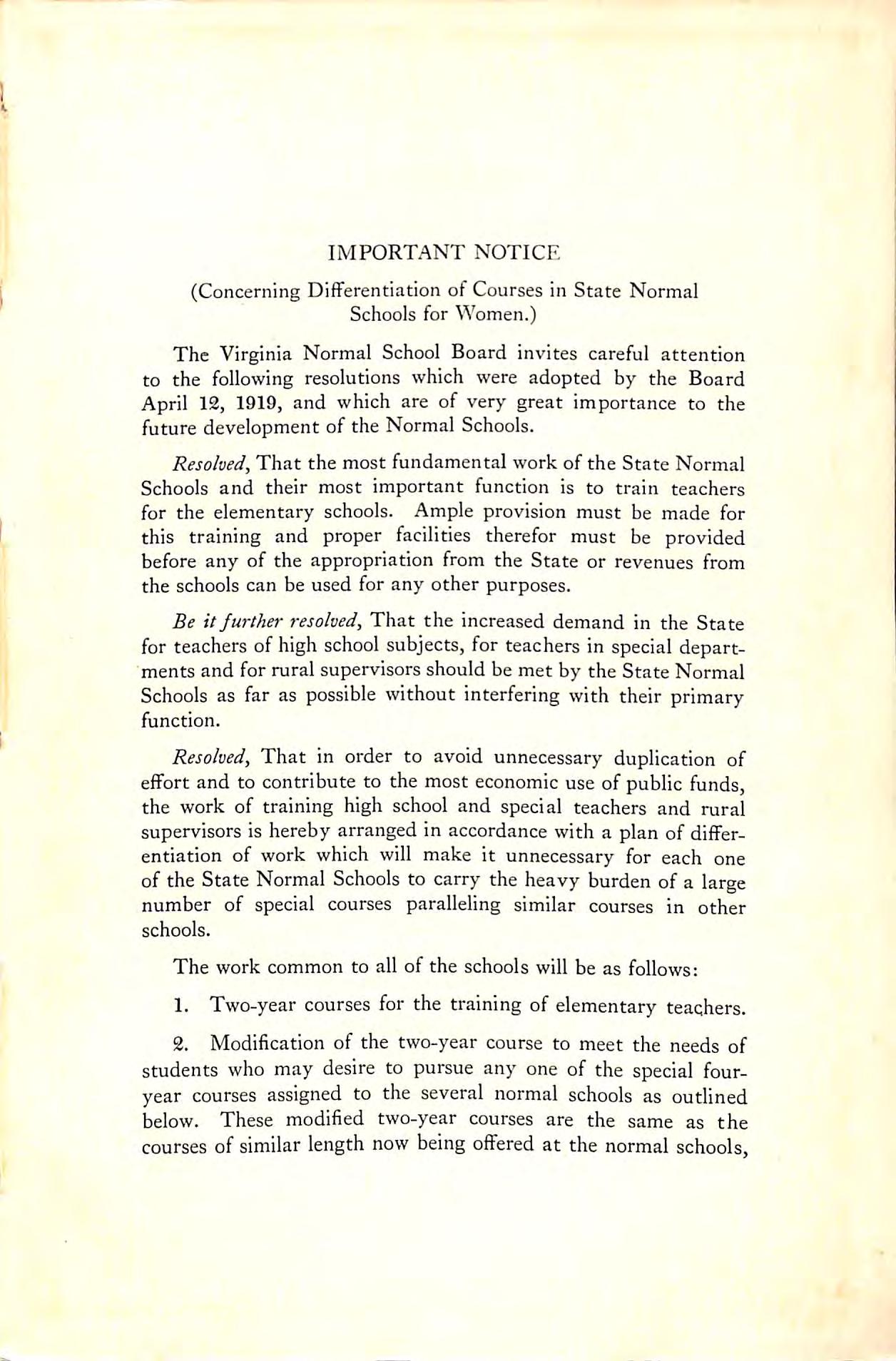
IMPORTANTNOTICE
(ConcerningDifferentiationofCoursesinStateNormal Schools for Women.)
The Virginia NormalSchool Board invites careful attention to the following resolutions which were adopted by the Board April 12, 1919, and which are of very great importance to the futuredevelopmentoftheNormalSchools.
Resolved^Thatthe mostfundamental workoftheState Normal Schools and their most important function is to train teachers for the elementary schools. Ample provision must be made for this training and proper facilities therefor must be provided before any of the appropriation from the State or revenues from the schools can be used for any other purposes.
Be itfurther resolved^ That the increased demand in the State for teachers of high school subjects, for teachers in special depart mentsandforruralsupervisorsshould be metby theState Normal Schools as far as possible without interfering with their primary function.
Resolvedy That in order to avoid unnecessary duplication of effortand tocontribute to the mosteconomicuseofpublicfunds, the workoftraining highschoolandspecial teachersand rural supervisorsisherebyarrangedinaccordancewithaplanofdiffer entiation ofwork which will makeit unnecessary for each one of the State Normal Schools to carry the heavy burden of a large number of special courses paralleling similar courses in other schools.
The work common to all ofthe schools will be as follows:
1. Two-year courses for the training ofelementary teachers.
2. Modification of the two-year course to meet the needs of students who may desire to pursue any one of the special fouryear courses assigned to the several normal schools as outlined below. These modified two-year courses are the same as the courses of similar length now being offered at the normal schools,

it not being the intention of the Normal School Board to interfere with the present catalogued two-year course. Such modified two-year courses at whatever normal school taken will be credited asthefirsttwoyearsofthespecialfour-yearcourseassigned toanyoneofthenormals.Inthiswaystudentswillhavepre served their appropriate credits.
In accordance with this plan every school is assigned a spe cific subject, but every other school is given the liberty of offering the present two-year course in that subject. This arrange ment is preserved in order that young women may go from one normal for advanced work in a special subject or subjects to another normal without suffering inconvenience or loss of credits. The only exception to this arrangement is found in the case of thecommercialcoursewhichwillbeofferedinitsentiretyat Fredericksburg.
Thedifferentiatedworkofadvancedgradeleadingtodegrees is assigned to the particular schools as follows:
To Farmville a four-year course for the training of high school teachers.
To Harrisonburg a four-year course for the training of teachers in home economics.
To Fredericksburg a four-year course for the training ofteachers in music, industrial arts and commercial subjects.
To Radford a four-year course for the training of supervisors of elementary schools and for specialists in rural education. To Radford is also assigned the task of extension work in rural education. This is a wide field of endeavor and all of the normal schools are expected to co-operate in the future as in the past, but under this plan the Radford Normal is given the duty to study the needs of and give general direction to rural extension work.
In view of the fact that all of the normals have heretofore been allowed to offer four-year courses for the training of high school teachers, it would be an apparent hardship on students
ImportantNotice

Important Notice
who have entered these courses not to allow some period in which readjustment can be made. The operation ofthis reso lution will, therefore, become effective July 1,1921. In the meantime no normal school will accept new students for the thirdandfourthyearsinanyspecialdepartmentotherthanthat assignedtoitbythisresolution.
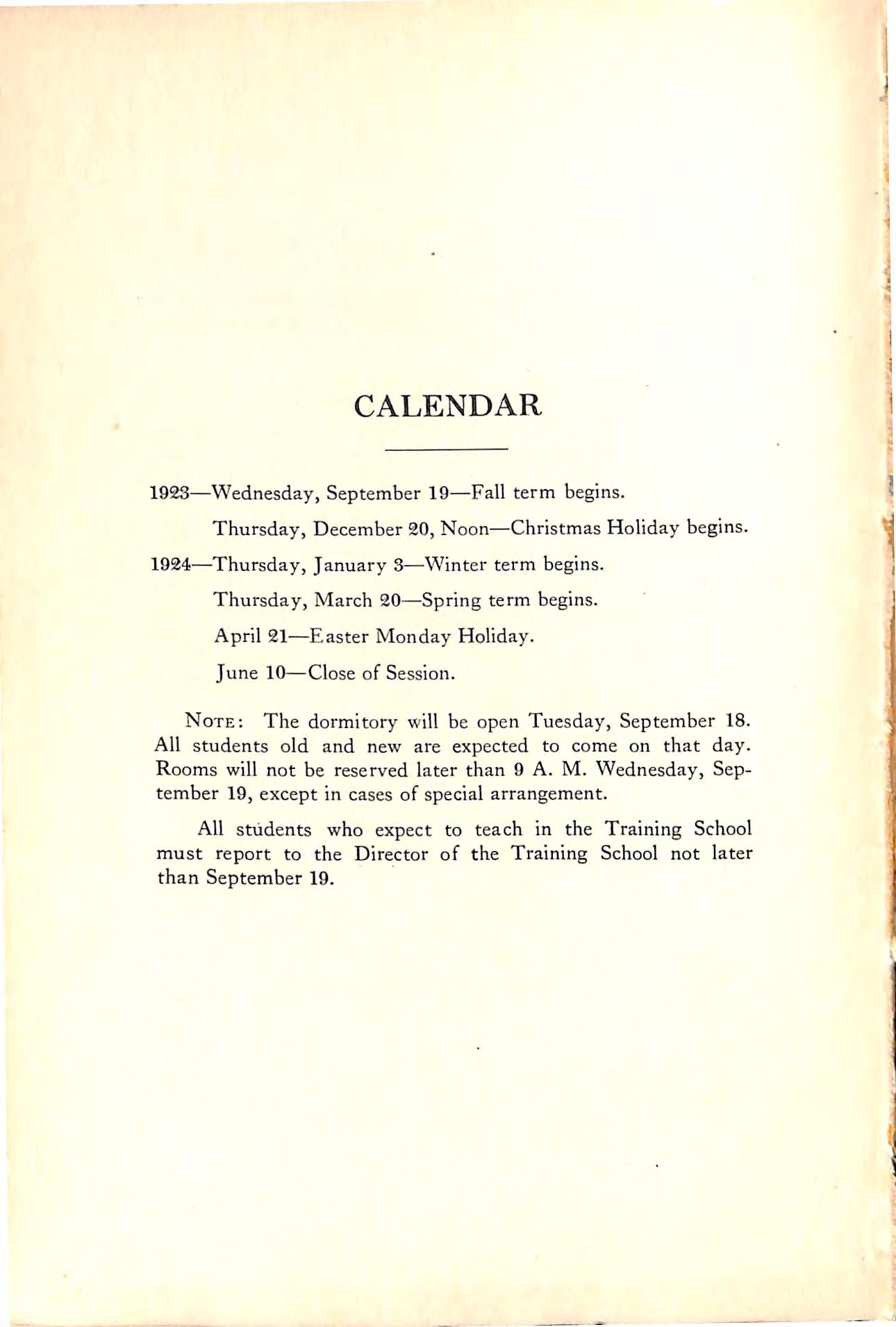
CALENDAR
1923—Wednesday,September19—Fallterm begins.
Thursday,December20,Noon—ChristmasHoliday begins.
1924—Thursday,January3—Wintertermbegins.
Thursday,March20—Springtermbegins.
April21—Easter Monday Holiday.
June 10—Close ofSession.
Note: The dormitory will be open Tuesday,September 18. All students old and new are expected to come on that day. Rooms will not be reserved later than 9 A. M.Wednesday,Sep tember19,exceptincasesofspecialarrangement.
All students who expect to teach in the Training School must report to the Director of the Training School not later thanSeptember19.
SCHEDULE APPOINTMENTS
Wednesday,September 19.
9:00—Auditorium—All second, third, and fourth-year stu dentswhoaretoteachinthefall.
11:00—Auditorium—All second, third, and fourth-year stu dentswhoare totakeacademicworkin thefall.
2:30—Room F—All the above whose schedules were not finished in the morning.
2:80—Room E—Tenth grade students.
4:00—Room E—Eleventh grade students.
Thursday,September20:
9:00—Auditorium—All first year students.
2:30—Room F—All students not yet scheduled.
Friday,September21:
8:30—Regularclassworkbegins.

ASnoofSl.OOwillbechargedeachstudentwhodoesnothaveherschedulemadeontime.
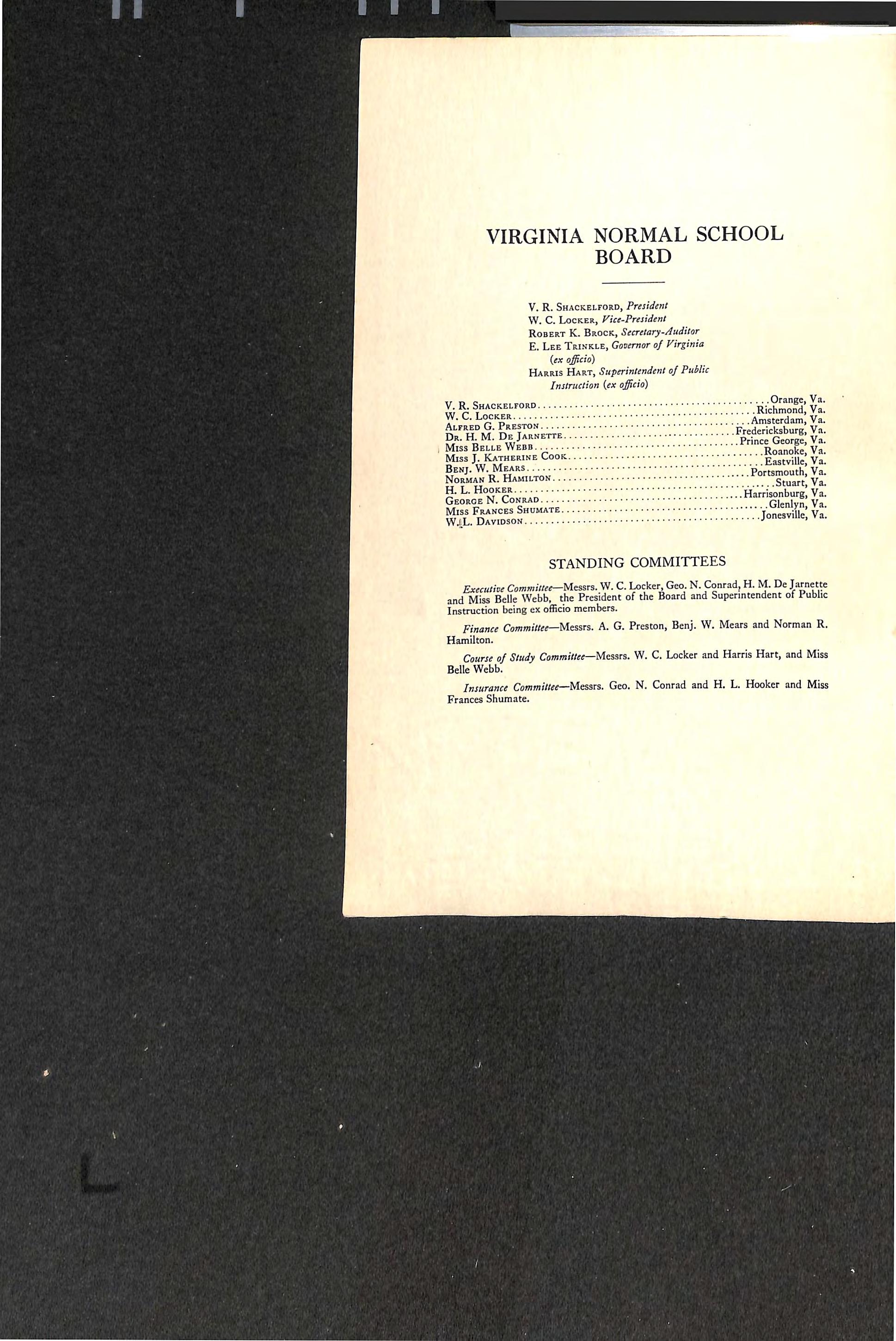
VIRGINIA NORMAL SCHOOL BOARD
V.R.Shackelford,President
W.C.Locker,Vice-President
RobertK.Brock,Secretary-Auditor
E.LeeTrinkle,GovernorofVirginia {exofficio)
Harris Hart,Superintendent ofPublic Instruction{exofficio)
^R va!
W,C. Locker^^^^ Amsterdam, Va.
n'' n.?I^«EVrE . Fredericksburg,Va.
Dr.H.M.DeJarnette q MissBelleWebb Pmnnke Va Miss J-Katherike Cook ;; VBenj.W.Mears •• Portsmouth,Va. Norm^ R. Hamilton Stuart, Va. Harriggbj..,va.
STANDING COMMITTEES
ExecutiveCommittee—Messrs.W.C.lacker,Geo.N.Conrad^H.M.De andMissBelleWebb,thePresidentoftheBoardandSuperintendentofPublic Instructionbeingexofficiomembers.
FinanceCommittee—Messrs.A.G.Preston,Benj.W.MearsandNormanR. Hamilton.
CourseofStudy Committee—Messrs.W.C.Locker and HarrisHart,and Miss BelleWebb.
Insurance CoototiV/«—Messrs. Geo. N. Conrad and H.L. Hooker and Miss FrancesShumate.
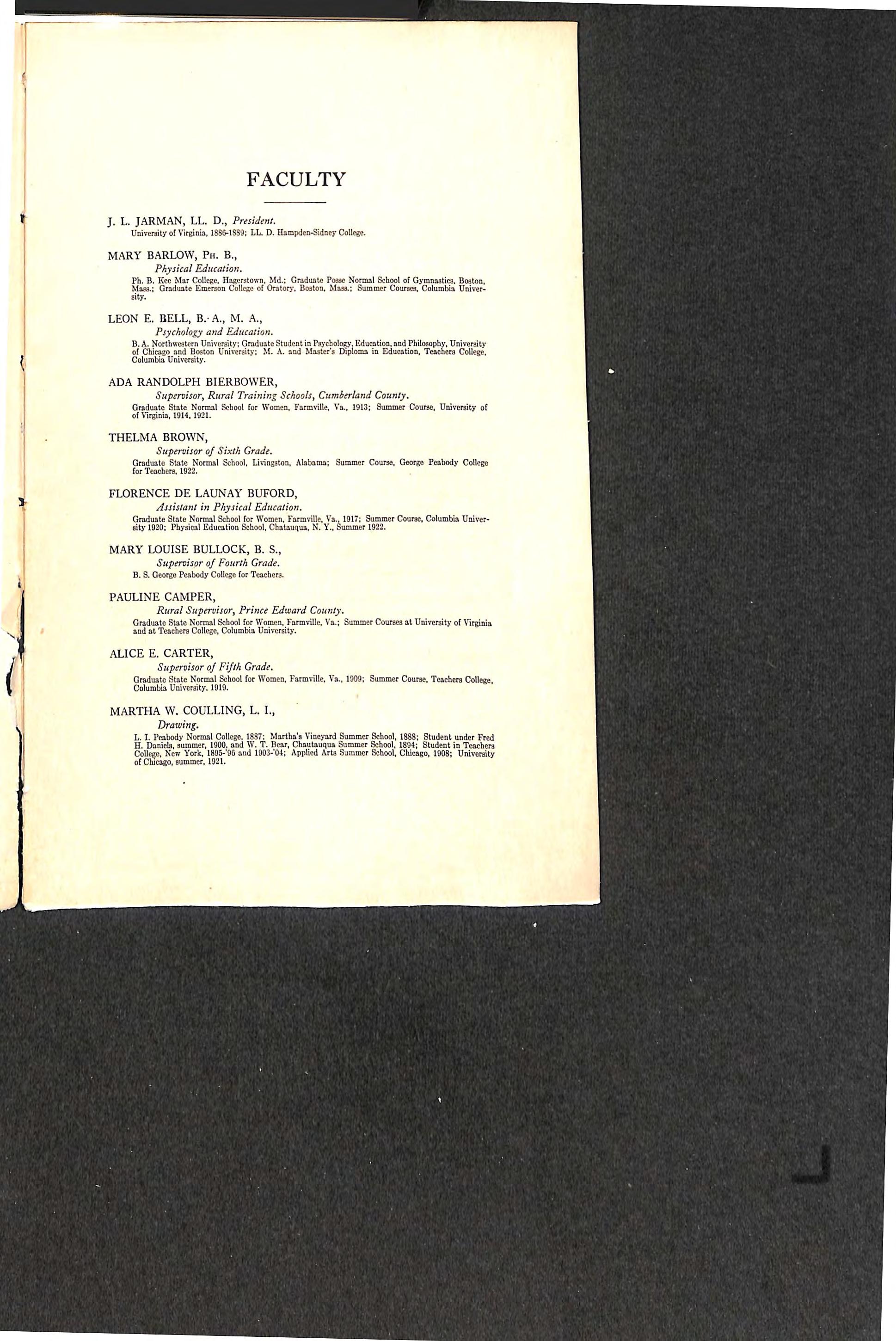
FACULTY
J.L.JARMAN,LL.D.,President. UniversityofMr^nia.186G-ISS9;LL.D.Hampdetk^idoeyCollege.
MARY BARLOW,Ph. B., PhysicalEducation.
Ph.B.KccMarCollege,Hagcrstown.Md.;GraduatePosseNormalSchoolofGymaastics.Boston, Mass.;Gr^uatcEmersonCollegeofOratory,Boston,Masa.;SummerCourses,ColumbiaUniver sity,
LEON E. BELL,B. A., M. A., PsychologyandEducation.
B.A.NorthwesternUniversity;GraduateStudentinPsycholojpf.Education,andPhilosophy,Univeraty ofChicago and Boston University; M.A.and Master's Diploma in Education,Teachers College. Columbia University.
ADARANDOLPH BIERBOWER, Supervisor^RuralTrainingSchools,CumberlandCounty.
GraduateStateNormalSchoolforWomen,Farmville.Va.,1913;SlimmerCourse,Univcrutyof ofVirginia,1914,1921.
THELMA BROWN, SupervisorofSixth Grade. GraduateState NormalSchool,Liiingston,Alabama; SummerCourse,GeorgePcabodyCollege forTeachers.1922.
FLORENCEDELAUNAYBUFORD, /AssistantinPhysicalEducation.
GraduateStateNormalSchoolforWomen.Farm\ille,Va.,1917;SummerCourse,Columl^Univer sity1920;PhysicalEducationSchool,Chatauqua,N.Y.,Summer1922.
MARY LOUISE BULLOCK,B,S„ SupervisorofFourthGrade.
B.S.GeorgePcabodyCollegeforTeachers.
PAULINECAMPER, RuralSupervisor,PrinceEdwardCounty.
GraduateStateNormalSchoolforWomen,Farmville,Va.;SummerCoursesatUniverstyofYirpnia andat"TeachersCollege,ColumbioUniversity.
ALICE E.CARTER, SupervisorofFifthGrade.
GraduateStateNormalSchoolforWomen,Farmville,Va.,1909;SummerCourse,TeachersCollege, Columbia University.1010.
MARTHAW.COULLING,L.L, Drawing.
L.I.PeabodyNormalCollege.18S7;Martha'sVineyardSummerSchool,1888;StudentunderFred H.Daniels,summer,lOOO,andW.T.Bear,ChautauquaSummerSchool,1894;StudentinTeachers College,NewYork,180&-'96and19l}3-'04;AppliedArtsSummerSchool,Chicago,1908;Univernty ofChicago,summer,1021,
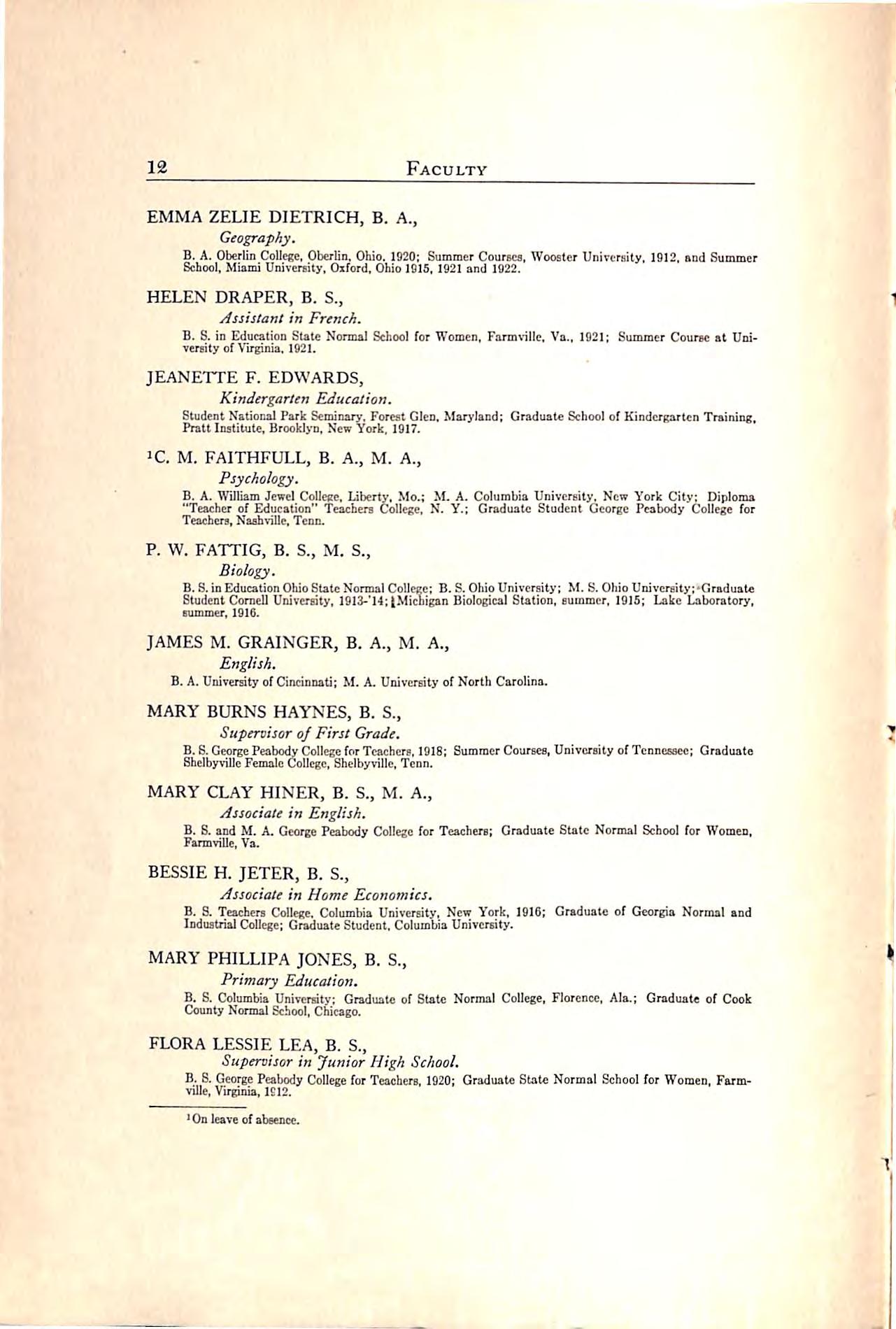
Faculty
EMMAZELIEDIETRICH,B.A., Geography.
B.A.OberlinCoUcgc,Oberlin.Ohio.1S20;SummerCourses,WooatcrUnivcrBity,1912,aodSummer School,MiamiUniversity,Oiford,Ohio1915,I92Iand1922.
HELEN DRAPER,B.S., yissistantinFrench.
B.S.inEducationStateNormalSchoolforWomen,Farmvillc,Vs.,1921;SummerCourseatUni versityofVirginia,1921.
JEANETTEF.EDWARDS, KindergartenEducation. StudentNationalParkSeminary.ForestGlen,Maryland;GraduateSchoolofKindergartenTraining, PrattInstitute,Brooklyn,NewYork,1917.
IC.M.FAITHFULL,B.A.,M.A., Psychology.
B.A.WilliamJewelCollesc,Liberty,Mo.; M.A.ColumbiaUniversity.NewYorkCity; Diploma "TeacherofEducation"TeachersCollege,N.Y.; GraduateStudentGeorgePeabodyCollegefor Teachers,Naahvillc,Tcnn.
P.W.FATTIG,B.S.,M.S., Biology.
B.S.inEducationOhioStateNormalCollege;B.S.OhioUniversity;M.S.OhioUniversity;-Graduate StudentCornellUniversity,1913-'H;{MichiganBiologicalStation,summer,1915;LakeLaboratory, summer,1916.
JAMESM.GRAINGER,B.A.,M.A., English.
B.A.UniversityofCincinnati;M.A.UniversityofNorthCarolina.
MARYBURNSHAYNES,B.S., SupervisorojFirstGrade.
B.S.GeorgePeabo<^CollegeforTeachers,1018;SummerCourses,UniversityofTennessee;Graduate ShelbyvillcFemaleCollege,Shelbyvillc,Tenn.
MARYCLAYHINER,B.S..M.A., AssociateinEnglish.
6.S.andM.A.GeorgePeabodyCollegeforTeachers;GraduateStateNormalSchoolforWomen, Fannville,Va.
BESSIE H.JETER. B. S., AssociateinHomeEconomics.
B.8.TeachersCollege.ColumbiaUniversity,NewYork,1916; GraduateofGeorgiaNormaland IndustrialCollege;Gr^uateStudent,ColumbiaUniversity.
MARY PHILLIPA JONES, B. S., PrimaryEducation.
B.S.ColumbiaUniversity;GraduateofState NormalCollege,Florence,Ala.; GraduateofCook CountyNormalSchool,Chicago.
FLORA LESSIE LEA,B. S.. SupervisorinJ"uniorHighSchool.
B.8.GeorgePeabodyCollegeforTeachers,1920;GraduateStateNormalSchoolforWomen,Farmville,Virpnia,1BI2.
>Onleaveofabsence.
12

Faculty ^
J.M.LEAR,B.A.,M.A., History andSocialSciences.
B.A.andM.A.Itandolph-MaconCollege,Aahland.V'a.; M.A.ColumbiaUniversity;Studentat LcipsicUniversity,lfiO^'05;SummerCourseatChicagoUniversity,1910:SummerCoursesatCo lumbia University,1913,1013,1920,1021.
RACHELROBINSON LEAR, SupervisorojSecondGrade.
GraduateofColoradoTeachersCollege;SummerCoursesatUnivcraityofI^ttsburgh,Pennaylvaoia StateCollege, UniversityofChicago. ColoradoTeachersCollege.
F.A.LEE,JR.,B.A.,M.A., Psychology.
B.A.Randolph-MaconCollege,Ashlaod,Va.;M.A.UoivermtyofYtrgiaU.
LILALONDON, Mathematics.
GraduateIfighSchool.Roanokc.Va.; CourseinSurveying.RoanokeCollege.Saletn,Va.;Special Student in Mathematics under Dr.VSlUiam M.Thoroton. University of Virdnia; Summer Course atKnoxvillc,Tenn.,1003,andCornellUoiverdty,1909;StudentGeorgePeabodyCollegeforTeocheta, Nashville.Tenn.,1918-'19.
T.A.McCORKLE,B.A.,M.S., ChemistryandPhysics.
B.A.WashingtonandLeoUni\-cr9ity; M.S.UniversityofChicago;FiveyearschemistinUnited StatesNavy.
HAZELBERNICEMILLICAN, IndustrialArts.
GraduateofNowBrunswickNormalSchoolinIndustrialArts.1915;SummerSchoolofScienceof theAtlanticProvinces,Fr^ricton.1911,andVarmouth.NovaScotia,1912;SummerCourse.Halifax Technology,1913;atPrinceofWalesCollege,Charlottetown,PrinceEdwardIsland,1014,andQorham,Maine,1920.
CHRISTINE E. MUNOZ, Music.
GraduateHighSchool,Cranford,N.J.;StudentofMoUenhauerConservatoryofMuric.Brooklya. N.Y.;GermanConservatoryofMusic,NewYorkCity;NewEnglandConservatoryofMusic,Boston. Mass.;SummerCourses,Potsdam.N.Y.;Chautauqua,N.Y.;TeachersCollege,N.Y.
georgie norris. SupervisoroJThirdGrade.
GraduateWoman'sCollege,Greenville.S.C.;SummerCoursesatUnivermtyofVirgiaiaandUni versityofChicago.
MARY E. peck. SupervisorinJ"uniorHighSchool.
GraduateStateNormalSchool,Farmville,Va.;SummerCourses.ColumbiaUniversity,1910; Uni versityofChicago,1916,1918;StudentatColumbiaUnivermty,1920-'21.
MINNIE V. RICE, Latin.
GraduateFarmvilleCollege; SummerCourseatHarvardUniversity; SummerCourseatColumbia University,1911.
ABIRUSSELL, Librarian.
GraduateofGeorgiaNormaiandIndustrialCollege;SummerCoursesatUniversityofTenueesee and UniversityofGeorgia; GraduateofCarnegieLibrarySchool,Atlanta,Ga.,1921.

GRACE L.RUSSELL,B.A., AisocxateinEnglish.
B.A.WestVirgiDiaUniversity;GraduateSkowhcganHighSchoolandBIoomBcIdAcademy;Student atColbyCollegethreeyears; CertificateHarvard University,SummerSesaon;GraduateStudent, SimtooiuCollege,Boston,Massachusetts.
^MARYADAMSSAVEDGE, Supervisorin JuniorHigh School. GraduateStateNormalSchoolforWomen.Farmville.Va.;StudentatGeorgePcabodyCollegefor Teachers,Nashville.Tcnn.;SummerCourse,UniversityofVirginia.
ILMAVONSCHILLING, SupervisorinJuniorHighSchool. StudentStuartHall.Staunton,Va.;SummerCourses,UniversityofVirginia,]005-'0fi*'07;Summer Course,TeachersCoU^,ColumbiaUniversity,ISIO.
ESTELLESMITHEY,B.A., Modem Languages.
B.A.Randolpb-MaconCollege,Aahland,Va.;DiplomaofL'AllianceFrancaisc.Paris.1899;Student attheSorbonne,Paris,1904-05;RinnmcrCotirseaatColumbiaUniversity,1913and1914.
EDNANORTONSPEAR,B.L.I.,B.E., Reading.
B.L.I.EmersonCollege;B,£.BostonUniversty.
FLORENCEHAMERSTUBBS,B.S., RuralEducation.
B.8.GeorgePcabodyCollegeforTeachers;Summer Courses,UniversityofTennessee,Winthrop College,UniversityofVirginia.
CARRIEB.TALIAFERRO,B.S., AssociateinMathematics.
B.S.TeachersCollege.ColumbiaUniversity,1915;GraduateStateNormalSchoolforWomen,Farmville,Va..1899;StudentatCornellUniversity,1907-'08:SummerCourse,CornellUniversity,1904.
W.F.TIDYMAN,M.A.,Ph.D., EducationandDirectorojTrainingSchool.
M.A.ColumbiaUniversity,1914;Ph.D.NewYorkUniversity,1916.
SARAH BOYD TUCKER,L. I., B. A., M. A., AssociateinHistoryandSocialSciences.
L.I.,B.A.WinthropCollege,1903;M.A.ColumbiaUniveroty,IQIO;SummerCoursesatChicago Univernty,1913,andatColumbiaUnivermty,1916and1919.
KATHARINETUPPER,B.S., HomeEconomics.
B.8.TeachersCollege,ColumbiaUniversity,1912;l^plomaOntarioLadies'College,Whitby,Canada,
RUTHWILKINS,B.A.,M.A., AssociateinEnglish.
B.A.McKcndreeCollege,Illinois;M.A.GeorgeFeabodyCollegeforTeachers. iQnleaveofabsence.
14
Faculty

DOROTHY ASKEW, StudentAssistantintheTrainingSchool.
EVELYN BARNES, StudentAssistantinMusic.
ELSIEBELL, StudentAssistantin Kindergarten,andHandwriting.
LENNIE BLANKENSHIP, StudentAssistantinHandwriting.
EDNA BLANTON, StudentAssistantinLibrary.
MARYBOLEN, StudentAssistantinLibrary.
ELLEN CARLSON, StudentAssistantin Library.
SUSIEFLOYD, StudentAssistantinLibrary.
NELL McARDLE, StudentAssistantinKindergarten.
MARY NICHOLS, Student Assistantin Spanish.
LOUISESCULL, StudentAssistantinLibrary.
ELSIESHAWEN, StudentAssistantinLibrary.
CHRISTINESHIELDS, StudentAssistantinEnglish.
MARJORIETHOMPSON, StudentAssistantinEnglish.
LOIS WILLIAMS, StudentAssistantinEnglish.
JENNIEM.TABS, Secretary to the President,and Registrar.
VIRGILIABUGG, AssistantintheRegistrar'sOffice.
MAUDK.TALIAFERRO, PostmistressandManagerojSupplyRoom.
Faculty 15
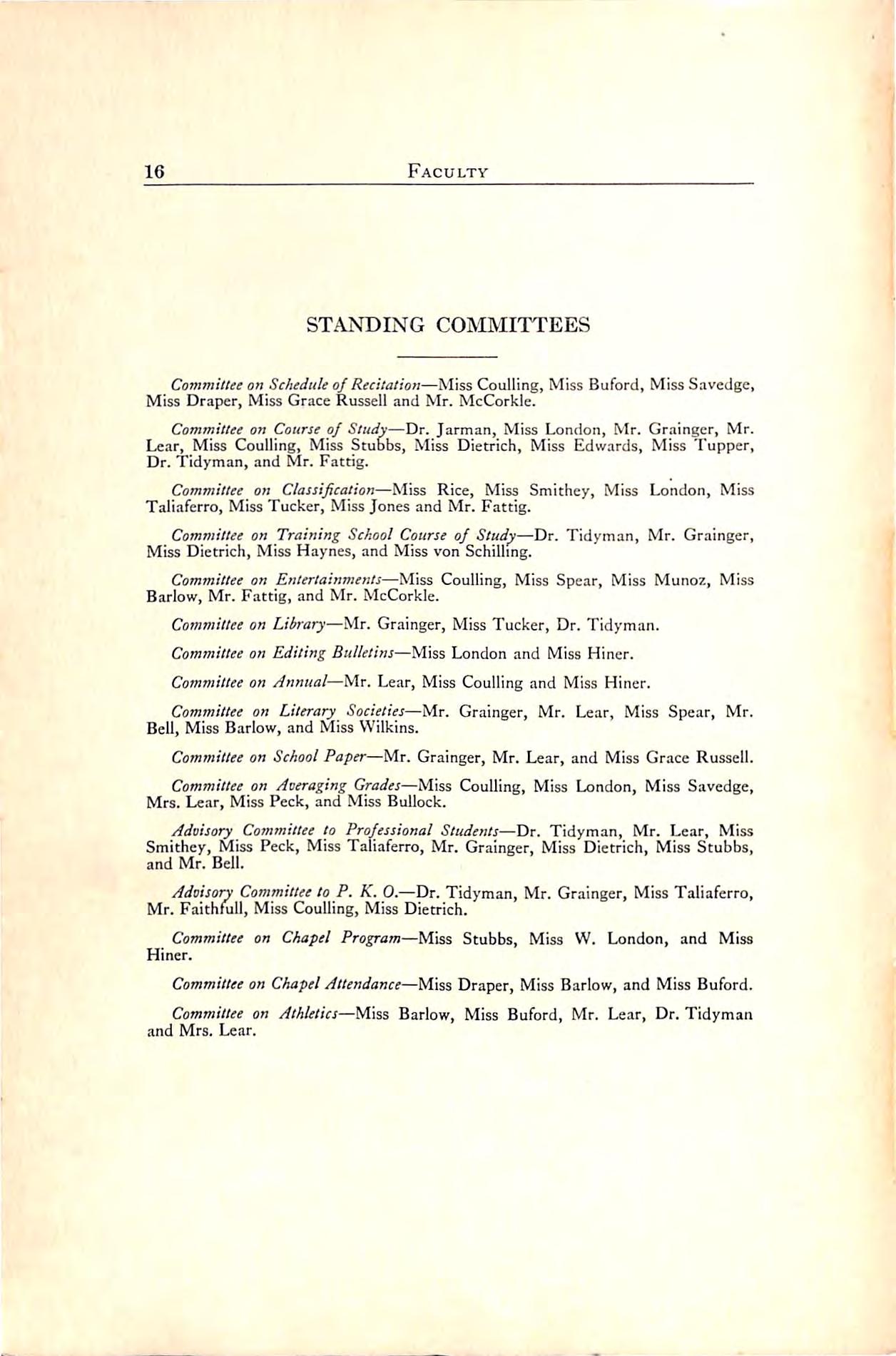
STANDING COMMITTEES
CommilteeonScheduleofRecitation—MissCoulling,MissBaford,MissSavedge, Miss Draper,MissGraceRussell and Mr.McCorkle.
Committee on Course ofStudy—Dr.Jarman,Miss London,Mr.Grainger, Mr. Lear, Miss Coulling, Miss Stubbs, Miss Dietrich, Miss Edwards, Miss Tapper, Dr.Tidyman,andMr.Fattig.
Committee on Classification—Miss Rice, Miss Smithey,Miss London,Miss Taliaferro,MissTucker,MissJonesandMr.Fattig.
Committee on Training School Course of Study—Dr. Tidyman, Mr. Grainger, MissDietrich,MissHaynes,andMissvonSchilling.
Committeeon Entertainments—MissCoulling,MissSpear,MissMunoz,Miss Barlow,Mr.Fattig,andMr.McCorkle.
CommitteeonLibrary—Mr.Grainger,MissTucker,Dr.Tidyman.
CommitteeonEditingBulletins—MissLondonand MissHiner.
CommitteeonAnnual—Mr.Lear,MissCoullingandMissHiner.
CommitteeonLiterarySocieties—Mr.Grainger,Mr.Lear,MissSpear,Mr. Bell,MissBarlow,andMissWilkins.
CommitteeonSchoolPaper—Mr.Grainger,Mr.Lear,andMissGraceRussell.
Committeeon AveragingGrades—MissCoulling,MissLondon,MissSavedge, Mrs.Lear,MissPeck,andMissBullock.
AdvisoryCommitteetoProfessionalStudents—Dr.Tidyman,Mr.Lear,Miss Smithey, Miss Peck, Miss Taliaferro, Mr. Grainger, Miss Dietrich, Miss Stubbs, andMr.Bell.
Advisory Committee to P. K.0.—Dr.Tidyman, Mr. Grainger, Miss Taliaferro, Mr.FaithfuU,MissCoulling,MissDietrich.
CommitteeonChapelProgram—MissStubbs,MissW.London,andMiss Hiner.
Committee on Chapel Attendance—Miss Draper, Miss Barlow, and Miss Buford.
CommitteeonAthletics—MissBarlow,MissBuford,Mr.Lear,Dr.Tidyman andMrs.Lear.
16 Faculty

BUSINESS DEPARTMENT
Mr.B.M.cox BusinessManager
Miss WINNIEHINER ClerktoBusinessManager
HOMEDEPARTMENT
Miss MARY WHITE COX , HeadofsheHome
Miss FRANCESB.SHELTON AssistantHeadoftheHome
Miss HOUSTON BLACKWELL AssistantinHomeDepartment
Mrs.L.B.WILLIAMS AssistantinHomeDepartment
Mrs.W.T.BLANTON
NightMatron
Mrs.BESSIECAMPERJAMISON Housekeeper
Mrs.ALICEPEERY AssistantHousekeeper
Mrs.LILLIANV.NUNN SupervisorofLaundry
Dr.SUSAN W.FIELD
ResidentPhysician
Mrs.WALTER S.FORE AssistantinInfirmary
Miss WILHELMINA LONDON y.fV,C.A.GeneralSecretary
i-;
'
i
^
I
OFFICERS OF STUDENT ORGAN IZATIONS
ExecutiveCommitteeofStudentGovernment/Issociation
Helen Miller President
Janie Moore Vice-Prcsident
OliveSmith Secretary
Evelyn Barnes Treasurer
LouiseJones
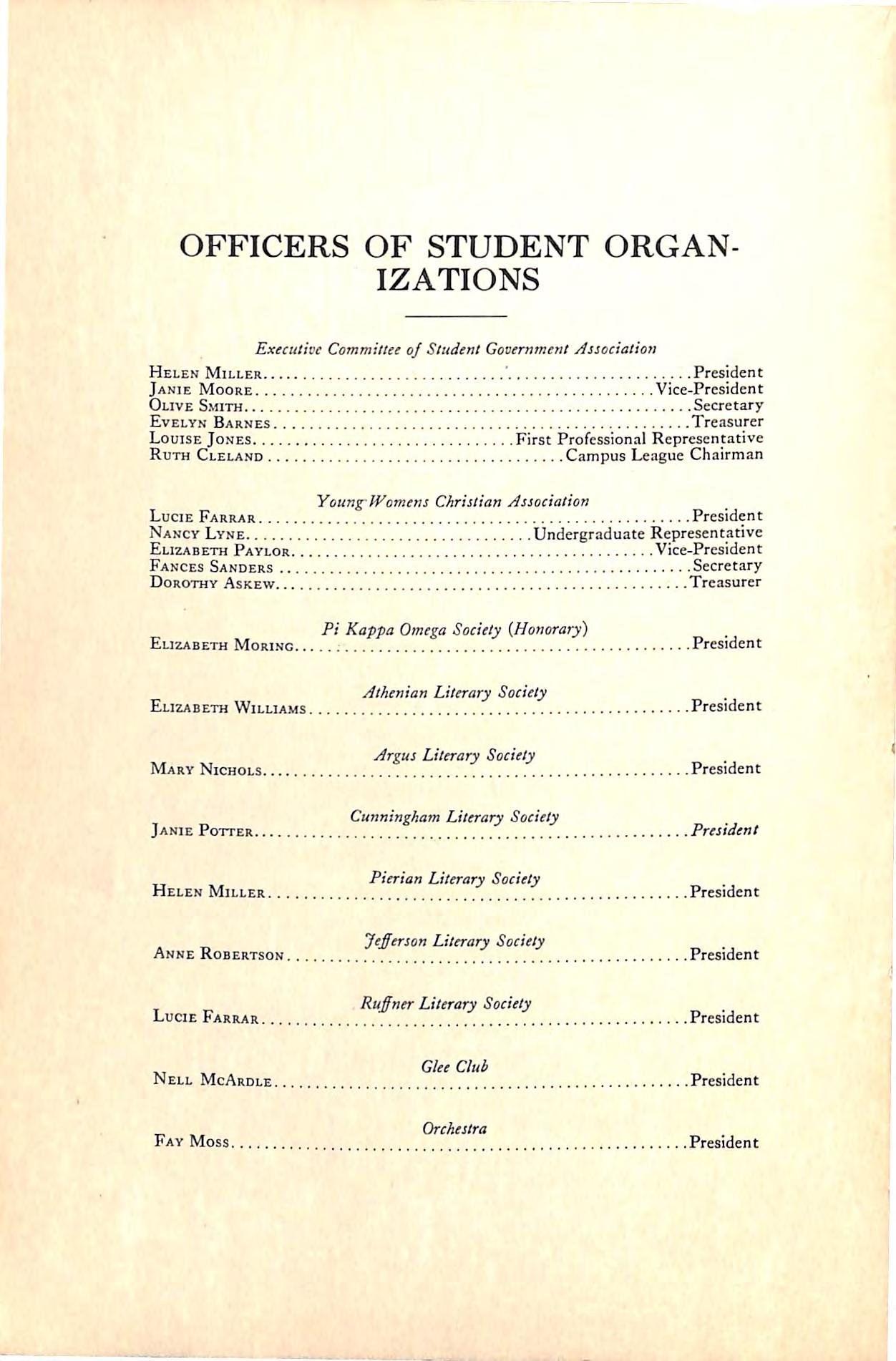
FirstProfessionalRepresentative
RuthCleland CampusLeagueChairman
Young-JVomensChristianAssociation
LucieFarrar President
Nancy Lyne Undergraduate Representative
ElizabethPaylor Vice-President
FancesSanders Secretary
Dorothy Askew Treasurer
Pi Kappa Omega Society {Honorary)
ElizabethMoring President
AthenianLiterarySociety .
ElizabethWilliams President
ArgusLiterarySociety
MaryNichols President
CunninghamLiterarySociety
JaniePotter President
PierianLiterarySociety
HelenMiller President
JeffersonLiterarySociety
AnneRobertson President
,RuffnerLiterarySociety
LucieFarrar President
GleeClub
NellMcArdle President
1- Orchestra
Fay Moss President
Officers of Student Organizations ^
AthleticCouncil
MamieSextok President
Rotunda{Paper)
EmilyCalcott ! Editor-in-Chief
ChristineArmstrong BusinessManager
Virginian{Annual)
KathleenMorgan Editor-in-Chief
AnneMeredith BusinessManager
Lois Williams
EmilyCalcott
FlorenceMiller
NancyLyne
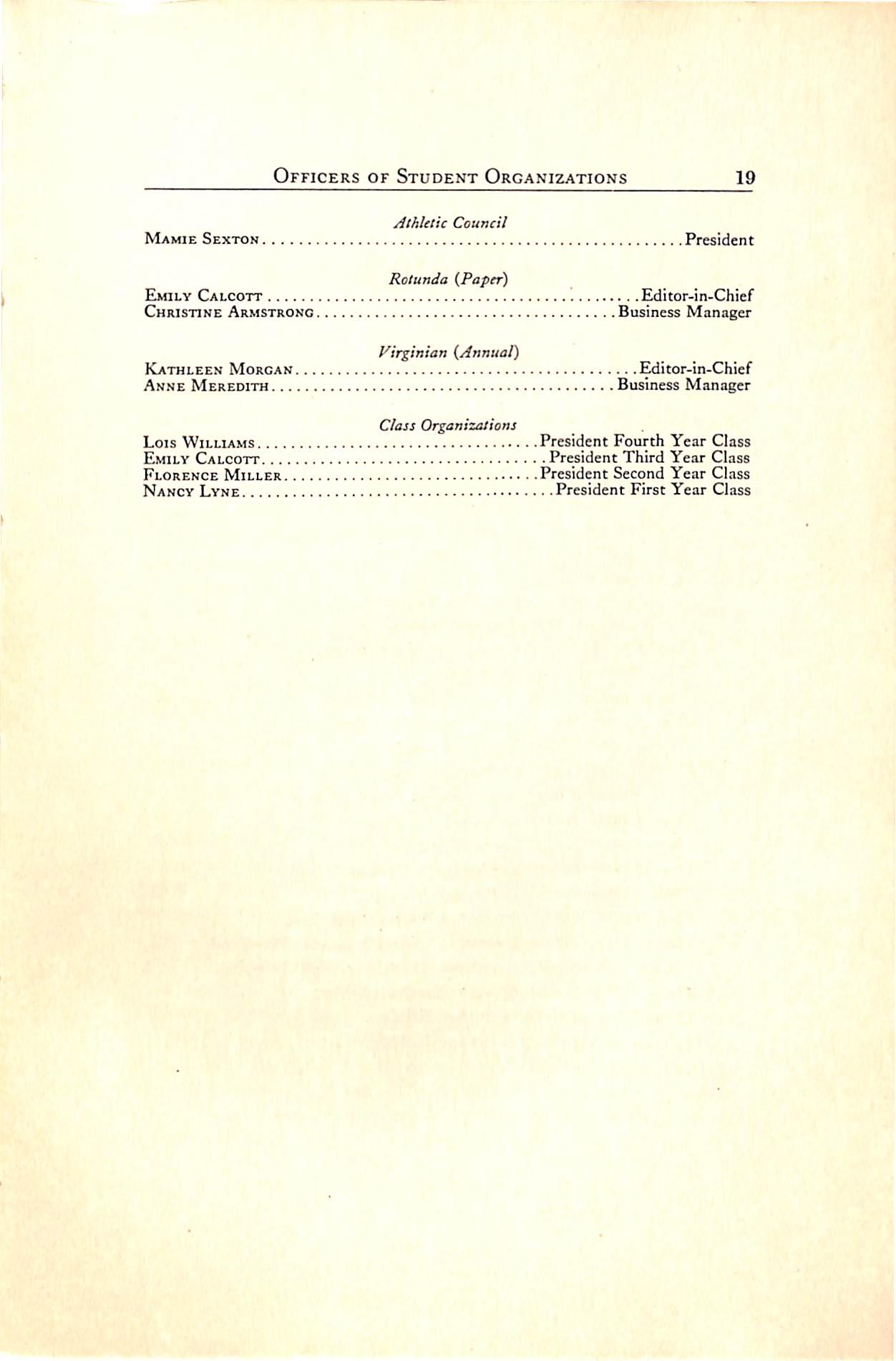
ClassOrganizations
PresidentFourth YearClass
PresidentThirdYearClass
PresidentSecondYearClass
PresidentFirstYearClass

CLASS GIFTS
Forsome years it has been the custom ofthe graduating class to leave with the school a parting gift, as a token of their love and loyalty. The following is a list of the gifts which have re sultedfrom thisbeautifulcustom:
ClassofJanuary,1904—BibleforAuditorium.
ClassofJune,1904—ReadingstandforAuditorium.
ClassofJanuary,1905—Statue(VenusdeMilo).
ClassofJune,1905—Statue(WingedVictory).
ClassofJanuary,1906—Statue(Urania).
ClassofJune,1906—Statue(MinervaJustiniana).
ClassofJanuary,1907—Picture(Aurora).
ClassofJune,1907—Picture(DanceoftheMuses).
Classof1908—Statue(DianaRobing).
ClassofJanuary,1909—Picture(CorotLandscape).
ClassofJune,1909—FlagfordomeofMainBuilding.
Classof1910—$140.00forNormalLeague.
Classof1911—$140.00forNormalLeague.
Class of 1912—$100.00 for pictures for Training School.
Classof1913—$100.00forbooksforInfirmary.
Classof1914—Statue(JeanneD'Arc).
Class of 1915—$100.00 for pictures for Training School. Classof1916—PortraitofPresidentJarman.
Classof1917—$150.00divertedtoBelgianReliefFund.
Classof1918—$185.00divertedtoStudentFriendshipWarFund. Classof1919—$150.00divertedtoUnitedWarWorkCampaign.
Class of 1920—Statue(Appeal to the Great Spirit).
Classof1921—$300.00forStudentBuilding.
Classof1922—$160.00forStudentBuilding.
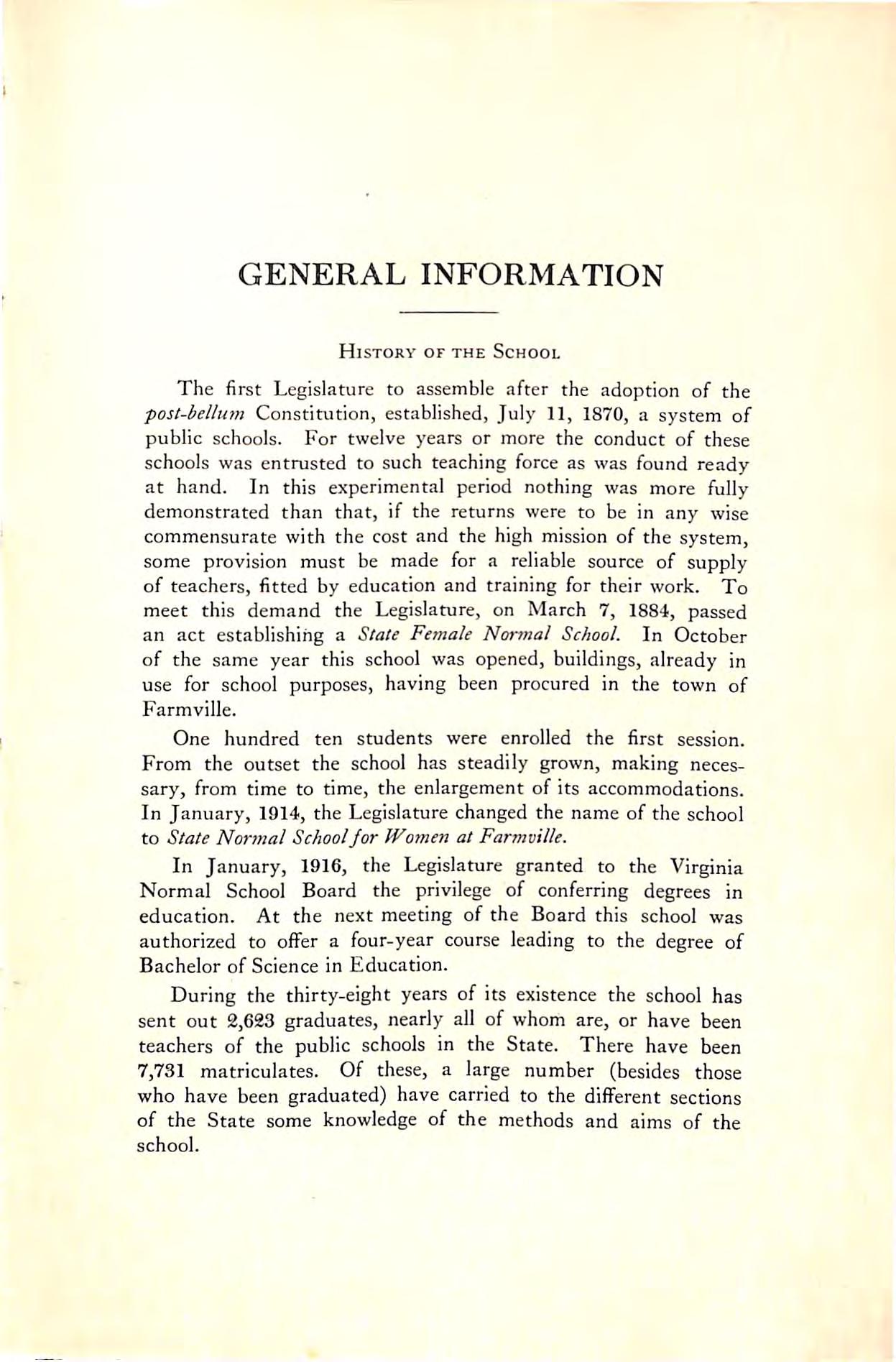
GENERAL INFORMATION
History ofthe School
The first Legislature to assemble after the adoption ofthe post-bellum Constitution,established,July 11,1870,asystem of public schools. For twelve years or more the conduct of these schoolswasentrusted tosuchteachingforceaswasfoundready at hand. In this experimental period nothing was more fully demonstrated than that,ifthe returns were to be in any wise commensuratewith thecostand thehighmissionofthesystem, some provision must be made for a reliable source of supply of teachers,fitted by education and training for their work. To meet this demand the Legislature,on March 7,1884,passed an act establishing a StateFemale NormalSchool. In October ofthe same year this school was opened,buildings,already in use for school purposes, having been procured in the town of Farmville.
One hundred ten students were enrolled the first session. From the outset the school hassteadily grown,making neces sary,from timetotime,theenlargementofitsaccommodations. InJanuary,1914,theLegislaturechangedthenameoftheschool to State NornialSchoolfor Women at Farmmlle.
In January,1916, the Legislature granted to the Virginia Normal School Board the privilege of conferring degrees in education. At the next meeting of the Board this school was authorized to offer a four-year course leading to the degree of BachelorofScienceinEducation.
During the thirty-eight years of its existence the school has sent out 2,623 graduates, nearly all of whom are,or have been teachers ofthe public schools in the State. There have been 7,731 matriculates. Of these, a large number (besides those who have been graduated)havecarried to thedifferentsections of the State some knowledge of the methods and aims of the school.

Purpose
The State Normal School for Women exists as a technical institution for the training of teachers to carry on the work of popular education in the State of Virginia. The central idea in theschool is to inspire young women toenter the profession of teaching with clear and accurate ideas of the various educa tional problems thatconfront the publicschool teacher. Itisnolongerdeemedadequate thata teacher beproficient in subject matter only; professional training must be added. Hence,evenintheacademicworkoftheschool,theprofessional ideaisemphasized. Incidental instruction in methodsisevery wheregiveninconnectionwiththepresentationofsubjectmatter. Every departmentin theinstitution lends its assistance to the department ofeducation in inspiring the young teachers with the loftiest ideals of what the true teacher should be, and what sort of service should be given the State. Thus,itbecomesapparentthatthepurposeoftheinstitution is to give to the teachers ofthe State of Virginia the highest professionalskillpossiblein thetrainingofherfuturecitizens.
Location
Farmville is a healthful and pleasant town of about three thousand inhabitants. It has good schools and five churches— Baptist, Episcopal, Methodist, Presbyterian, and Lutheran. Its location on the Norfolk and Western,about midway between Lynchburg and Petersburg, puts it in communication with all partsofthe State.
Buildings
The main building is a thoroughly modern and up-to-date brick structure, containing an auditorium, a reception hall, parlors, students' sitting-room, a library, reading-room, class rooms, laboratories, manual training workshop, gymnasium, offices,andhomeaccommodationsforfivehundredstudents.
Nearthe main building,yetentirelyapartfromit,isawellequippedinfirmary,in chargeofa woman physician,wholives in the building and gives her entire time to the health of the students.
GeneralInformation

General Information
The Training School is a modern school building, planned and constructed to meet the needs ofa thoroughly up-to-date school and at the same time to facilitate the training of teachers.
A Word to Division Superintendents
Ifthe Normal Schools ofthe State are to be productive ofthe best results, it is necessary for them to have the co-operation of the Division Superintendents of Education. These superin tendentsshould see to it thatevery county has itsjust repre sentation,taking care at the same time to recommend only such applicants as come up fully to the requirements. They should also call freely upon the presidents of the various schools for any service they can render,especially with reference to filling vacancies. See page 26.
Discipline
In the conductofa school for young women about to assume theresponsibilityofaseriousanddignifiedprofessionliketeaching, there is little occasion for arbitrary,iron-clad discipline. Beyond theexpectationthatthelifeofourstudentsshallconformtothe requirements of promptness and fidelity to duty,and exhibit that gentle demeanor and considerate regard for others which characterize refined womanhood, we have few fixed rules. This does not mean,however,that the girls are absolutely without re strictions. Itisthedutyoftheheadofthehomeandherassist antstokeepin closecontactwith thedailylife and conductof students,andtoprovidesuitablechaperonagewhenevernecessary. If the studentisfound to be fallingoff in her studies,neglecting duty, or exerting an unwholesome influence, prompt steps are takenforheramendment. A youngwoman whodoesnotshow somedispositiontoconformtohighstandardscanhardlybecon sideredgoodmaterialforateacher;so,ifoneisfoundunresponsive to patientendeavors to bring her to thelineofduty,her con nection with the schoolis quietlysevered by virtue ofthe fol lowingorderofthetrustees: "If,in thejudgmentofthe Presi dent, it shall at any time appear that a student is not making properuseoftheadvantages which theStateoffersin theState
^

NormalSchoolfor Women,orthat herinfluenceisin any way prejudicial to the interests of the institution, or of her fellow students,it shall be his duty to declare her place vacant."
StudentGovernmentAssociation
The purpose of the association is to preserve the student honorandtofurthertheinterestoftheschoolasfaraslieswithin its power.
It has jurisdiction over the girls during study period and in thedining-room,andin all casesin which the good nameof thestudentbodyasawholewouldbeinvolved.
Decisions rendered by the Student Government Committee aresubjecttotheapprovalofthePresident.
ReligiousLifeoftheSchool
WhileaStateinstitution,andhencenotunderdenominational influence,thisschoolrealizestheimportanceofalifehigherthan theintellectual,and thereligiousinterestsofthestudentsarea matter of constant concern. School is opened every morning with the reading of the Scriptures, a hymn, and prayer. The ministersoftheseveral denominationsofthe town take partin conducting these services.
Through the Young Womens Christian Association Bible Study classes are organized in each church. These classes are taughtbymembersofthefaculty,who,togetherwiththeministers and the Sunday SchoolSuperintendents,plan and outline courses ofstudy suitable for the different groups ofgirls. While attend ance on church services is not compulsory, a careful record of attendance is kept by the Home Department and the Bible StudyCommitteeoftheY.W.C.A.,andeverygirlis urged to join the Sunday School of her choice and to attend church regu larly.
The school endeavors to maintain high moral and Christian standards, and to create an atmosphere of earnestness, that it may send out young women equipped with a steady purpose to perform well and faithfully the duties that lie before them—a holy pur pose to make the most ofthemselves,that they may do mostfor others.
24
GeneralInformation
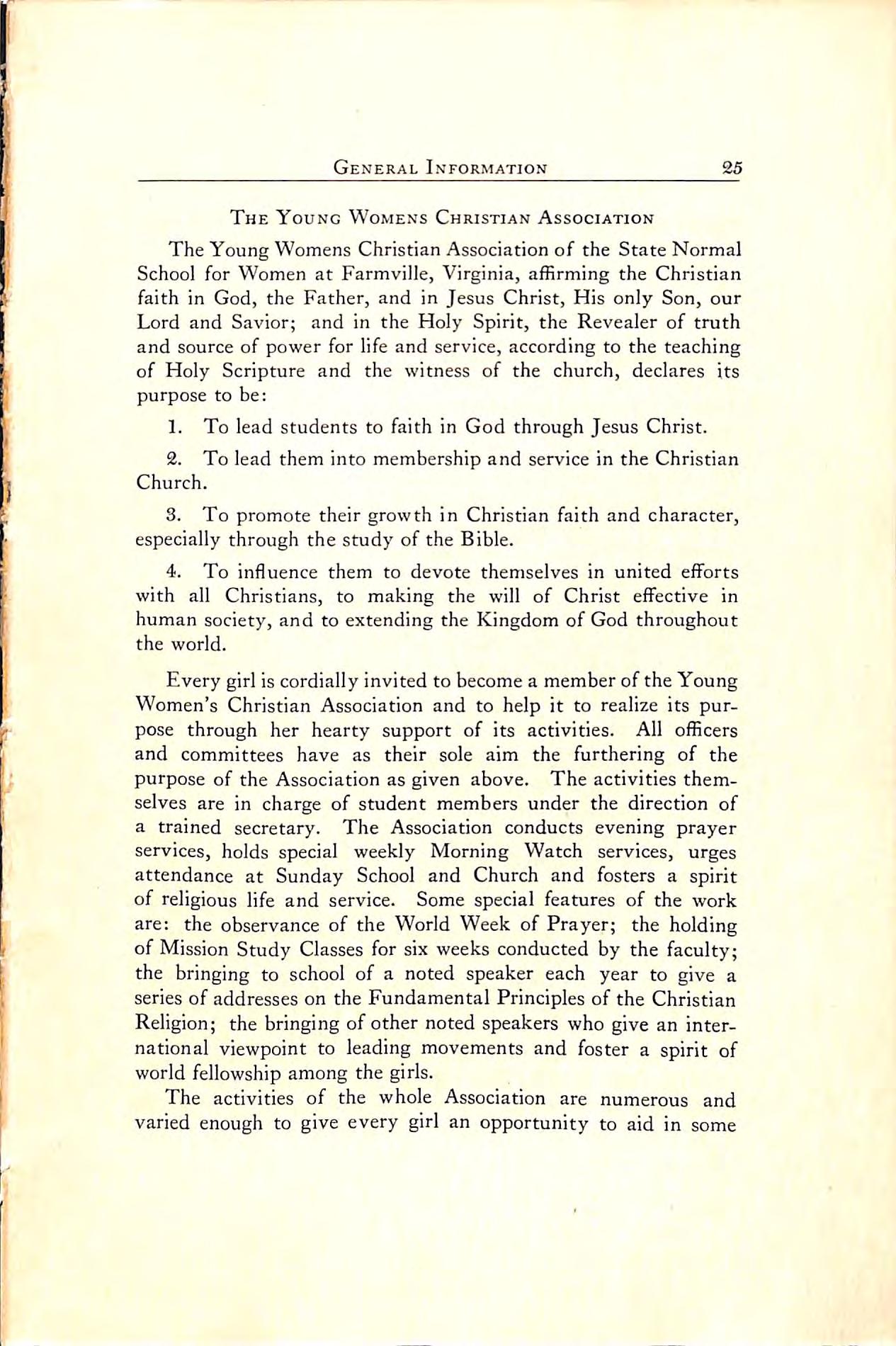
The Young Womens Christian Association
The Young Womens Christian Association of the State Normal School for Women at Farmville, Virginia, affirming the Christian faith in God, the Father, and in Jesus Christ, His only Son, our Lord and Savior; and in the Holy Spirit, the Revealer of truth and source of power for life and service,according to the teaching of Holy Scripture and the witness of the church, declares its purpose to be:
1. To lead students to faith in God through Jesus Christ.
2. To lead them into membership and service in the Christian Church.
3. To promote their growth in Christian faith and character, especially through thestudy ofthe Bible.
4. Toinfluence them to devote themselvesin united efforts with all Christians, to making the will of Christ effective in human society,and to extending the Kingdom of God throughout theworld.
Everygirliscordiallyinvited tobecomea memberoftheYoung Women'sChristian Association and tohelpittorealizeits pur pose through her hearty support of its activities. All officers and committees have as their sole aim the furthering of the purpose of the Association asgiven above. The activitiesthem selves are in chargeofstudent membersunder the direction of a trained secretary. The Association conducts evening prayer services,holdsspecial weekly Morning Watch services, urges attendance at Sunday School and Church and fosters a spirit ofreligiouslife and service. Somespecialfeaturesofthe work are: theobservanceofthe World Week ofPrayer; the holding ofMission Study Classes for six weeks conducted by the faculty; the bringing toschool ofa noted speaker each year to give a seriesofaddressesontheFundamentalPrinciplesoftheChristian Religion; the bringing ofother noted speakers who give an inter national viewpoint to leading movements and foster a spirit of worldfellowshipamongthegirls.
The activities of the whole Association are numerous and varied enough togiveevery girl an opportunity to aidinsome
GeneralInformation 25

part of the Christian work which will help her to realize the more "abundant life," and will enable her to grow "into the measure ofthestatureofthefullnessofChrist."
Virginia Normal League
The Virginia NormalLeague was organized in 1899 by Dr. Robert Fraser, then President of the school. The object of the Leagueistofoundand maintain aloan fund for thosestudents who would otherwise be unable to attend school. This fund is maintained by the annual membership dues of one dollar, and by voluntary contributions from outside sources. Its aim is to help by loans,withoutinterest,young women who wish to prepare foreffectiveserviceasteachers. Itoffers agoodopportunityto extend a helping hand to coming generations as well as this. Any contribution,largeorsmall,will be gratefully received. All of the funds of the League are in use. As soon as any amount is returneditisloanedoutagain,forthedemandisgreaterthan the supply. Thelargestamountavailableforany onestudentin a session is$250.00. Requests for loans should be made in writing byMay10ofprecedingsession.
Forfurtherdetailswritetooneofthefollowing:
Miss Martha W.Coulling,President.
Miss Minnie V. Rice, Chairman Finance Committee.
Miss Estelle Smithey,Chairman Loan Fund.
Cunningham MemorialLoanFund
Thealumneeoftheschool whograduatedduringtheadminis tration ofDr.John A.Cunningham,from 1886 to 1896,raised a fund,intending to establish a scholarship in memory of his faithful and loving service to them and to the State, feeling thatthemostfittingtributethatcould bepaidhim wouldbethe effort to give to those who are unable to obtain it for themselves the training for the work to which he devoted his life.
When this fund amounted to $1,000 it was changed from a scholarship fund to a loan fund and placed in the hands of the President to be used for this purpose.
26 GeneralInformation

Five per cent,interest is charged and properly endorsed notes are required. Thus, it is proving of great assistance to some of our beststudents.
Those wishing toobtain aloan from this fundshould apply tothePresidentoftheschool.
St.ate Loan Fund
The State of Virginia appropriates to this institution $800.00 annually to be used as a Loan Fund. Not more than $150.00 per session is loaned to any one student. The interest required isfour per cent.,and all notes must be properly endorsed.
Applications for assistance from the State Loan Fund should beaddressedtothePresidentoftheschool.
Alumn.e Association
The Alumnas Association includes all persons who have en rolled asstudentsin theschool. Graduatesareactive members, non-graduates are associate members. Regular biennial meet ings are held at the school on the Saturday preceding Bacca laureateSunday. Thebiennialmembershipfeeisonedollar.
Through the Association former students are keptin touch with theschooland with each other,and loyaltyisfostered by interest and service. Some ofthe work attempted is the holding of reunions at convenient times, as State and district teachers' meetings; the dissemination of school news of interest and im portance by means of circular letters and the newspaper, The Rotunda; the partial support ofa Y. W. C. A.secretary in for eign fields; the aiding of worthy young women by loans from Normal League and Cunningham Memorial Loan Funds; the organization of local chapters In many cities and counties to strengthen and render more eflFective the activities of the General Association and special service to the Farmville NormalSchool as opportunity arises.
The chief interest of the Alumnse at present is the completion of the fund for the Student Building, which is to house all the student organizations, the physical education department, and beofusetotheschoolinmanyways.
GeneralInformation 27

The officers for the term,June,1921,to June,1923,are:
President,Miss Pauline Camper,Farmville,Va.
Vice-President,Miss Mary Clay Hiner,Farmville,Va.
Corresponding Secretary, Miss Winnie Hiner, Farmville, Va.
Recording Secretary, Miss Fannie L. Berkeley, 1628 Grace St., Richmond,Va.
Treasurer, Miss Ethel Gildersleeve, 4771 Washington Ave., NewportNews,Va.
Organizer,Miss C.B.Taliaferro,Farmville,Va.
LibraryandReadingRoom
The students are supplied with collateral reading,reference work,and recreative readingfrom alibrary of10,198classified volumes, a reference room containing encyclopedias, diction aries,bound volumesoftheleading magazines,and atlases,and a reading room supplied with seventeen papers ofthe State,and from large cities outside of the State, besides one hundred and fifteen well selected departmental and popular periodicals.
LiterarySocieties
There are six literary societies,the Argus,the Athenian,the Cunningham, the Jefferson, the Pierian, and the Ruffner. These are an important factor in the intellectual and social life of the school. They impart a strong impulse to literary work, and bring the girls together at regular times for a common intellectual purpose. The literary societies aim primarily to promote a real interest in literature and to afford opportunities for practice in debating. Ail of the societies attempt to develop and exercise individual talent, to arouse and encourage social instincts, and to afford practice in organization and in parliamentary usage. Meetings are held every week throughout the year, and a spirit of friendly rivalry is shown in the effort to offer interesting programs. Each literary society chooses some special aspect of literature or some writer or group of writers to be studied during the year. This study forms the basis of the literary programs. Debatesalso are held atintervals. These debates develop the
28
GeneralInformation
powers of argument, clear and logical thinking, and forceful expression. In addition to this work the societies hold special meetings, which add variety. The programs for these meetings are in a lighter vein,and afford opportunity for the exercise and encouragementofmusicaland histrionic talent.
Pi Kappa Omega Society (honorary)
Organized 1918
This society was organized as the result of a need felt by faculty and students for an organization in recognition ofscholar ship, character, and leadership. The society purposes not only torecognizeand encouragesuch qualities,butalso to con tributebydefiniteformsofserviceto theintellectualandsocial lifeofthe Campus. Thestandardsfor admission are high and candidates are chosen by the faculty and by student members of the society. There are three kinds of members: student, associate(faculty),and honorary(alumnae).
Officersfor1922-192S
ElizabethMoring Preisdent
FlementinePeirce

Vice-President
ChristineArmstrong Secretary
AliceLeeRumbough Treasurer
Student Publications
The Rotunda is a weekly newspaper published by the stu dents. The editorial staffis composed ofstudents and alumn®, whoareassistedbyreportersfrom the variousclassesandschool organizations. The paper aims, by publishing news of the school, to keep the students,the faculty,and the alumnse in formed as to whatis goingon,andso,todraw them closer to gether. It affords valuable experience in journalistic work to thosewhoparticipateinitspublication.
The Virginian is an annual publication which is edited and publishedbytheSecondYearclass.
GeneralInformation 29

StateScholarships
Any young woman desiring an appointment as State student should apply to the President for application blank. This blank,whenfilledoutandsignedbytheDivisionSuperintendent, should be returned to the President. If the application is favor ably considered, the applicant is notified of her appointment. Every State student is required to sign a pledge that she will teach in the public schools of Virginia for at least two years after leaving the Normal School, While thus teaching she re ceivespayforservicesasany other teacher.
Upon theexpiration ofthisperiodsheisrequired tosend to thePresidentastatement,signed bya Division Superintendent, totheeffectthatshehasfulfilled thispledge;ormake tohim a satisfactoryexplanation ofherfailure to doso. Otherwise,she willreceiveabillforhertuition.
Allcommunicationsofinquiry,requestsfor catalogues,etc., should be made to the Presidentor the Registrar.
Young women from Virginia, not appointed as State stu dents, and applicants from other States, are admitted as pay students, the charge for tuition being $30.00 per session.
Expenses
A registration fee, payable in advance, for entire session, $10.00.
A medical fee, payable in advance, for entire session, $5.00. No medical fee is charged students whose homes are in Farmville.
Campus Fee, payable in advance for entire session $6.00. This fee covers: Subscription to the school paper {The Rotunda)^ Athletic Association dues. Student Association dues, and Lyceum Course ticket. All other contributions that the students are asked to make are optional, such as Literary Society dues, and support given the Virginia Normal League and the Young Womens ChristianAssociation.
The payment of the Campus Fee is optional for students whose homesareinFarmville.
30 GeneralInformation
Board, including furnished and heated room, lights, laundry, bedding and towels,everything for the entire session,$207.00.
Board is $207.00 for the session. It is not charged by the month,but is divided into nine payments of twenty-three dollars each. The first payment is due the day of arrival at school. Allotherpaymentsaredueonthefifteenthdayofeachsucceeding month. No reduction is made for absence during the Christmas holidays nor for absence less than thirty days.
Everystudentisexpected tocomplystrictly with thisregu lation unlessshe wishes to make her paymentsin largerinstal ments than twenty-three dollars.
Students must come prepared to make the following payments on entrance:

Total
The remaining payments on board are due the fifteenth of each month,and must be paid when due.
Checks for board or tuition should not be made payable to the President,but to the student herself.
The fees for laboratory courses are stated in connection with theoutlinesofthesecourses.
Tuition for pay students,for the term,payablein advance, $10.00.
The total expense per session for a State student, as shown above,is $228.00; for a pay student,$258.00.
All money due the school should be paid to Mr.B. M.Cox, BusinessManager,andreceiptstaken therefor.
Registration fees should be paid to Mr. Cox upon arrival at school,asnostudentisenrolledin herclassesuntilshecanshow areceiptforthisfee.
No diploma or certificate is granted to anyone until all sums due the school are paid, nor are students at liberty to occupy theroomspreviouslyassignedtothem untilthey havemadethe advance payment.
GeneralInformation 31
Registrationfee S10.00 Medicalfee 5.00 Campusfee 6.00 First paymenton board 2S.00
$44.00

Each student must supply her own text-books. Books will be furnished at publishers* prices, with cost of handling added. Students should come prepared to buy their books at once.
The Dormitories accommodate five hundred students. For applicantsin excessofthis number boardisobtained in private families at prices aboutequal to those given above. Nostudent, however,is allowed to board outside of the building without the consentofthePresident.
EntranceRequirementsandClassification
Thefollowing are thegeneralregulationsgoverningentrance andclassifications:
Graduates of accredited four-year high schools may enter any course. Upon the completion of two years they receive the diploma and upon the completion offour years they receive the DegreeofBachelor ofScience in Education.
Students coming from four-year high schools, having com pleted only fourteen units of work,are admitted and allowed to make up this back work, but in most cases it takes such stu dentstwoandahalfyearstogetthediploma.
Studentscomingfromcolleges,academies,orprivateschools, having done the equivalentof high school work,are admitted upon trial,subject to thesameconditions as high school grad uates.
HoldersofFirstGradeCertificates* whoaretwenty-oneyears ofage and have had atleastthree yearsofteaching experience afterreceivingFirstGradeCertificate mayenterthe First Year of Course II or III,and upon the completion ofthe year's work may receive from the Department of Public Instruction the Elementary Certificate. These students should understand,how ever,thatthisworkcan notbecredited toward adiploma until therequiredhighschoolunitshavebeen presented.
Allcandidatesforadmission bycertificate must file with the Classification Committee notlater than September 1 their cer tificates ofpreparation madeoutonthe blank furnished by the registrar. These blanks must come from some recognized insti'ScoCouraesandCertlGcatea3,page35.
32
GeneralInformation

General Information
tutionoraccreditedschool,mustbe madeoutbysome member ofthe faculty,and must bearthesignatureofthe head ofthe school from which they come. They must come direct to the Classification Committee and not through the hands of the can didates in question. The persons filling out these blanks are requested to make them as full,explicit,and definite as pos sible.
Certificates of preparation from private tutors are not ac cepted. Students thus prepared must in all cases take entrance examinations. These examinations may also be taken by any student who for any reason is unable to offer satisfactory cer tificates of work completed.
All classification based upon certificates and diplomas from other schools is conditional. If at any time the student shows inabilitytodothe workofanyclasstowhichshehasbeenthus admitted,sheisassigned toalowerclassatthediscretionofthe teacher.
In the professional years, because of the strictly technical nature of the work, no credit is given for courses completed at other than Registered State Normal Schools or standard col leges.
Students who re-enterschool after an absence ofa year or more will be admitted without examination, but they will be expected toconform to the requirements ofthelater catalogue— not ofthat under which they first entered.
Requirementsfor Teaching inthe Training School
Believing thatit is a greatinjustice both to the student her self and to the pupils in the Training School to allow a student withseriousacademicdeficienciestocontinuehercourseandprob ably fail at or near the time of graduation, the faculty has made the following requirements for entering upon teaching in the TrainingSchool:
For Courses/,//,andIII
1. One-half of the student's grades shall be C or higher. Of these grades three must be on the five essential subjects, English,History,Reading,Arithmetic,and Geography.
^

GeneralInformation
2. Nostudent who has more than one E or more than five periods ofextra work may enter upon her teaching. A"Con dition" counts as a D grade until removed by a higher grade.
S. If more than halfof the student's grades fall below C, the D grades count as three-fourths(75%)credit, thus making it necessary to repeat one-fourth of the classes in which she has received D.
ForCourseIV
An average grade of C or higher must be made on the stu dent's major and minor.
For Course V
An average grade ofC or higher must be madeon Sewing and on Cooking.
Temperamental and physical unfitness should sometimes debar a student from attempting to teach. But such students may in the judgment ofthe faculty be allowed to remain in school,taking academic subjects only.
AccreditedSchools
A four-year high school to be accredited must have at least sixteen units of work as specified below,and a teaching force equivalenttotheentiretimeofthreeteachers.
A unitisa year's workin any highschoolsubject,covering five periods a week, of at least forty minutes, during not less than thirty-six weeks,and constituting approximately a quarter of a full year's work. In other words,sixteen units will not be credited ifdone in less time than four years,nor twelve units ifdone in less than three years. Forschoolsin which the number of periods given to any study,or the length ofthe period,is below the standard here specified, the credit for such study will be reduced pro rata. In the scientific subjects two hours of laboratory instruction will be counted as the equivalent of one hourofrecitation.
34
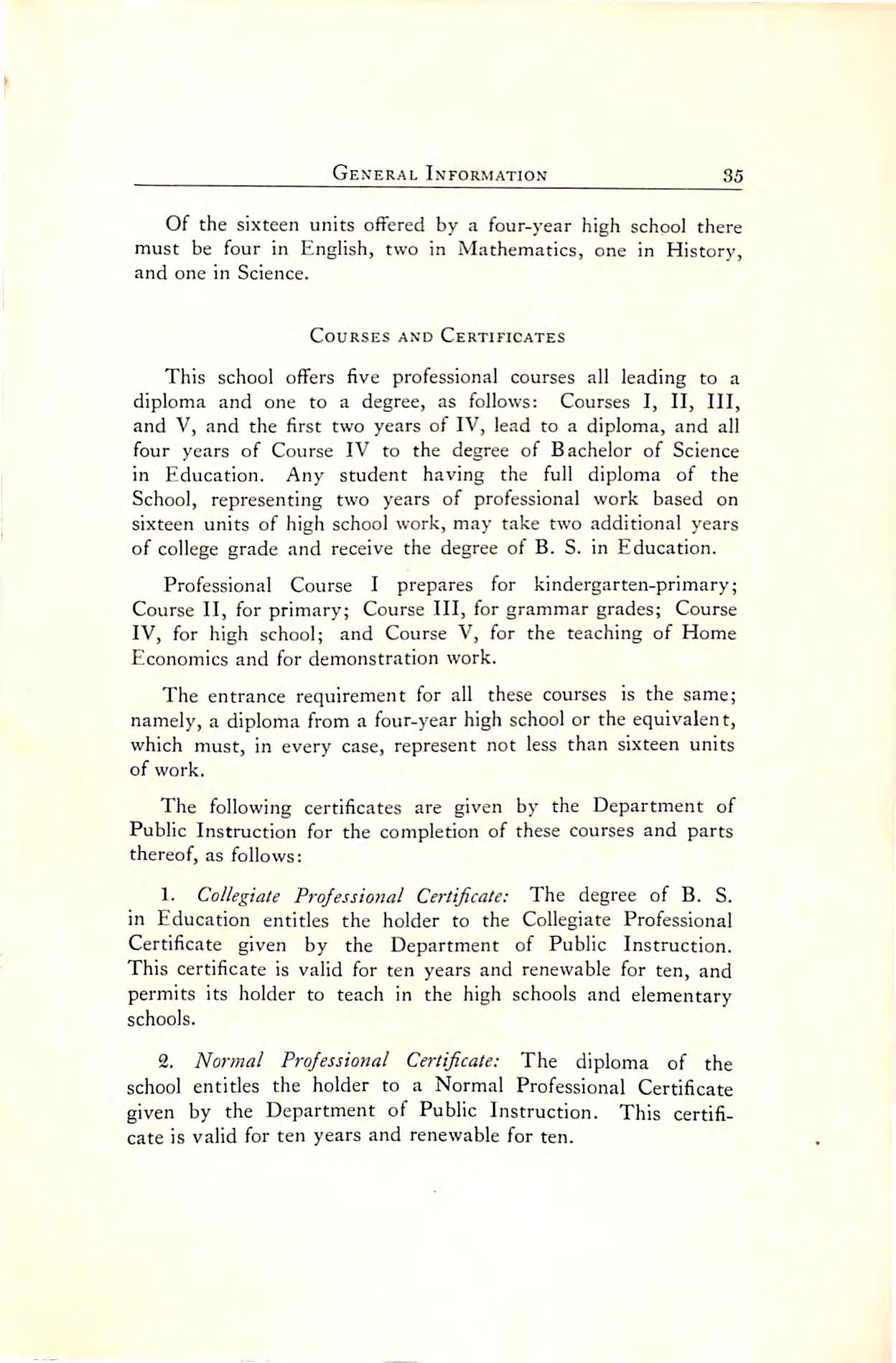
Ofthesixteen unitsoffered byafour-year highschpolthere must be four in English,twoin Mathematics,one in History, and one in Science.
CoursesandCertificates
This school offers five professional courses all leading to a diploma and one to a degree, as follows: Courses I, II, III, and V,and the first two years ofIV,lead to a diploma, and all four years of Course IV to the degree of Bachelor of Science in Education. Any student having the full diploma of the School, representing two years of professional work based on sixteen units of high school work,may take two additional years ofcollegegrade and receive thedegreeofB.S.in Education.
Professional Course I prepares for kindergarten-primary; CourseII,forprimary; CourseIII,forgrammargrades; Course IV, for high school; and Course V, for the teaching of Home Economicsandfordemonstrationwork.
The entrance requirement for all these courses is the same; namely,a diploma from a four-year high school or the equivalent, which must,in every case,represent notlessthansixteen units ofwork.
The following certificates are given by the Department of PublicInstruction forthecompletion ofthesecoursesand parts thereof, as follows:
1. Collegiate Projessional Certificate: The degree of B. S. in Education entitles the holder to the Collegiate Professional Certificate given by the Department of Public Instruction. Thiscertificateisvalidforten yearsand renewableforten,and permits its holder to teach in the high schools and elementary schools.
2. Normal Projessional Certificate: The diploma of the school entitles the holder to a Normal Professional Certificate given by the Department of Public Instruction. This certifi cate is valid for ten years and renewable for ten.
Gen^eral Information 35
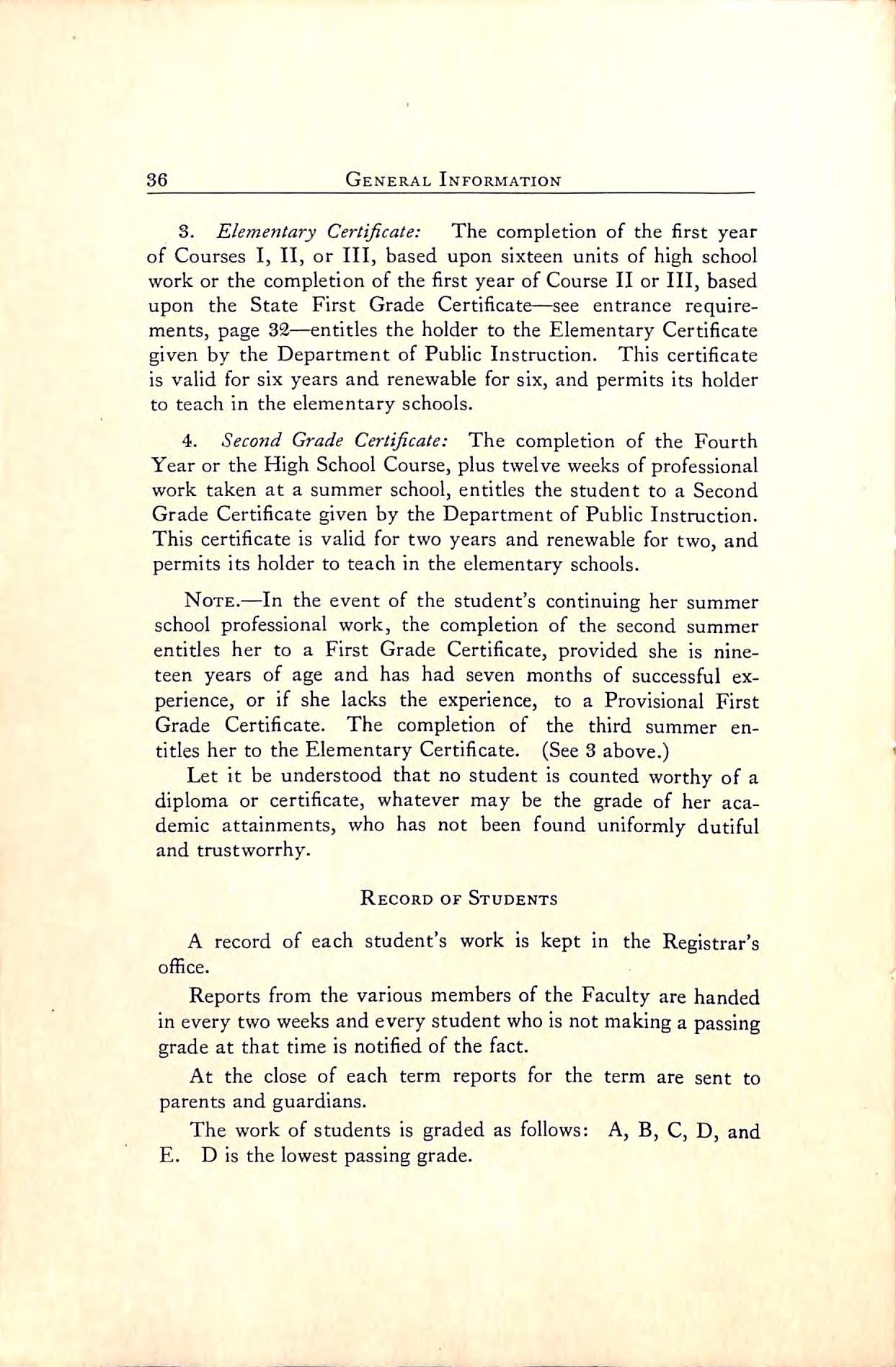
S. Elementary Certificate: The completion of the first year of Courses I, II, or III, based upon sixteen units of high school work or the completion ofthe first year ofCourse II or III,based upon the State First Grade Certificate—see entrance require ments,page32—entitlestheholdertotheElementaryCertificate given bytheDepartmentofPublicInstruction. Thiscertificate is valid for six years and renewable forsix,and permits its holder to teach in the elementary schools.
4. Second Grade Certificate: The completion of the Fourth Yearor the High School Course,plus twelve weeks ofprofessional work taken at a summer school,entitles the student to a Second Grade Certificate given by the DepartmentofPublic Instruction. Thiscertificateisvalidfortwoyearsandrenewablefortwo,and permits its holder to teach in the elementary schools.
Note.—In the event of the student's continuing her summer school professional work, the completion of the second summer entitles her to a First Grade Certificate, provided she is nine teen years of age and has had seven months of successful ex perience,or ifshe lacks the experience, to a Provisional First Grade Certificate. The completion of the third summer en titleshertotheElementaryCertificate. (See3above.)
Letitbeunderstood thatnostudentiscounted worthyofa diploma or certificate, whatever may be the grade of her aca demic attainments, who has not been found uniformly dutiful and trustworrhy.
Record of Students
A record of each student's work is kept in the Registrar's office.
ReportsfromthevariousmembersoftheFacultyarehanded ineverytwoweeksandeverystudentwhoisnotmakingapassing gradeatthattimeisnotifiedofthefact.
Atthe close ofeach term reportsfor the term are sent to parents and guardians.
Theworkofstudentsis gradedasfollows: A,B,C,D,and E. D is thelowest passing grade.
36 GeneralInformation

GeneralInformation
InstrumentalMusic
No instrumental music is taught in the School. Students desiring this work can get it at the Farmville Conservatory of Music. For catalogue giving information as to courses in both vocal and instrumental music,terms,etc., write
Miss Marie Schroeder, Head ofConservatory of Music, Farmville,Va.
^
COURSE OF STUDY
COURSE I
LeadingtoTeachinginKindergarten-Primary

Sociology1 ; Geography1orArithmetic1
SECONDYEAR
'Thenumbersinthecolumnsindicatetheperiodsper weekontheechedulc. The periodisone hour, exceptforlaboratorj^work.
Theclassisdividedintothreegroups.A,B,andC. GroupAwillteachintheFalltermoftheSecond Year;GroupBintheWinterterm,andGroupCintheSpringterm. Theapprenticeworkforeachgroup comesinthetermprecedingtheteaching,whichcausesashiftingofothersubjccla. 'MusicI.2,3,andriiysicalEducation1.2,3,onehour'screditeachterm. PhysicalEducation4,two hours'credit. 'AcertificateofproficiencyinwritingisrequiredofallstudentsenteringCourscfiI.II,andIII. Those whocannotfurnishthiscertificatemusttakeWriting1and2untilexcusedbut.rcccivonocreditforthis work. Writing3bamethodoassrequiredofailstudeuteinCoursesI,II,andIII,andreceivesfullcredit.
FIRSTYEAR Fall Term >A B C Psychology1,2 3 8 3 Introduction to Elementary Education4— 3 3 3 Games5 Kindergarten-PrimaryHandwork6 Apprentice27 English 1,2,3 3 8 8 EnglishG(ChildLiterature) NatureStudy2 Reading 1 and8 2 2 2
2Musicl,2,3 2 2 2 Drawing1,2 2 2 2 ^Writing 1,2,8 1 1 1 ^PhysicalEducation1,2,3 3 8 8 Winter Term AB C 2 2 2 3 3 3 3 8 3 2 2 k 1 1 3 3
Fall Term ABC History and Principles of KindergartenPrimaryEducation7 2 2 2 Kindergarten-PrimaryCurriculum8 8 8 8 PrimaryMethods13,14 4 4 4 ChildStudy9 .• Management10 TeachingandObservation29 8 8 SeniorReviews10 Apprentice28 3 English5.... Civics1 8 Sociology 1 Hygiene1 ^physicalEducation4 8 Scheduleperiods 171718 Credithours 171717 Winter Term AB C 8 3 8 8 8 Spring Term A BC 8 8 3 3 8 3 8 8 8 8 8 8 3 8 !! *8 2 2 2 "i i "i 8 3 8 Scheduleperiods 20 20 20 21 21 21 21 21 21 Credithours IG IG 10 171717 171717 ^ring Term ABO 2 2 2 2 2 2 8 8 2 2 2 111 8 8 3 8 8 88 3 3 1 ^11 IG 15 15 14 14 15 15 15 1414 14
COURSE II
LeadingtoTeachinginPrimaryGrades
Methods13
11
English0(Child Literature)
Reading 1
^Arithmetic2or Geography2
Sociology 1 or RuralSociology32
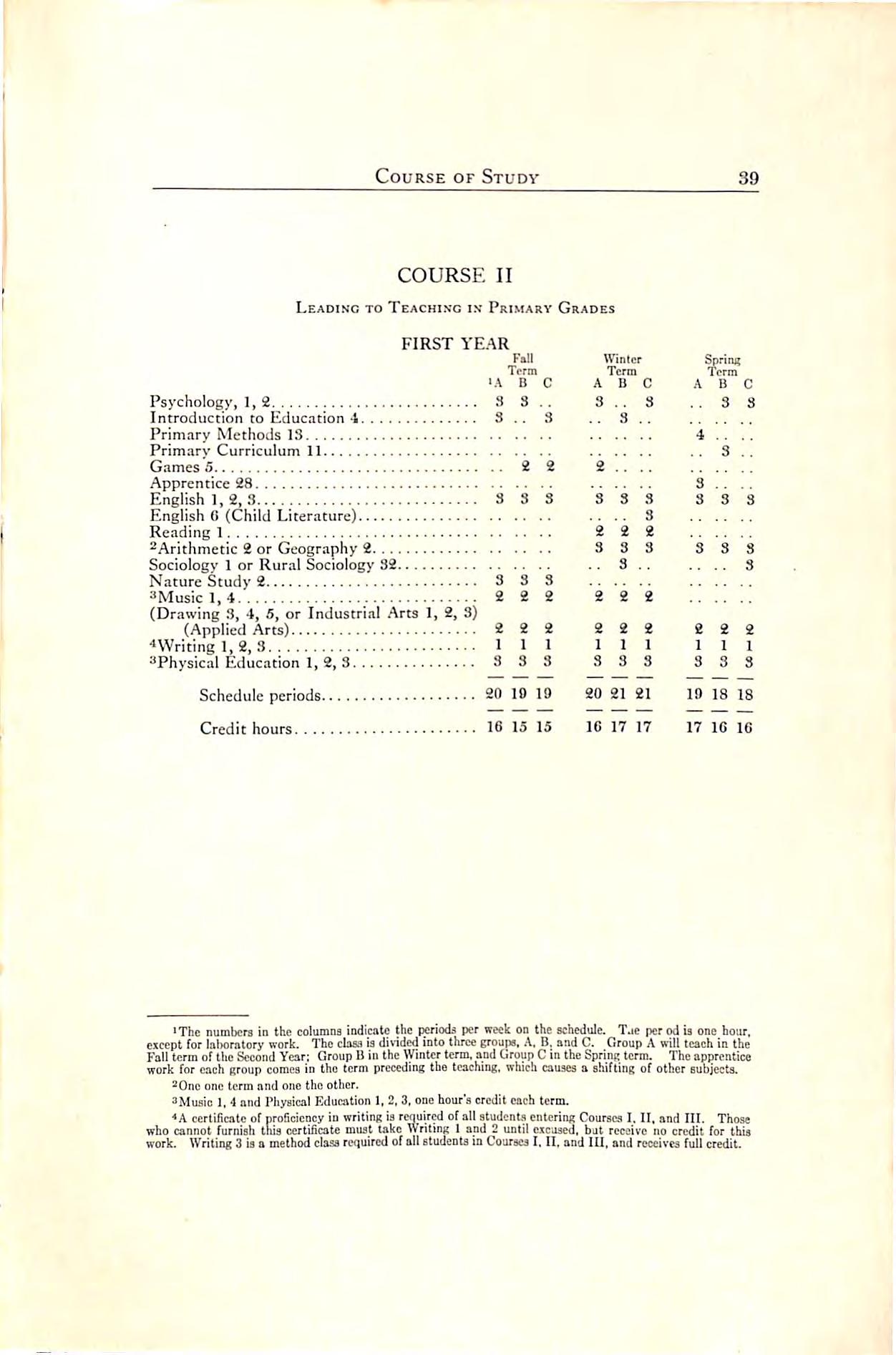
'Thenumbersinthecolumnsindicatetheperiodsperweekontheschedule. Tjcperodisonehour, exceptforloimratorywork. Theclassisdividedintothreegroups,A.B.andC. GroupA willteachinthe Falltermofthe&coticlYear;GroupBintheWntcrterm,andGroup0intheSpringterm. Theapprentice workforeachgroupcomesinthetermprecedingtheteaching,whichcausesashiftingofothersubjects. 20nconelorinandonetheother.
^Music1,4andPhysicalEducation1,2,3,onehour'screditeachterm. *Acertificateofproficiencyluwritingisrequiredofallstudcnt.sciUcrinftCoursesI.II.andIII. Those whocannotfurnishthiscertificatemustlakeWriting1and2untilexcused,butreceivenocreditforthis work. Writing3isamethodclassrequiredofallstudentsinCoursesI,II,andlU,andreceivesfullcr^t.
CourseofStudy 39
FIRSTYEAR Fall Term >A B C Psychology,1,2 S 3 .. IntroductiontoEducation4 8.. 3 Primary
PrimaryCurriculum
Games5 2 2 Apprentice28
3 3 3
English1,2,3
NatureStudy2 3 3 3 ^Music1,4 2 2 2 (Drawing3,4,5,orIndustrialArts1,2,3) (Applied Arts) 2 2 2 ^Writing1,2,3 1 1 1 ^PhysicalEducation1,2,3 3 3 3 Scheduleperiods 201019 Credithours 161515 Winter Term ABC 3 .. 3 .. 3 2 3 3 8 3 2 2 2 3 3 3 3 2 2 2 2 2 2 1 1 1 3 3 3 20 21 21 le 17 17 Sprinj? Term ABC .. 3 3 3 3 3 3 3 3 3 3 2 2 2 1 1 1 8 3 3 19 18 18 17 16 16

'Thenumbersinthecolumnsindicatetheperiodsperweekontheschedule. Theperiodisonehour, exceptforlaboratorywork. Theclassisdividedintotnrccgroups.A,B,andC. GroupA willteachin theFalltermoftheSecondYear;GroupBintheWinterterm,andGroupCintheSpringterm. Theap prenticeworkforeachgroupcomesintheternprcce^ngtheteaching,whichcausesashiftingofothersub jects.
^ThosestudentswhoelectteachingintheRuralSchoolssubetituteRuralTeachingProblems30for Primary Methods14.
^Muaic5,onehour'scredit; PhysicalEducation4,twohours'credit; PhysicalEducation5.onehour's credit.
40 Course of Study
Fall Term >A B C HistoryandPrinciplesofElementaryEdu cation21 or RuralSociologyS3 8 Primary Methods13 4 ^PrimaryMethods14orR.T.P30 S Primary Curriculum 11 Management16 Teaching and Observation 29 14 Conference30 2 Apprentice28 8 English6(ChildLiterature) 3 Civics1 3 Sociology1orRuralSociology32 Arithmetic1 3 ^Music5 2 2 Hygiene1 3 ^PhysicalEducation4,6 3 3 English5 Scheduleperiods 191817 Credithours • 1716 15 Winter Term ABC 14 2 17 19 17 15 17 15 ^ring Term ABC 3 3.. 3 14 2 3 3 3 3 3 3 1 1 16 16 19 141417
SECONDYEAR
COURSE III
LeadingtoTeachinginGrammarGrades FIRSTYEAR

Drawing6,7and8,orIndustrialArts4,5, andO
'Thenumberainthecolumnsindicatetheperiodsperweekontheschedule. Theperiodisonehour, exceptforlaboratorywork. Theclassisdividedintothreegroups,A.B,andC. GroupA willteachin theFalltermoftheSecondYear; GroupBintheWinterterm,andGroupCintheSpringterm. Theap prenticeworkforeachgroupcomesintheterra precedingtneteaching,whichcausesashiftingofothersub jects.
®Oneonetermandonetheother.
^Musio6andPhysicalEducation1,2,3,onehour'screditeachterm'AcertificateofproficiencyinwritingisrcQuircdofallstudentsenteringCoursesI,II,andIII. Those whocannotfurnishthiscertificatemusttokcWriting1and2untiltheyareexcusedbytheteacherofWriting, butreceivenocreditforthiswork. Writing3isamethodclassrequiredofailstudentsinCoursesI,II,and III,andreceivesfullcredit.
41
CourseofStudy
Fall Winter ^ring Term Term Term «ABC ABC ABO Psychology
S S S IntroductiontoEducation4 SS 8 Apprentice28 8.... English1,2,3 8 3 8 3 8 3 3 8 8 Reading1,2 22 2 222 Arithmetics 5 6 5 ^HistoryISorGeography3 6 5 5 5 5 5 Sociology1orRuralSociology32 .. 8.. ^MusicC 2 2 2
1
2 2 2 2 2 2 2 2 2 "WritingI,2,3 I l l 1 1 1 11 1 Hygiene1 .. .. 8 ^PhysicalEducationI,2,8 8 33 3 88 8 3 8
Scheduleperiods 191919 191919 191919 Credithours 1610 16 161616 15 1515

'TJienumbersinthecolumnsindicatetheperiodsperweekontheschedule.Theperiodisonehour,exceptforlaboratorywork. Theclassis^vidcdintothreegroupe.A,B,and0. GroupAwillteachinthe ralltermofthe^ondYear;GroupBintheWinterterm,andGroupCintheSpringterm.Theappren ticeworkforeachgroupcomesinthetermprecedingtheteaching,wtiicncausesasmftingofothersubjects. gtudentawhoelectTeachingintheRuralSchoolssubstituteRuralTeachingProblemsforthe LourMiniiducationthatisscheduledfortheTeachingTerraGrammarGradeMetkoda15,orGrammarGrade Lumcuium12,orManagement16.
3Murie7,8andPhysicalEducation5.one hour'screditeach term; PhysicalEducation4,twohours' crediteachterm.
42 Course of Study SECX)ND YEAR Fall Term •ABC 3 3 Psychology2orRuralSociology33 ^GrammarGradeMethods15 3 ^GrammarGradeCurriculum12 ^Management10 ^Teaching and Observation29 14 .. Conference30 2.. Apprentice27 3 English7,8 2 2 Civics1 Sociology1orRuralSociology32 3 3Music7,8 2 2 Civic Biology7 3 3 Hygiene1 ^PhysicalEducation4,5 3 3 Scheduleperiods 191616 Credithours 171414 Winter Term ABC 3 3 3 . 14 .. 2 3 3 3 3 16 19 18 14 17 16 ^riog Term ABO 3 3 3 3 8 14 2 2 2 3 3 2 2 3 3 3 3 18 18 19 16 16 17
FIRSTYEAR

SECONDYEAR
'Thenumbersinthecolumnsindicatetheperiodspervcekontheschedule. Theperiodisonehoiu' exceptforlaboratorywork.Theclassisdividedintothreegroups, B,andC.GroupAwillteachintheFalltermoftheSecondYear;GroupBintheWinterterm,andGroupCintheSpriiu^term. Theap prenticeworkforeachgroupcomeeinthetermprecedingtheteaching,whichcausesashiftingofotacrsub jects.
2TheMajors,Minors,andElcctivcsmaybechosenfromthecoursesofferedbythevariousdepartments. ThestudentisfreetochooseanyMajorforwhichshehastherec^ulrcdprerequisites. TheMinorandElectivee aresubjecttotheapjirovaloftheHeadoftheDepartmentinwluchthestudentismajoring. Theprerequisites toMajorsandMinorsinthedepartmentsrequiringprerequisitesarelistedinthesedepartments.
NOTE,—Thocompletionofthefirsttwoyearsofthiscourseentitlesthestudenttoadiploma;thecom pletionofthofouryearsentitleshertothedegreeofBachelorofScienceinEducation. ThoDiplomarepre sentsaminimumof90hours,exclusiveofPhysicalEducatioa;theDegree1B0hours,exclusiveofPhysical Education.
Course ofStudy 43
LeadingtoTeachinginHighSchool
COURSE IV
Fall Winter ^ring Tenn Term Term UBC ABC AB C Psychology1 3 3 3 Psychology3 3 3 3 HighSchoolMethodsandManagement17 3 English1,2,3 3 8 8 3 3 3 3 3 3 2Major 3 33 333 33 3 2Minor 33 8 8 33 3 8 3 Hygiene1 3 3 3 Elective 8 6 333 3 Apprentice28 3 .. .. PhysicalEducation1,2,8 3 3 3 3 3 3 3 3 3 Scheduleperiods 181818 181818 181818 Credithours 161616 161616 161616
Fall Winter ^ring Term Term Term lABC ABC ABC HighSchoolMethodsandManagement17... 3 3 IntroductiontoHighSchoolTeaching18... 3 3.. .... 3 TeachingandObservation29 8 8 8 Conference30 2.... 2.. .... 2 2Major 333 3 33 38 8 2Minor 833 3 33 333 Civics1 3 3.. .. .. 3.. Elective 3 3.. 3 0 6.. Apprentice28 8 .. .... 3 PhysicalEducation4,6 S 3 8 3 33 Scheduleperiods 191515 151917 171719 Credithours 171414 141716 161617
THIRD YEAR

FOURTHYEAR
'ThenumbcrainthecolumnaindicatethejKriodsperweekontheschedule. The'periodisonehour, exceptforlaboratorywork. Theclaseisdividedintothreegroura,A,B,andC. GroupAwillteachinthe FalltermoftheSecondYear;GroupBintheWinterterm,andGroupCintheSpringterm. Theappren ticeworkforeachgroupcomcainthetermprecedingtheteaching,whichcauscaashiftingofotheraubjecta.
^TheMajora,Minors,andElectivesmaybechosenfrom thecoursesoffered bythevariousdepartmenta. ThestudentisfreetochooseanyMajorforwhichsheliastherequiredprerequisites. TheMinorandElectives aresubjecttotheapprovaloftheHeadoftheDepartmentinwhichthestudentismajoring. Theprerequisites toMajorsandMinorsinthedepartments equiringprercquisltcaarelistedinthesedepartments.
44
Course of Study
Fall Tenn SchoolManagement20 8 History and Principles ofSecondary Edu cation22 ElectiveinEducation English10andtwoothercotirses 3 ^Major 3 Elective 0 PhysicalEducationorSupervisedRecreation 2 Scheduleperiods 17 Credithours 16 Winter Term 17 16 ^ring Term 8 3 3 6 2 17 16
Fall Winter Spring Term Term Term JABC ABC ABC TeachingandObservation29 5 5 5 5 5 5 5 5 5 Major 333 33 3 3 33 Elective 6 6 6 6 6 6 6 6 6 Conference30 1 1 1 1 1 1 1 1 1 PhysicalEducationorSupervisedRecreation 222 222 2 22 Scheduleperiods 171717 171717 171717 Credithours 15 1515 15 15 15 15 15 15
COURSE V
LeadingtoTeachingHomeEconomicsandtoDemonstrationWork
FIRSTYEAR
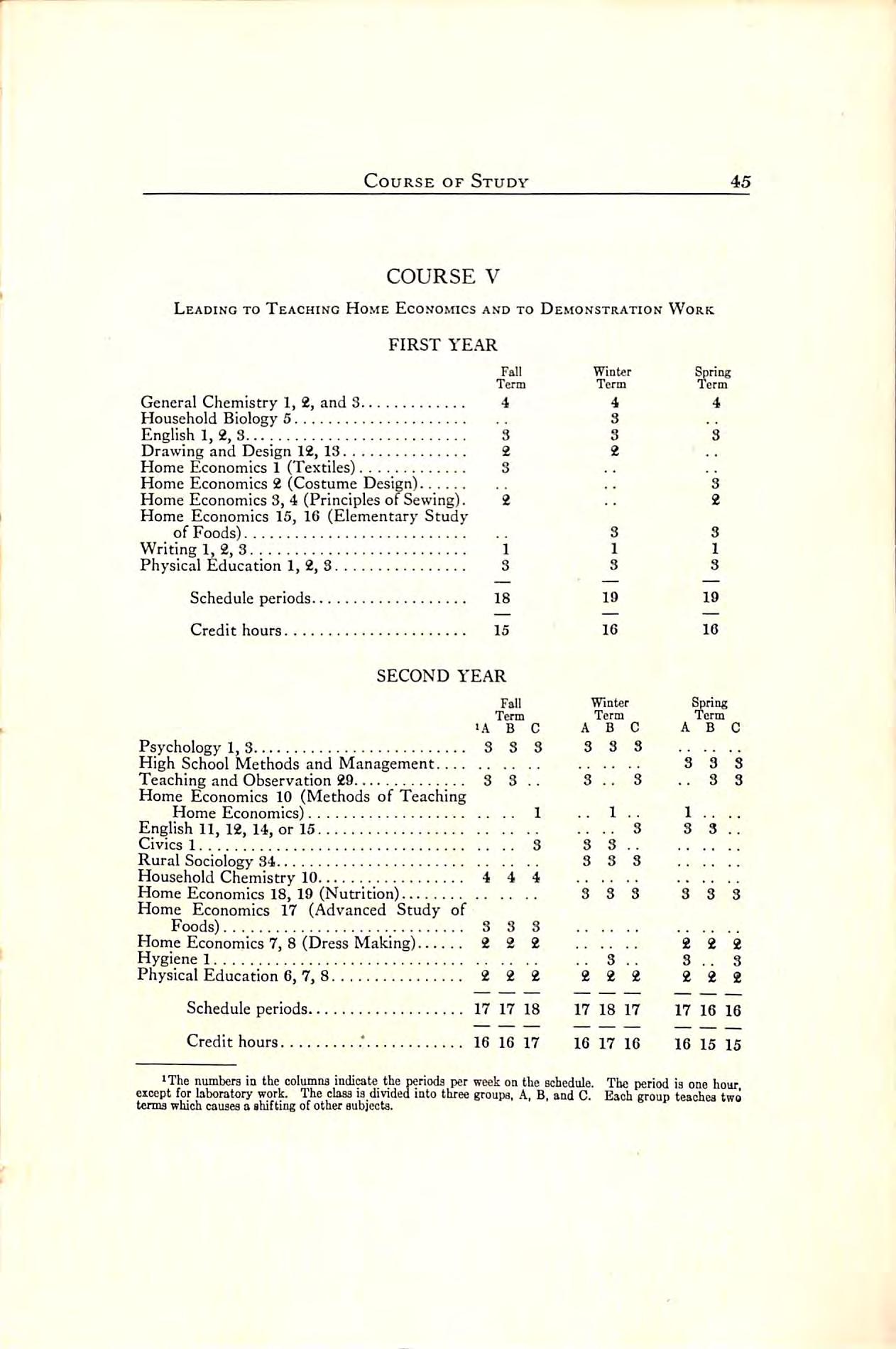
General ChemistryI,2,and3
HouseholdBiology6
English1,2,3
Drawing and Design 12,13
HomeEconomicsI(Textiles)
HomeEconomics2(Costume Design)
HomeEconomics3,4(PrinciplesofSewing).
Home Economics 15,16(Elementary Study ofFoods)
Writing1,2,3
SECONDYEAR
HomeEconomics18,19(Nutrition) Home
17(Advanced Study of
'Thenumberainthecolumnsindicatetheperiodsperweekontheschedule. Theperiodisonehour eiccptforhbomtorywork. Theckasisdividedintothreegroupe,A,B.andC. Eachgroupteachestwo termswhichcausesashiftingofotheraubjccts.
CourseofStudy 45
PhysicalEducation 1,2,S Fall Term Scheduleperiods 18 Credithours 15 Wiater Term 4 3 8 2 3 1 8 19 16 ^ring Term 3 2 3 1 3 19 16
Fall T»m •ABC Psychology1,3 3 3 3 HighSchoolMethodsandManagement TeachingandObservation29 8 3 HomeEconomics10(MethodsofTeaching HomeEconomics) 1 English11,12,14,or15 Civics1 3 RuralSociology34 HouseholdChemistry10 4 4 4
Foods) 8 8 8 HomeEconomics7,8(DressMaking) 2 2 2 Hygiene1 PhysicalEducation6,7,8 2 2 2 Scheduleperiods 171718 Credithours .* 16 16 17 Winter Term ABC 3 8 8 8 8 3. 3 8 8 S 8 3 8 2 2 2 17 18 17 16 17 16 Spno Term ing rm ABC 8 3 S S 3 1 8 8 8 3 3 *2 2 2 8 3 2 2 2 171616 161515
Economics

DEPARTMENTS OF INSTRUCTION
BIOLOGY
MR.FATTIC,MISS
STUBBS,
In this department courses are provided which will prepare students for teaching science in the grammar grades and the junior high schools. Courses are also provided for those who wish to prepare themselves for teaching science in the senior highschools,andfor those who wishsome biological work that their high school teaching in other lines may be more effective.
The two-year students who major or minor in Science will take Science 3,Science 4,and Biology 8 during their first year; and Biology 9,Biology 10, and Biology 11 during their second year.
The two-year students who major or minor in Biology will take Biology 9,Biology 10and Biology 11 during their first year; and Biology 12,Biology 13,and Biology 14 during their second year.
The four-year students who major or minor in Science or Biology are urged to take a year of chemistry and a year of Physics,or two years ofChemistry.
Additional courses will beofferedforThirdand Fourth-year students,ifa sufficient number ask for them.
Hygiene 1. Three periods a week, two single, one double. Offered every term. Credit, three hours. This course will follow veryclosely the outline prepared by the State Board of Health. It will include (a) Physical defects and their con trol; astudy ofthe eye,its testing,causesofeye-strain,etc.; ear^ testing,symptoms and causes of deafness; teeth^ inspec tion,causesofdecay,care,etc.;throatyinspection,etc.; nutrition, weight and measure, symptoms and'causes of malnutrition; (b)Personal hygiene; (c) Contagious diseases and their control; (d) Community health; (e) Sanitation and care of the school plant. RequiredinallCourses. 'Tobesupplied.
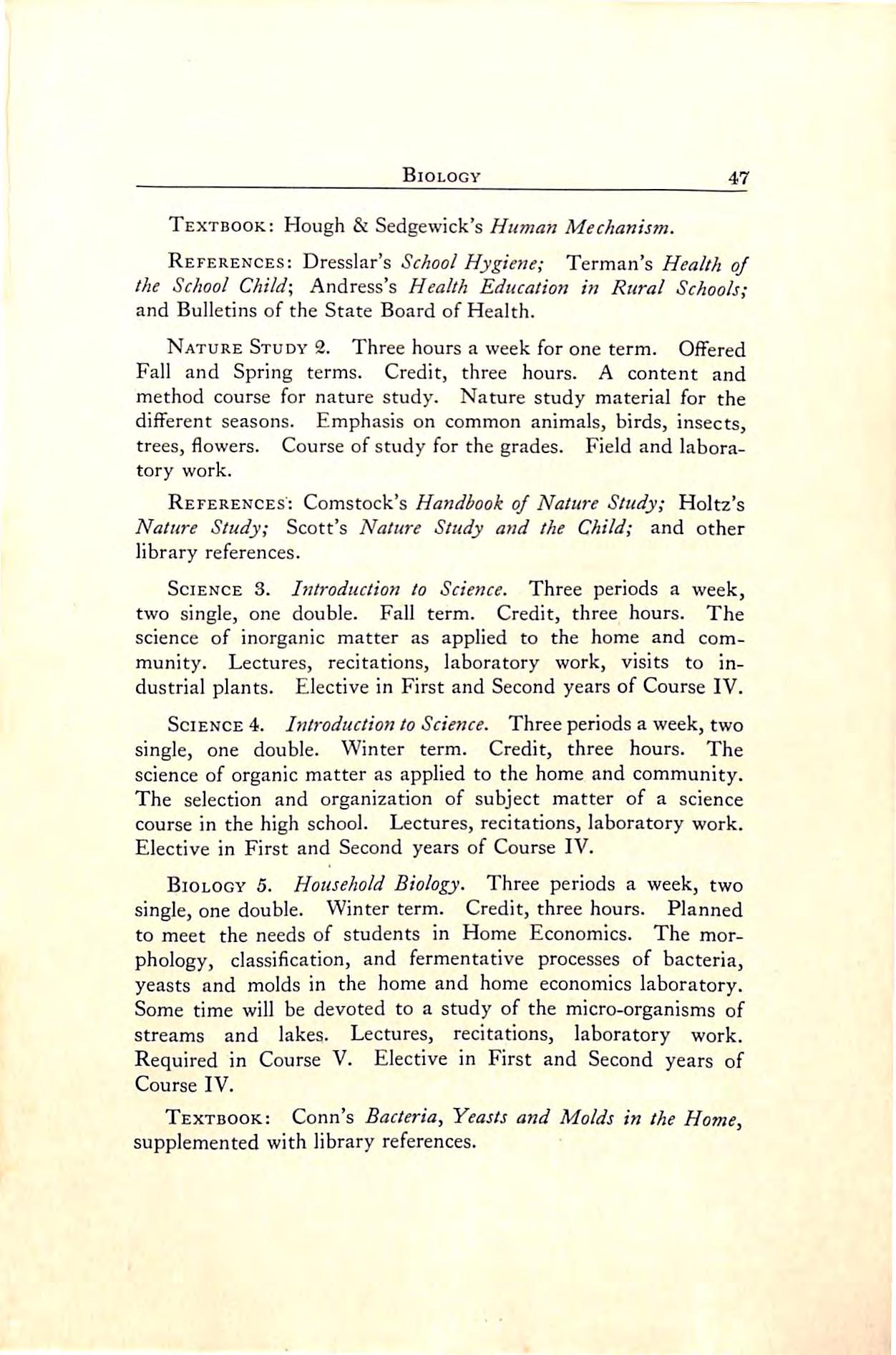
Biology
Textbook:Hough&Sedgewick'sHumanMechanism.
References: Dresslar's School Hygiene; Terman's Health oj the SchoolChild\ Andress's Health Education in RuralSchools; andBulletinsoftheStateBoardofHealth.
Nature Study 2. Three hours a week for one term. Offered Fall and Spring terms. Credit, three hours. A content and method course for nature study. Nature study material for the differentseasons. Emphasisoncommon animals,birds,insects, trees,flowers. Course ofstudy for the grades. Field and labora tory work.
References':Comstock'sHandbookofNatureStudy; Holtz's Nature Study; Scott's Nature Study and the Child; and other library references.
Science 3. Introduction to Science. Three periods a week, two single, one double. Fall term. Credit, three hours. The science of inorganic matter as applied to the home and com munity. Lectures, recitations, laboratory work, visits to in dustrialplants. ElectiveinFirstandSecond yearsofCourseIV.
Science4. IntroductiontoScience. Threeperiodsa week,two single, one double. Winter term. Credit, three hours. The scienceoforganicmatterasappliedtothehomeandcommunity. The selection and organization of subject matter of a science course in the high school. Lectures,recitations,laboratory work. Elective in First and Second years of Course IV.
Biology 5. Household Biology. Three periods a week, two single,onedouble. Winterterm. Credit,threehours. Planned to meet the needs of students in Home Economics. The mor phology, classification, and fermentative processes of bacteria, yeasts and molds in the home and home economics laboratory. Sometime will bedevoted toastudyofthe micro-organismsof streams and lakes. Lectures, recitations, laboratory work. Required in Course V. Elective in First and Second years of CourseIV.
Textbook: Conn's Bacteria^ Yeasts and Molds in the Home^ supplemented with library references.
47
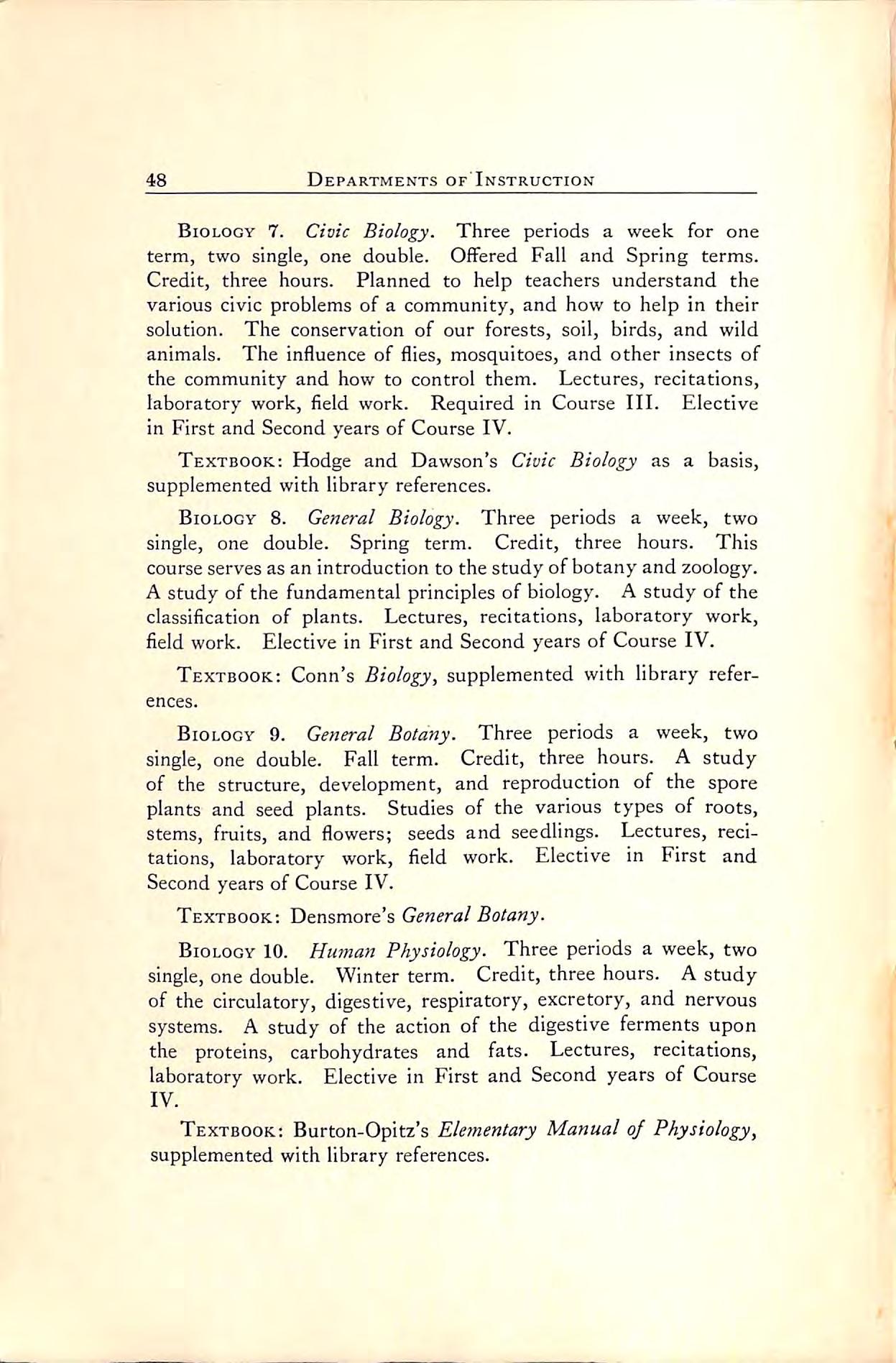
Biology 7. Civic Biology. Three periods a week for one term, two single, one double. Offered Fall and Spring terms. Credit, three hours. Planned to help teachers understand the various civic problems ofa community,and how to help in their solution. The conservation of our forests, soil, birds, and wild animals. The influence of flies, mosquitoes, and other insects of the community and how to control them. Lectures, recitations, laboratory work,field work. Required in Course III. Elective in First and Second years of Course IV.
Textbook: Hodge and Dawson's Civic Biology as a basis, supplemented with library references.
Biology 8. General Biology. Three periods a week, two single, one double. Spring term. Credit, three hours. This courseservesasan introduction to thestudyofbotanyandzoology. Astudyofthefundamentalprinciplesofbiology. Astudyofthe classification of plants. Lectures,recitations,laboratory work, field work. Elective in First and Second years ofCourse IV.
Textbook:Conn'sBiology.,supplemented with library refer ences.
Biology 9. General Botany. Three periods a week, two single, one double. Fall term. Credit, three hours. A study of the structure, development, and reproduction of the spore plants and seed plants. Studies of the various types of roots, stems, fruits, and flowers; seeds and seedlings. Lectures, reci tations, laboratory work, field work. Elective in First and Second years ofCourseIV.
Textbook: Densmore's General Botany.
Biology 10. Human Physiology. Three periods a week,two single,one double. Winter term. Credit,three hours. A study of the circulatory,digestive, respiratory, excretory, and nervous systems. A study of the action of the digestive ferments upon the proteins, carbohydrates and fats. Lectures, recitations, laboratory work. Elective in First and Second years of Course IV.
Textbook:Burton-Opitz's Elementary ManualofPhysiology, supplemented with library references.
48 Departments of'Instruction
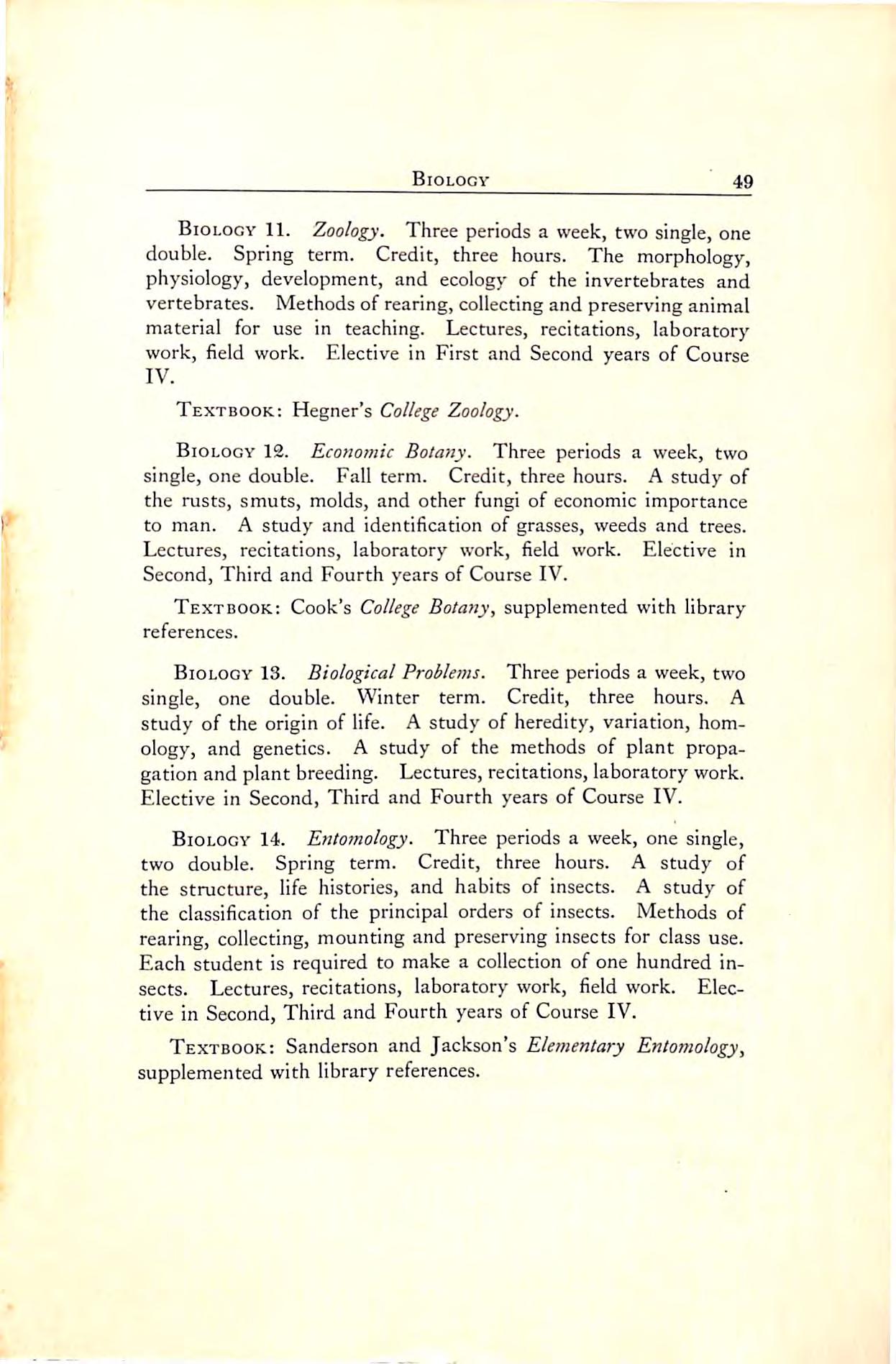
Biology 11. Zoology. Three periodsa week,twosingle,one double. Spring term. Credit, three hours. The morphology, physiology,development,and ecology oftheinvertebrates and vertebrates. Methodsofrearing,collectingandpreservinganimal material for use in teaching. Lectures, recitations, laboratory work,field work. Electivein FirstandSecond yearsofCourse IV.
Textbook: Hegner's College Zoology.
Biology 12. Economic Botany. Three periods a week, two single,onedouble. Fallterm. Credit,threehours. Astudyof the rusts,smuts, molds,and other fungi ofeconomic importance to man. A study and identification of grasses, weeds and trees. Lectures, recitations, laboratory work, field work. Elective in Second,Third and Fourth years ofCourse IV.
Textbook: Cook's College Botany^ supplemented with library references.
Biology13. BiologicalProblems. Threeperiodsaweek,two single, one double. Winter term. Credit, three hours. A studyoftheoriginoflife. Astudyofheredity,variation,homology,and genetics. A study ofthe methods of plant propa gationandplantbreeding. Lectures,recitations,laboratorywork. Elective in Second,Third and Fourth years ofCourse IV.
Biology 14. Entomology. Three periods a week,one single, two double. Spring term. Credit, three hours. A study of the structure,life histories,and habits ofinsects. A study of the classification of the principal orders of insects. Methods of rearing,collecting,mounting and preserving insectsfor class use. Eachstudentisrequiredtomakeacollectionofonehundredin sects. Lectures,recitations,laboratorywork,fieldwork. Elec tiveinSecond,ThirdandFourthyearsofCourseIV.
Textbook:Sanderson and Jackson'sEletnentary Entomology^ supplemented with libraryreferences.
Biology 49
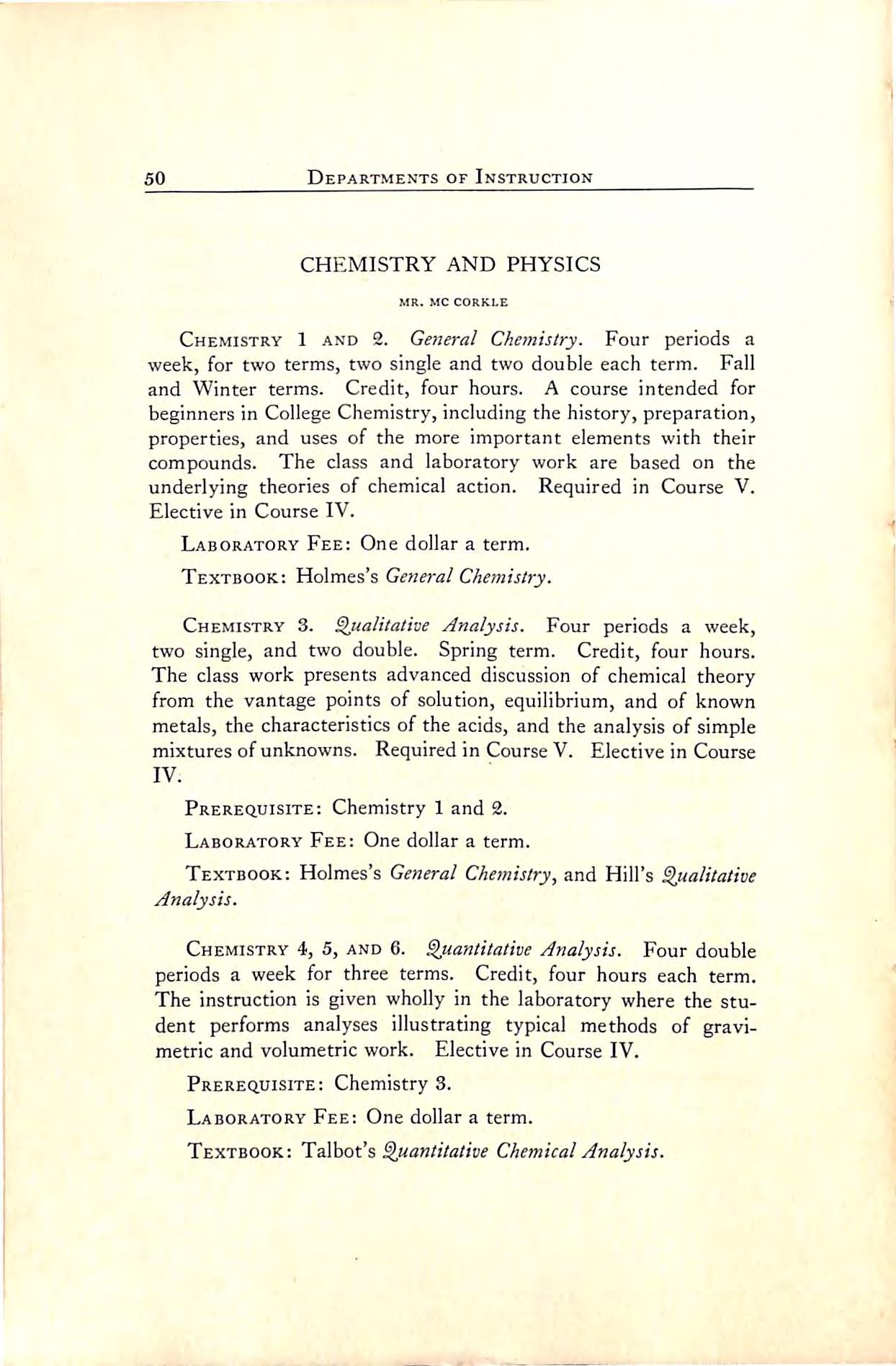
CHEMISTRY AND PHYSICS
MR. MC CORKLE
Chemistry 1 and 2. General Chemistry. Four periods a week,fortwoterms,twosingleandtwodoubleeach term. Fall and Winter terms. Credit, four hours. A course intended for beginnersin College Chemistry,including the history,preparation, properties,and usesofthe moreimportantelements with their compounds. The class and laboratory work are based on the underlying theoriesofchemical action. Required in Course V. ElectiveinCourseIV.
LaboratoryFee:Onedollaraterm.
Textbook: Holmes's GeneralChemistry.
Chemistry 3. Qualitative Analysis. Four periods a week, twosingle,and two double. Spring term. Credit,four hours. Theclass work presentsadvanceddiscussion ofchemicaltheory from the vantage pointsofsolution,equilibrium,and ofknown metals,the characteristicsofthe acids,and the analysisofsimple mixturesofunknowns. Required in Course V. Elective in Course IV.
Prerequisite; Chemistry 1 and 2.
LaboratoryFee:Onedollaraterm.
Textbook;Holmes's General Chemistry,and Hill's Qualitative Analysis.
Chemistry4,5,and6. QuantitativeAnalysis. Fourdouble periods a week for three terms. Credit,four hourseach term. Theinstruction isgiven whollyin thelaboratory wherethestu dent performs analyses illustrating typical methods of gravi metricandvolumetricwork. ElectiveinCourseIV.
Prerequisite:Chemistry3.
LaboratoryFee:Onedollaraterm.
Textbook: Talbot'sQuantitative ChemicalAnalysis.
50 DepartmentsofInstruction
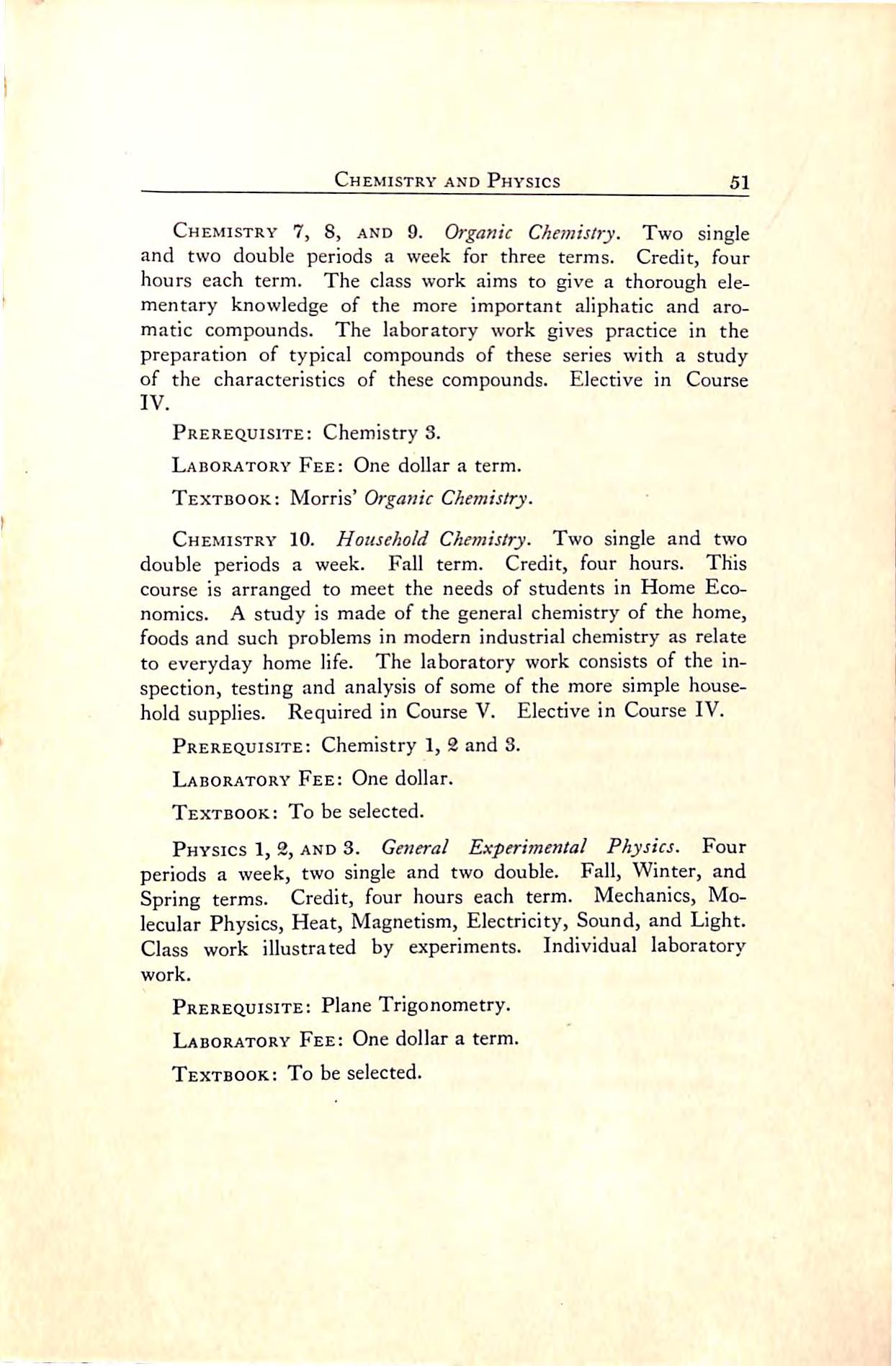
Chemistry and Physics
Chemistry 7, 8, and 9. Organic Chemistry. Two single and two double periods a week for three terms. Credit,four hourseach term. Theclass work aimstogivea thorough ele mentary knowledge of the more important aliphatic and aro matic compounds. The laboratory work gives practice in the preparation oftypical compounds ofthese series with astudy of the characteristics of these compounds. Elective in Course IV.
Prerequisite: Chemistry 3.
LaboratoryFee:Onedollaraterm.
Textbook: Morris'Organic Chemistry.
Chemistry 10. Household Chemistry. Two single and two double periods a week. Fall term. Credit,four hours. This courseisarranged to meetthe needsofstudentsin HomeEco nomics. Astudyismadeofthegeneralchemistryofthehome, foodsandsuch problemsinmodernindustrialchemistryasrelate to everyday home life. The laboratory work consists of the in spection,testing and analysis ofsome ofthe more simple house hold supplies. Required in Course V. Electivein Course IV.
Prerequisite: Chemistry 1,2and 3.
Laboratory Fee: One dollar.
Textbook:Tobeselected.
Physics1,2,and3. General Experimental Physics. Four periods a week,two single and two double. Fall, Winter, and Spring terms. Credit, four hours each term. Mechanics, Mo lecular Physics,Heat,Magnetism,Electricity,Sound,and Light. Class work illustrated by experiments. Individual laboratory work.
Prerequisite:PlaneTrigonometry.
Laboratory Fee: One dollar a term.
Textbook: To be selected.
51
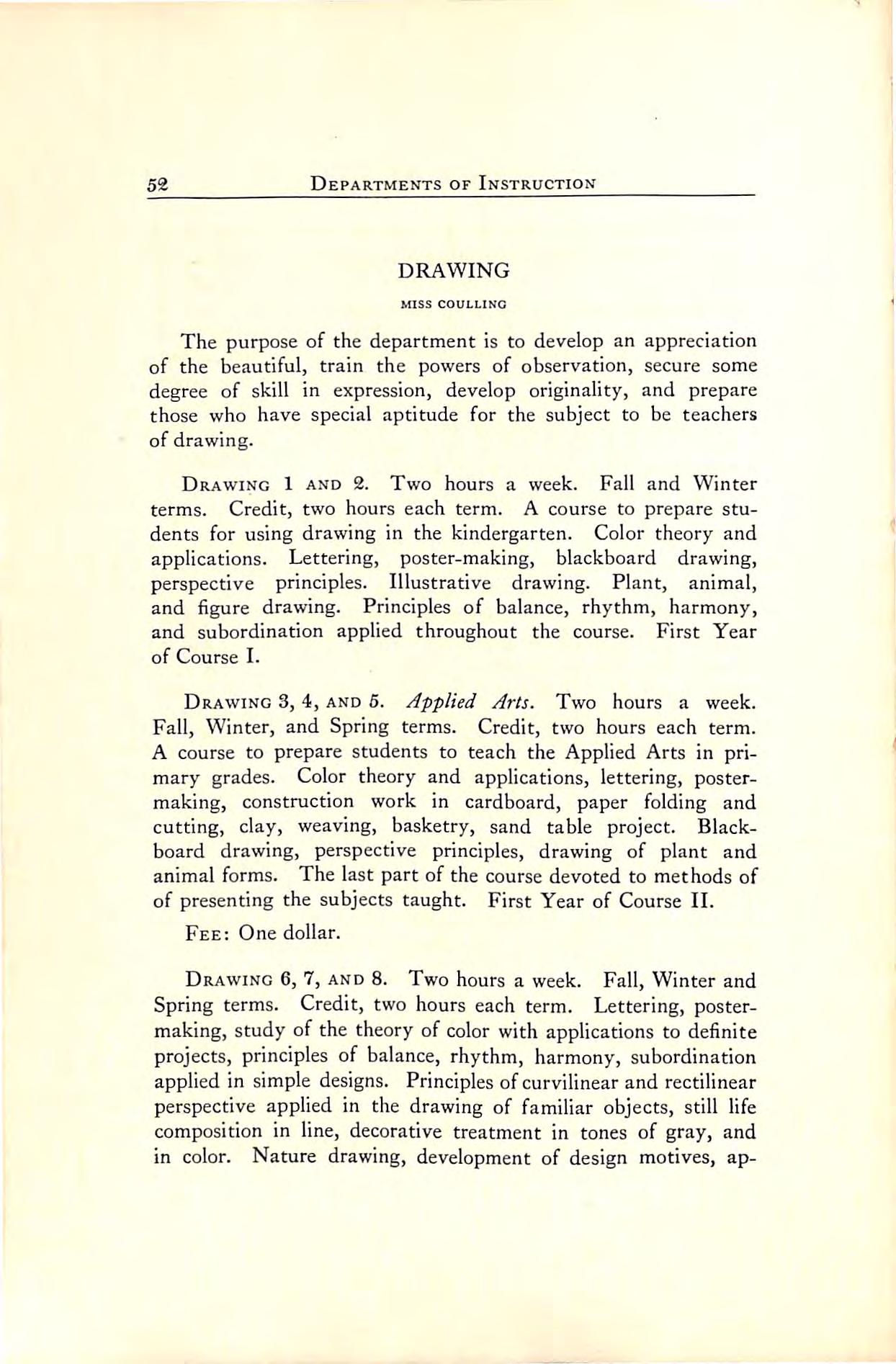
DRAWING
MISS COl;LLI^fO
Thepurposeofthedepartmentistodevelop an appreciation of the beautiful, train the powers of observation, secure some degree of skill in expression, develop originality, and prepare those who have special aptitude for the subject to be teachers ofdrawing.
Drawing 1 and 2. Two hours a week. Fall and Winter terms. Credit, two hours each term. A course to prepare stu dents for using drawing in the kindergarten. Color theory and applications. Lettering, poster-making, blackboard drawing, perspective principles. Illustrative drawing. Plant, animal, and figure drawing. Principles of balance, rhythm, harmony, and subordination applied throughout the course. First Year ofCourseI.
Drawing 3,4,and 6. Applied Arts. Two hours a week. Fall,Winter,and Spring terms. Credit,two hourseach term. A course to preparestudents to teach the Applied Arts in pri mary grades. Color theory and applications,lettering, postermaking, construction work in cardboard, paper folding and cutting, clay, weaving, basketry, sand table project. Black board drawing, perspective principles, drawing of plant and animalforms. The last partofthe course devoted to methodsof ofpresentingthesubjectstaught. FirstYearofCourseII.
Fee:Onedollar.
Drawing6,7,and8. Twohoursaweek. Fall,Winterand Spring terms. Credit, two hours each term. Lettering, postermaking, study of the theory of color with applications to definite projects, principles of balance, rhythm, harmony,subordination appliedinsimpledesigns. Principlesofcurvilinearandrectilinear perspective applied in thedrawingoffamiliar objects,still life composition in line,decorative treatmentin tonesofgray,and in color. Nature drawing,developmentofdesign motives,ap-
52 DepartmentsofInstruction

Drawing ^
plication indecorativespot,border,surface. Lasttermgiven to a course in methods for grammar grade teachers. First Year of CourseIII.
Textbook:HowChildrenLeamtoDraw.
Drawing 9,10,and 11. Three periods a week,two double, one single, for three terms. Fall, Winter, and Spring terms. Credit,three hours each term. An elective coursefor those having specialaptitudefordrawingandwishingtoteachit. Thecourse is similar to Courses 6 and 7 in content but more advanced. Electivein FirstandSecondYearsofCourseIV.
Drawing 12 and 13. Drawing and Design. Two double periods a week. Fall and Winter terms. Credit, two hours each term. Lettering and poster-making. Color theory with applications to be used in costume design and interior decora tion. Design theory with applications. Perspective principles, still lifecomposition,landscape composition. Requiredin First YearofCourseV.
Drawing 14. Art Appreciation. Three periods a week. Spring Term. Credit,three hours. Elective Third and Fourth YearsofCourseIV.
Textbook: Reinach's Apollo\ Library reference texts and pictures.

'DEPARTMENT OF EDUCATION
DR.TIDYMAN,MR.BELL,-^MR.
FAITHFULL,MR.LEE,MISS STUBBS,MISS JONES,MISS EDWARDS,MISS BIERBOWER,MISS CAMPER
Preparation for teaching is regarded as a gradual growth in the understanding and the control of the various elements that enterinto the teaching processes. The basis for understanding the teaching processes is the student's own experience as a learner. The facts oflearning obtained through introspection, andfurtherthrough theobservationofchildren,areinterpreted andsystematized in theintroductory psychology courses. Un derstandingis furthered,andsome controlofthe teaching pro cesses is developed through participation in the work of the Training School. This participation begins with coaching in dividualsandsmallgroupsofchildren,andassistingtheregular teacher; anditculminatesin takingcompletechargeofaclass or a section for a considerable part ofits work.
In general the academic work serves to interpret,evaluate, and organize the student's concrete experience; and,apart from the introductory psychology courses, it is organized around what are regarded as the five main problems of teaching, as follows; (1)determination ofaimsand values,(2)selection and organi zation of material, (3) presentation of material, (4) class and school management,and(5)extra school activities. The first courseor group ofcoursesserves to acquaintthe teacher with the fundamental processesofeducation,and the place and the function of education in a democratic society; the second shows the application of these aims to the selection and organization of material; the third familiarizes the teacher with the accepted methodsanddevicesforhandling material; thefourthgivesher some insight into the methods of class management and school administration; and the fifth shows her the value of making the school a vital force in the life of the community, and how this may be done.
'TheSupervisorsoftheTraioiiigSchoolarememberaoftheDepartmeatofEducation. SQiileaveofaheeoce.
54 DepartmentsofInstruction

Inorderthatthe workoftheDepartmentofEducation may be adapted to the needs ofstudents entering various depart ments of public school service, differentiated courses and spe-cialized courses are offered in four fields: namely, kindergarten, primary grades,grammar grades,and high school. The work ofthe primary and grammargrades is further differentiated to meet the needs of students preparing for teaching in the city and in the country.
ThecoursesofferedintheDepartmentareasfollows:
ElementaryEducationalPsychology1. Threehoursa week for one term. Offered Fall and Winter terms. Credit, three hours. The general facts and laws of human behavior, with especial reference to the principles that have a bearing upon the modes of learning and teaching. Characteristics of pupils in the several grade groups,teaching problems,personal qualities that make for success, vocational opportunities, and professional advantages considered. Class discussion, experi ments in learning, and some observation of the work in the TrainingSchool. Requiredofallstudents.
Textbook:ColvinandBagleysHumanBehavior.
Educational Psychology 2. Three hours a week for one term. Offered Winter and Spring terms. Credit,three hours. The phenomena of child nature,its development and control. Main topics: instincts—their nature, function, and control; habits; sense activities; memory and thinking in children; in dividualdifferences. RequiredinCoursesI,II,andIII.
Textbook:Norsworthy and Whitley's The Psychology of Childhood.
EducationalPsychology3. Threehoursaweek. Winter term. Credit,threehours. Apreliminarysurveyoftheperiods of life and their ruling tendencies; the characteristics, needs, and treatment of adolescent nature, physical,intellectual, es thetic,moral,and religious; the psychologyoflearning,includ ing self-activity, interests, habit-formation, individual differ ences asdetermined by heredity,sex,and environment,mental fatigue,mental hygiene.
Education 55
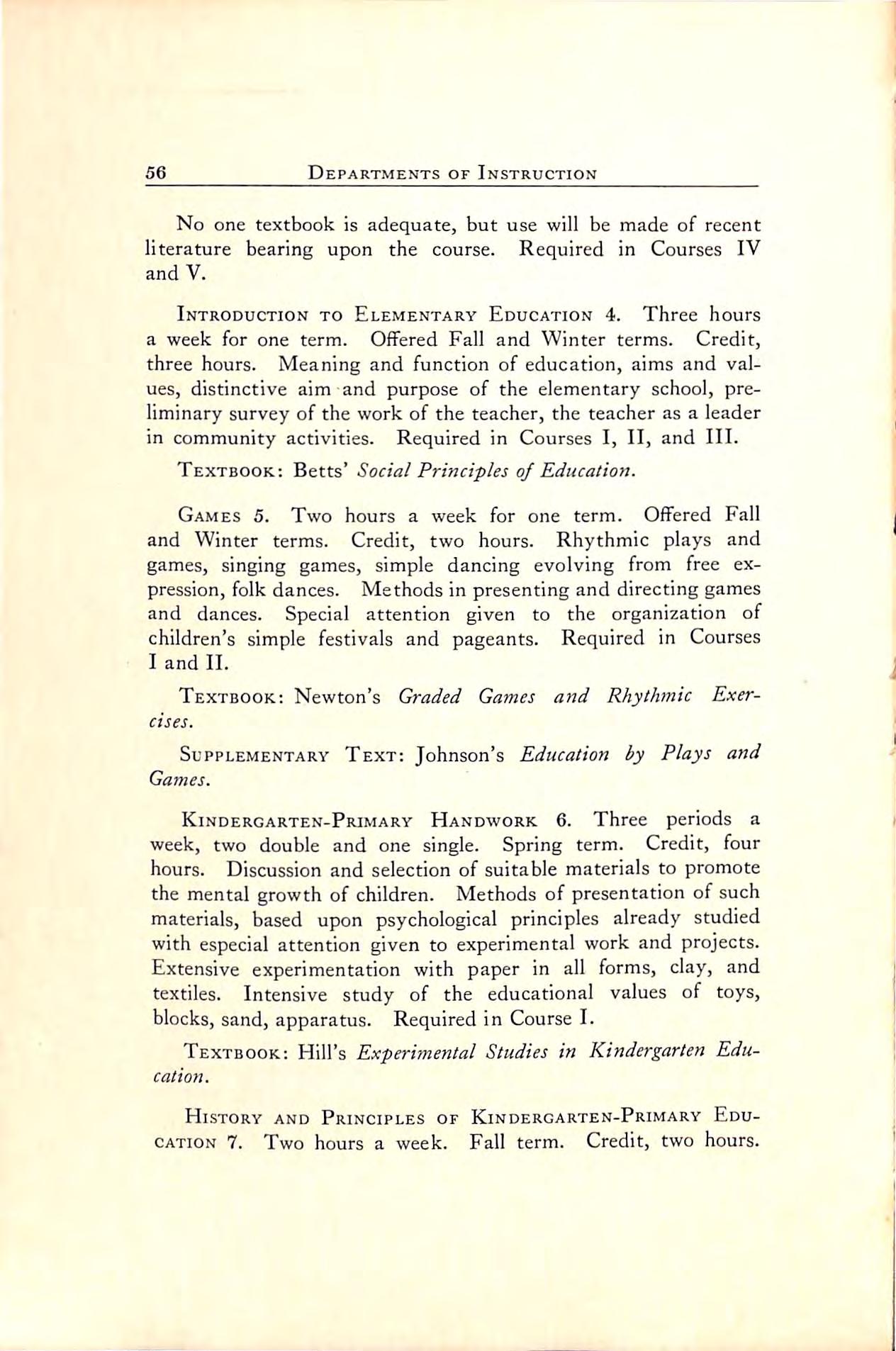
No one textbook is adequate,but use will be made of recent literature bearing upon the course. Required in Courses IV andV.
Introduction to Elementary Education 4. Three hours a week for one term. Offered Fall and Winter terms. Credit, threehours. Meaningandfunction ofeducation,aimsand val ues, distinctive aim and purpose of the elementary school, pre liminarysurveyoftheworkoftheteacher,theteacherasaleader incommunity activities. Required in CoursesI,II,and III.
Textbook: Betts'SocialPrinciples ofEducation.
Games5. Two hoursa weekforone term. Offered Fall and Winter terms. Credit, two hours. Rhythmic plays and games, singing games, simple dancing evolving from free ex pression,folkdances. Methodsinpresentinganddirectinggames and dances. Special attention given to the organization of children's simple festivals and pageants. Required in Courses IandII.
Textbook:Newton's Graded Games and Rhythmic Exercises.
Supplementary Text: Johnson's Education by Plays and Games.
Kindergarten-Primary Handwork 6. Three periods a week, two double and one single. Spring term. Credit, four hours. Discussion and selection ofsuitable materials to promote the mental growth ofchildren. Methods ofpresentation ofsuch materials, based upon psychological principles already studied with especial attention given to experimental work and projects. Extensive experimentation with paper in all forms, clay, and textiles. Intensive study of the educational values of toys, blocks,sand,apparatus. Requiredin CourseI.
Textbook:Hill's Experimental Studies in Kindergarten Edu cation.
History and Principles of Kindergarten-Primary Edu cation 7. Two hours a week. Fall term. Credit, two hours.
56
DepartmentsofInstruction

Course supplying background for other courses in education. Special attention given to educational principles of Locke,Rous seau, Froebel, and Montessori. History and development of kindergartens and primary schools in America. Comparison of theories of Froebel and Montessori and those endorsed by progressive American educators. Required in Course I.
References: Parker's History of Modern Elementary Edu cation; Vandewalker's Kindergarten in American Education; Montessori's Montessori Method; Kilpatrick's Montessori Sys tem Examined; Hill and Blow's The Kindergarten.
Kindergarten-Primary Curriculum 8. Three hours a week. Fall term. Credit, three hours. Origin of kindergarten and primary schools, contrasting original differences in aim with present-day unity ofpurpose. Needsofchildren as basis forpresent-daykindergarten-primarycurriculum. Criticalstudy ofsubjectscomposingtypicalcoursesofstudyinlightofchildren's physical and psychological requirements. Evaluation and cor relationofsuchsubjects. RequiredinCourseI.
Textbook: Government Bulletin on the Kindergarten.
Supplementary Textbooks: Dewey's The Child and The Curriculumy Dewey'sSchoolandSociety. Library references.
Child Study 9. Two hours a week. Spring term. Credit, two hours. Relation of society to childhood. Prenatal life of child. Care of infants. Mental and physical characteristics ofchildrenfrom infancyup toadolescence butnotincludingit. Courseespecially adaptedto needsofstudentswho willconduct Mothers' Meetings in connection with kindergarten and lower grade work. Required in Course I.
Textbooks: Tanner's The Childy and Government Bulle tins.
Senior Reviews 10. Two hours a week. Spring term. Credit,twohours. Asystematicand practicalreviewofcourses in games,handwork,literature,and music,and designed to corre late and supplement these courses. Survey of all available
Education ^

58 Departments ofInstruction"
source material upon songs, games, and dances, and literature for children. The acquainting of students with actual situa tions existingin the State. Required in Course I.
PrimaryCurriculum11. Threehoursaweekforoneterm. Offeredevery term. Credit,three hours. Theorigin,function, and contentofthe curriculum. The experience,abilities,inter est,and social activities ofchildren as basic ideas determining content. The project as a method ofvitalizing and organizing subject matter. Tentative courses in fundamental school sub jectsconsideredcritically. RequiredinCourseII.
Textbook: Bonser's The Elementary School Curriculum.
Grammar Grade Curriculum 12. Three hours a week. Spring term. Credit,three hours. Significance ofthe curricu lum,value ofsubjects,general principles controlling the selec tion of material, results and tendencies in the reorganization of the several subjects,scientific methods of curriculum making. Required in Course III.
Textbooks:Bonser's The Elementary School Curriculum; Moore'sMinimumEssentials.
Primary Methods 13. Four hours a week for one term. Offered every term. Credit,four hours. Principles and meth ods of teaching Arithmetic and Writing (for lower Primary only) and Spelling. The latter half of the course given to a consideration of the principles of General Method and develop mentofthemaintypesofteaching.
PrimaryMethods14. Threehoursaweekforoneterm. Credit,three hours. Principlesand methodsinvolvedin teach ing Reading and Language, special emphasis being given to beginningreading.
GrammarGradeMethods15. Threehoursaweek. Fall term. Credit, three hours. Principles, methods, and devices of teaching the grammar grade subjects. Special emphasis placed upon subjects receiving least attention in the special methods courses. Fundamental principles of methods and

types of procedure developed from the study and comparison of similar subjects,such as the instrumental subjects. Required inCourseIII.
Textbook: Earhart's Types of Teaching.
Management 16. Two hours a week in Course I. Spring term. Credit,two hours. Three hoursa week forone term in Courses II and III. Offered every term. Credit, three hours. Organization of school routine; discipline; lesson planning; testing; common school laws and regulations; records and re ports; state and local organization; school support; teacher's relation to the superintendent, principal, board, and patrons; professionalethics. Requiredin CoursesI,II,andIII
Textbook: Sears' Classroom Organization and Control. Fee,Fifty cents.
High School Methodsand Management 17. Three hours a week for one term. Offered every term. Credit, four hours. Typesofteachingin the high school subjects,forming associa tions and habits,reflective thinking,problem solving,apprecia tion,questioning,supervised study, lesson planning, measuring the results of instruction, organizing class routine, discipline, common school laws and regulations. State and local educational organization,records and reports. Required in Course IV.
Textbooks:Colvin's An hitroduction to High School Teach ing; Earhart's Types of Teaching.
IntroductiontoHighSchoolTeaching18. Threehours a week for one term. Offered every term. Credit, three hours. Meaningandfunction ofeducation,aimsand values,distinctive purpose and place of the high school, the work of the teacher, community activities, the high school curriculum, values of subjects, scientific methods in curriculum making, arrangement of courses and subjects. Required in Course IV.
Textbook: Stout's The High School. MethodsandManagement19. Threehoursaweek. Spring term. Credit, three hours. Meaning and purpose of edu-
•
Education ^
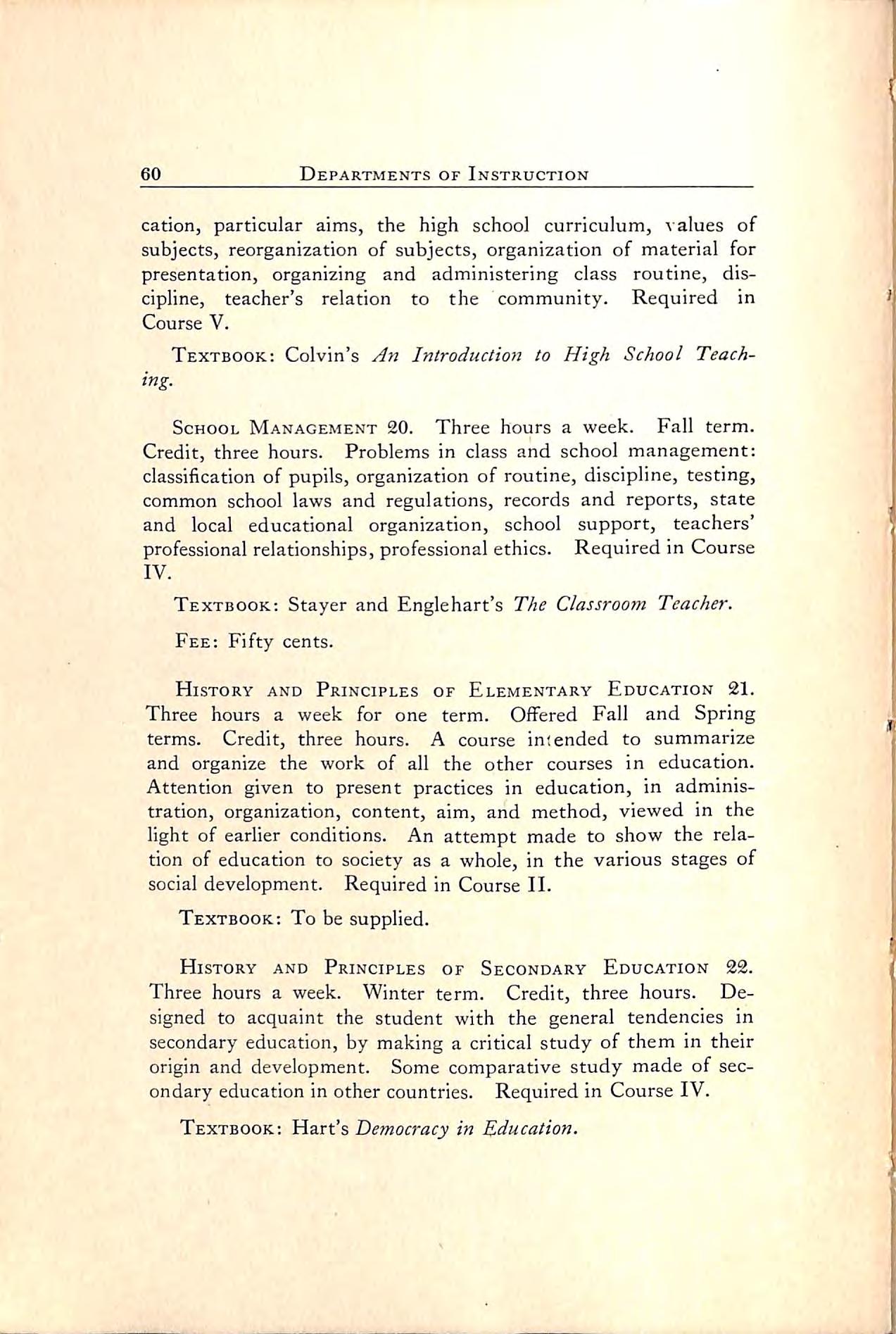
cation, particular aims,the high school curriculum, values of subjects,reorganization ofsubjects,organization ofmaterial for presentation, organizing and administering class routine, dis cipline, teacher's relation to the community. Required in CourseV.
Textbook: Colvin's An Introduction to High School Teach ing.
School Management 20. Three hours a week. Fall term. Credit,three hours. Problems in class and school management: classification ofpupils,organization ofroutine,discipline,testing, common school laws and regulations, records and reports, state and local educational organization, school support, teachers' professionalrelationships,professionalethics. RequiredinCourse IV.
Textbook:StayerandEnglehart's TheClassroom Teacher.
Fee: Fifty cents.
History and Principles of Elementary Education 21. Three hours a week for one term. Offered Fall and Spring terms. Credit, three hours. A course intended to summarize and organize the work of all the other courses in education. Attention given to present practices in education,in adminis tration,organization,content,aim,and method,viewed in the light of earlier conditions. An attempt made to show the rela tion of education to society as a whole,in the various stages of social development. Required in Course II.
Textbook:To be supplied.
History and Principles of Secondary Education 22. Three hours a week. Winter term. Credit,three hours. De signed to acquaint the student with the general tendencies in secondaryeducation,bymakingacriticalstudyofthemintheir origin and development. Somecomparativestudy madeofsec ondaryeducationinothercountries. RequiredinCourseIV.
Textbook: Hart'sdemocracy in Education.
60 DepartmentsofInstruction
I i.iii ■ir-'T-i-'-"-II

Education
Philosophy 23. Three hours a week. Spring term. Credit, three hours. A consideration of the student's own problems in thinking in connection with the varying problems of leading thinkers from the time of the ancient Greeks to the present, with special reference to the current systems of thought, mate rialism, idealism, pragmatism, and dualism, as represented by Hieckel and Santayana, Royce, James, and Bergson. Elective inCourseIV.
Textbook: Roger's A Student's History of Philosophy^ sup plemented by histories of Windelband, Weber, Schwegler, and references to the original sources.
Ethics 24. Three hours a week. Spring term. Credit, three hours. What is the aim that controls our actions, the good for which we strive that makes our life worth living? Is it pleasure,duty,self-sacrifice? The purpose of this course is (1) to attempt the solution of individual problems of moral conductand thoseofoursocial,national,and internationallife; (2)in connection with this attempt,to estimate the different standardsofconductthathavebeenadvocatedandtodetermine what our own standard shall be; (3)to reach a conclusion as to the nature of conscience, freedom, and responsibility; (4) to evaluate the influence upon conduct of great moral teachers since Socrates and of several types of literature from the an cientsacred books to the modern public press; and(5),in the light of varying moral standards and of conflicting individual opinions, to show throughout the necessity of right ethical prin ciplesasthebasisofindependentthoughtandaction.
Textbook:Mackenzie'sManualofEthics.
References:Mill's Utilitarianism^ Spencer's Data of Eth~ icsy Kant's Metaphysic of Morals^ and Emerson's Essays on Compensation and Self-Reliance.
Advanced Psychology 25. Three hours a week. Spring term. Credit, three hours. The purpose of this course is to present a somewhat broader view ofthe developments and appli cationsofpsychologythanisgivenin theintroductorycourses.
^

DepartmentsofInstruction
The contentofthe course is notabsolutely fixed,and thestu dent is given considerable freedom in selecting the material mostinteresting to him. Emphasisis placed upon the modern methodsofpsychological study,and the student is encouraged to find the applications which fit her problems,not only as a teacher, but also as an individual. Elective in Course IV.
Educational Measurements 26. Three hours a week. Winter term. Credit,three hours. An advanced coursein the construction of tests, and the use of tests in classifying pupils, diagnosis, teaching, measuring efficiency, and vocational guid ance. Statisticalandgraphicalmethodsaredeveloped. Elective inCourseIV.
Textbook: McCall'sHowtoMeasureinEducation.
Fee: Fifty cents.
Elementary Supervision 27. Three hours a week. Spring term. Credit,threehours. Acourseinthetheoryand practice ofsupervisioninelementaryschools. Electivein theThirdand Fourth Years of Course IV.
Apprentice Work 28. Three hours a week for Courses I, II,III,and IV. Offered in the term preceding the teaching term. Credit, three hours. Observations, working with indi vidual pupils and small groups, assisting the teacher, confer ences. RequiredinCoursesI,II,III,andIV.
Teaching and Observation 29. Second Yearof all courses, and Fourth Year ofCourse IV. Eight hoursfortwotermsin CourseI,fourteen hoursin CoursesII and III,eight hours in Course IV,six hours in Course V,five hours throughout the Fourth Year of Course IV. Credit is indicated in course of study.
Thisis theleastamountofteachingrequired ofstudentsin the several courses. Additional teaching may be required in casestudentsfailtoreachasatisfactorylevelofproficiency.
Conference 30. Second Year of Courses II, III, and IV and Fourth Year of Course IV, accompanies teaching. Two periods in Second Year and onein Fourth Year. No credit.

RuralEducation
This work is undertaken in response to the increasing de mand for teachers who are definitely trained to do the same high-class work in country schools as has been done for some time in city schools. The aim of the course is to give special preparationforteachingruralgradedandhighschools.
Theimprovementofcountrylifeandeducationisoneofthe greatestproblemsofourcentury. Itisimportantthatitssolu tion should be undertaken by those whose interests and native capacities are best suited to its characteristic needs and oppor tunities. The aim is not only to acquaint the student with methods and principles of teaching, but also to give her some knowledge of country life conditions and the interrelation be tween them and the work of the country school, and to aid her to adapt general principles and methods to the needs and re sourcesofvarious types ofrural schools.
Rural Teaching Problems 30. Three hours a week. Spring term. Credit,three hours. Selection ofsubject matter of vital interest to the country boy or girl,and methods adapted to the country school needs; arrangement of the subject matter into units centering aboutfundamental phases ofcountry life, experiences,and needs; methodsofadaptingtheStateCourseof Studytotheneedsofthecountrychild;organizationandadmin istrativeproblems. RuralObservation36isgiven in connection with this course. Elective, Courses II and III.
References: State Course of Study; public school text books;booksonruraleducation.
RuralSociology32. Three hoursa weekforone term. Offered every term. Credit, three hours. A constructive and appreciative study of conditions and problems of rural com munities with special emphasis upon Virginia; types of com munities; shiftingpopulation; improvementofthebusinessside offarming—especiallysuch topics asruralcreditsand co-opera tive marketing; social aspectsofland andlabor; improvement of transportation and communication; relations of the farmer
Education 63

totheotheroccupationalgroupsandtosocietyasa whole. Elec tivein CoursesII,IIIandIV.
Textbook:Gillett'sRuralSociology.
References:Vogt's to Rural Sociology; Galpin'sRuralLife;Currentarticlesandbulletins.
RuralSociology 33. Three periods a week for one term. Offeredeveryterm. Credit,three hours. A constructivestudy ofthe rural institutions and agencies for social and industrial betterment. The community,home,church,and school,com munity houses, libraries, clubs, community leagues, farmers' organizations, farm and home extension work, charities and corrections, Y. M. C. A. and Y. W. C. A. work, state and na tional institutions and agencies. Rural surveys and legislation. Elective in Courses II,III and IV.
Textbook: Gillett's Rural Sociology.
References:Vogt's Introduction to Rural Sociology; Phillan's Readings in Rural Sociology; Current articles and bulle tins.
RuralSociology34. Threehoursa week. Winterterm. Credit, three hours. A combination of Rural Sociology 32 and 33. For Course V only. Rural problemssuch as: shifting of population,co-operative marketing,social aspects ofland and labor, child welfare and labor, the community, home, church, school,clubsandorganizations,farm and home extension work. Required in Second YearofCourse V.
TextbookandReferences:Seeabovecourses.
Country School Management 35. Two hours a week. Spring term. Credit, two hours. A constructive study of rural school conditions and problems. Types of buildings; methods of heating,lighting and ventilating; improvement of schoolgrounds; the teacher,her mental and physical qualifica tions; themakingofdaily programswithspecialemphasisupon combinations and grouping of classes and subjects; a brief study oftypesoflessonsand methodsofteaching thecommon
64
DepartmentsofInstruction

EDUCAT10^T
branches. Practical observation in country schools when pos sible. Thiscourse may besubstituted for music or drawing or industrialartsintheSpringtermoftheFirstYearbythosestu dents who do notexpect to return for the Second Year.
Textbook: Culter and Stone's The Rural School^ Its Methods and Management.
References: Bagley's Classroom Management; Carney's Country Life and the Country School; books on Rural Educa tion; timely articlesin current newspapersand magazines.
Rural Observation 36. Observation of work in nearby ruralschoolsincompanywiththeruralsupervisororinstructor— studying grounds,buildings,organization ofclasses,and methods ofteaching. Written reports and discussions of problems and standards. Given in connection with Rural Teaching Problems 35 and Apprenticeship for those students electing teaching in RuralSchools,Courses II and III.
^

ENGLISH
MR.GRAINCER,MISSHINER,MISSGRACEL.RUSSELL,MISSWILKINS
The teaching of English in the Normal School aims to give the needed practical trainingin the correctand effective useof the usual forms of oral and written discourse for everyday pur poses. Projects representing typical activities of school and community life serve to motivate much of the work. The study of literature is introduced to increase the students' enjoyment andappreciationofgoodreadingandto acquaintthem with the bestliteraturefrequently usedin theelementaryandsecondary schools. Thecoursesinmethodsofteaching Englishinitsvari ous branchesinform the prospective teachers in regard to the aims,materials,and methodsofthis work.
The actual needs and working possibilities of the students are discovered at the beginning ofeach course by means oftests, and the work is planned to meet the most vital needs. The EnglishDepartmentconstantlyattemptstocorrelateitscourses closely with those of other departments and seeks the active co-operationofallteachersin theNormalSchoolin makingthe workeffective.
English 1. Ora/ Composition. Three hours a week. Fall term. Credit,three hours. Practical work to enable the stu dent to talk and write effectively. Incidental written composi tion. Five hours of the time scheduled for this class are given toastudyofLibraryMethods. Requiredinallcourses.
Textbooks;Slater's Freshman Rhetoric^ Woolley's Hand bookofComposition,Webster'sSecondarySchoolDictionary.
English 2. Written Composition. Three hours a week for one term. Winter term. Credit, three hours. A continuation of English 1. Emphasis on writing, with review of English grammar. Required in all courses.
English 3a. Literature. Three hours a week for one term. Spring term. Credit, three hours. General reading in the literature every teacher should know, with intensive study of
66 DepartmentsofInstruction

selected masterpiecesand the planning ofindividualcoursesfor future reading. Supplementary work in composition as needed. English3aorSbrequiredinallcourses.
Textbooks:Smith'sWhatCanLiteratureDoForMe^Houston and Bonnell's TypesofGreatLiterature.
English 3b. Bible. Three hours a week. Spring term. Credit,threehours. Astudyofafew typicalbooksin theOld and New Testaments and a reading ofothers for better acquaint ance with the Bible,an appreciation of its meaning and its place inlife,andforitsinfluenceoncharacter. Maybeelectedinthe firstyearofallcoursesinplaceofEnglish3a.
Textbook: TheBible.
English 4. Practice in English.^ Three hours a week for one term. Oflfered Fall and Spring terms. No credit. A course providing intensive drill and practice in oral and written composi tionsuited to theparticularneedsandinterestsofthestudents. Offered for students from any course who need this extra train ing.
English 5. English Conference. One hour a week for one term. Offered Winter and Spring terms. Credit, one hour. Test and instruction to improve thestudents'oral and written English in all classes and in teaching. Attention toindividual reading. Required in Courses I and II.
English 6. Child Literature. Three hours a week for one term. Offered Fall and Winter terms. Credit, three hours. A survey of literature for children. Analysis and selection of types of literature suitable for children. Special emphasis on choice and presentation ofpoetry in kindergarten and primary grades. Picture study. Dramatization. Methods and prac ticeinstory telling. Requiredin CoursesI andII. Given by theKindergartenDepartment.
Textbooks:MacClintock'sLiteratureintheElementarySchooly Bryant'sHowtoTellStoriestoChildren. Extensivesupplementary reading.
>ThcteachersintheEnglishDepartmentmayrequireanystudentwhoneedsmoredrillinEnglish canbeprovidedinEnglish1and2totakethiscourse.
67
English

English 7. fuvenile Literature. Two hours a week for one term. Offered Fall and Winter terms. Credit, two hours. A survey of literature suitable for youthful readers, including periodicals. Analysis and selection of literature with sugges tionsforleading young peopletolovebooksand profitbyread ing them. Second Year of Course III.
English 8. English in the Grammar Grades. Two hours a week forone term. Offered Winter and Spring terms. Credit, two hours. Advanced work in oral and written exposition based on the study of the principles underlying the teaching ofEnglish and their applications in the grammar grades. Second Year CourseIII
Textbooks:Tobeselected.
English 9. English in the High School. Three hours a week for one term. Offered every term. Credit, three hours. Advanced work in oral and written exposition based on the study ofthe principles underlying the teaching ofEnglish and their applicationsin the highschool. Requiredin Second Year ofCourseIV,forthosewhotakeEnglishasamajororminor.
Textbooks: Hosic's Reorganization of English in Second ary Schoolsy Manualand Courses ofStudyfor High Schools in Virginiuy The English "Journal.
English 10, 11, and 12. English Literature. Three hours a week for three terms. Credit,three hours each term. A study and survey of British national ideals in literature as bearing on modern life especially among English-speaking peoples. Fall term (English 10), the Romantic Period; Winter term (Eng lish 11), the Victorian Era and more recent literature; Spring term (English 12), a chronological survey of the main periods, chiefaspects,and great writers. Electivein the First and Second YearsofCourseIV.
Textbooks: Cunliffe, Pyre, and Young's Century Readings in English Literature. A standard text in the history ofEnglish literature.
68 Departments
of Instruction

English IS, 14, and 15. American Literature. Three hours a week for three terms. Credit, three hours each term. A surveywith widereadingstotracethedevelopmentofAmerican ideals. Fall term (English 13), Southern literature; Winter term (English 14), a survey of American literature; Spring term(English 15),contemporary literature. Elective in the First andSecondYearsofCourseIV.
Textbooks: Pattee's Century Readings in American Litera ture, a standard text in the history of American literature, The Atlantic Monthly.
English 16. Advanced Composition. Three hours a week. Fall term. Credit,three hours. Trainingin the kinds ofwriting and speaking which teachers need as leaders in school and com munity life. Required in Third Year ofCourse IV.
Textbook: Brown and Barnes's The Art of Writing English.
English 17. World Masterpieces in English Translation. Three hours a week. Winter term. Credit, three hours. Each student selectsone great national masterpiece forcareful read ingandstudyandconductstheworkoftheclassin abriefstudy ofthemostsignificantparts. (AlternatesannuallywithEnglish 18). ElectiveinThirdandFourthYearsofCourseIV.
English 18. Literary Types. Three hours a week. Winter term. Credit, three hours. Each student selects one of the principaltypesofliteratureforwidereadingandintensivestudy and conducts the work ofthe classin a briefstudy ofit. (Alter natesannually withEnglish 17). ElectiveinThirdandFourth YearsofCourseIV.
English 19. Shakespeare. Three hours a week. Spring term. Credit,three hours. Six plays selected for study,with rapidreadingofothersignificantplays,andofthelifeofShakes peare, and standard criticism of his works. (Alternates with English 20). Elective in Third and Fourth Years of Course IV.
Textbooks:Shakespeare's Tragedies, Comedies, Histories, Poems,andSonnets,Svols.,Everyman'sLibrary.
English ^
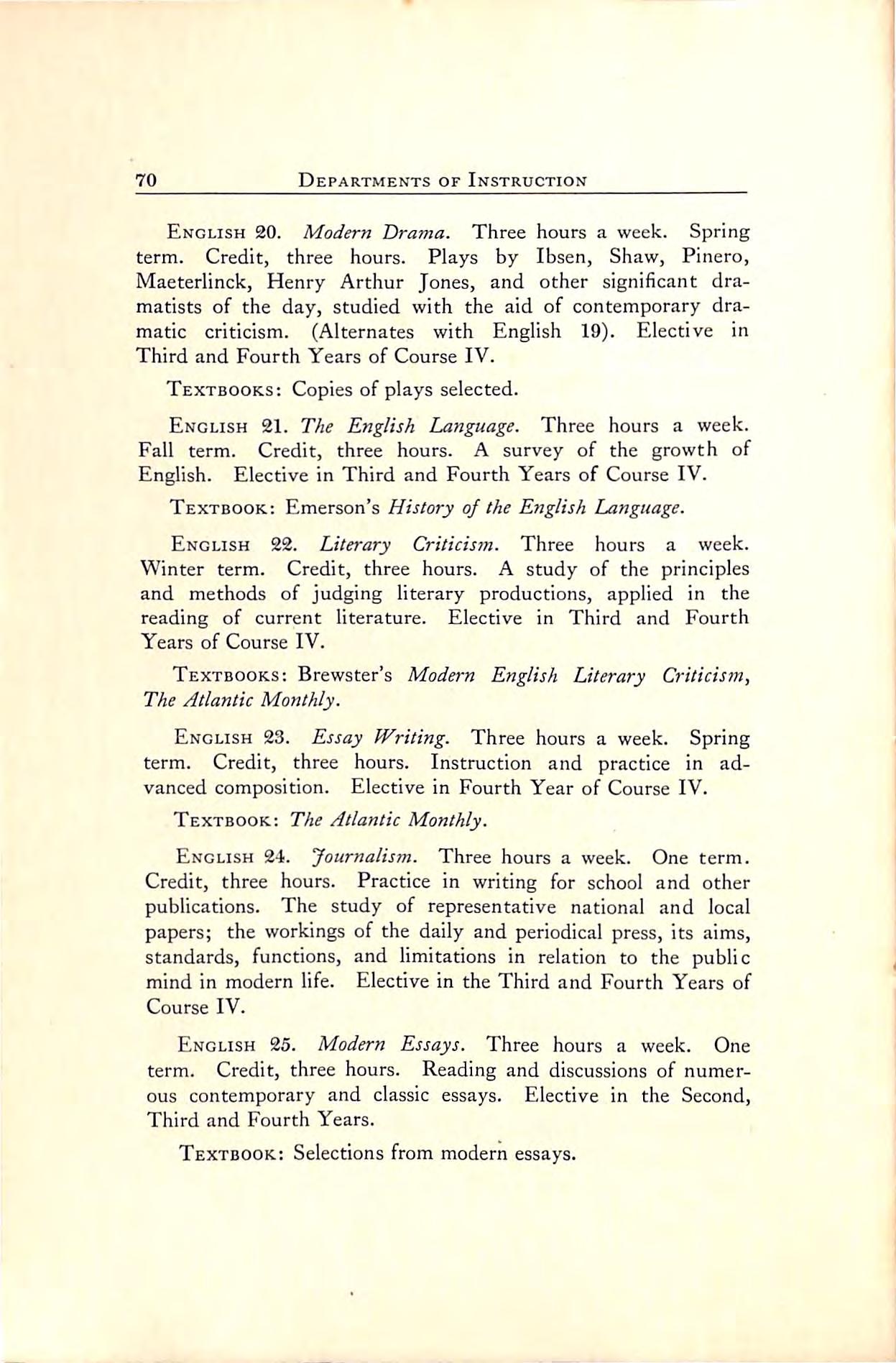
DepartmentsofInstruction
English 20. Modern Drama. Three hours a week. Spring term. Credit, three hours. Plays by Ibsen, Shaw, Pinero, Maeterlinck, Henry Arthur Jones, and other significant dra matists ofthe day,studied with the aid ofcontemporary dra matic criticism. (Alternates with English 19). Elective in ThirdandFourthYearsofCourseIV.
Textbooks: Copiesofplaysselected.
English 21.The English Language. Three hours a week. Fall term. Credit, three hours. A survey of the growth of English. Elective in Third and Fourth Years of Course IV.
Textbook: Emerson's History ofthe English Language.
English 22. Literary Criticism. Three hours a week. Winter term. Credit, three hours. A study of the principles and methods of judging literary productions, applied in the reading of current literature. Elective in Third and Fourth YearsofCourseIV.
Textbooks:Brewster's Modem English Literary Criticism, The Atlantic Monthly.
English 23. Essay Writing. Three hours a week. Spring term. Credit, three hours. Instruction and practice in ad vanced composition. Elective in Fourth Year of Course IV.
Textbook: The Atlantic Monthly.
English 24. Journalism. Three hours a week. One term. Credit, three hours. Practice in writing for school and other publications. The study of representative national and local papers; the workings of the daily and periodical press,its aims, standards,functions,and limitations in relation to the public mind in modern life. Elective in the Third and Fourth Years of CourseIV.
English 25. Modern Essays. Three hours a week. One term. Credit,three hours. Readingand discussionsofnumer ous contemporary and classic essays. Elective in the Second, ThirdandFourthYears.
Textbook:Selectionsfrommodernessays.
70
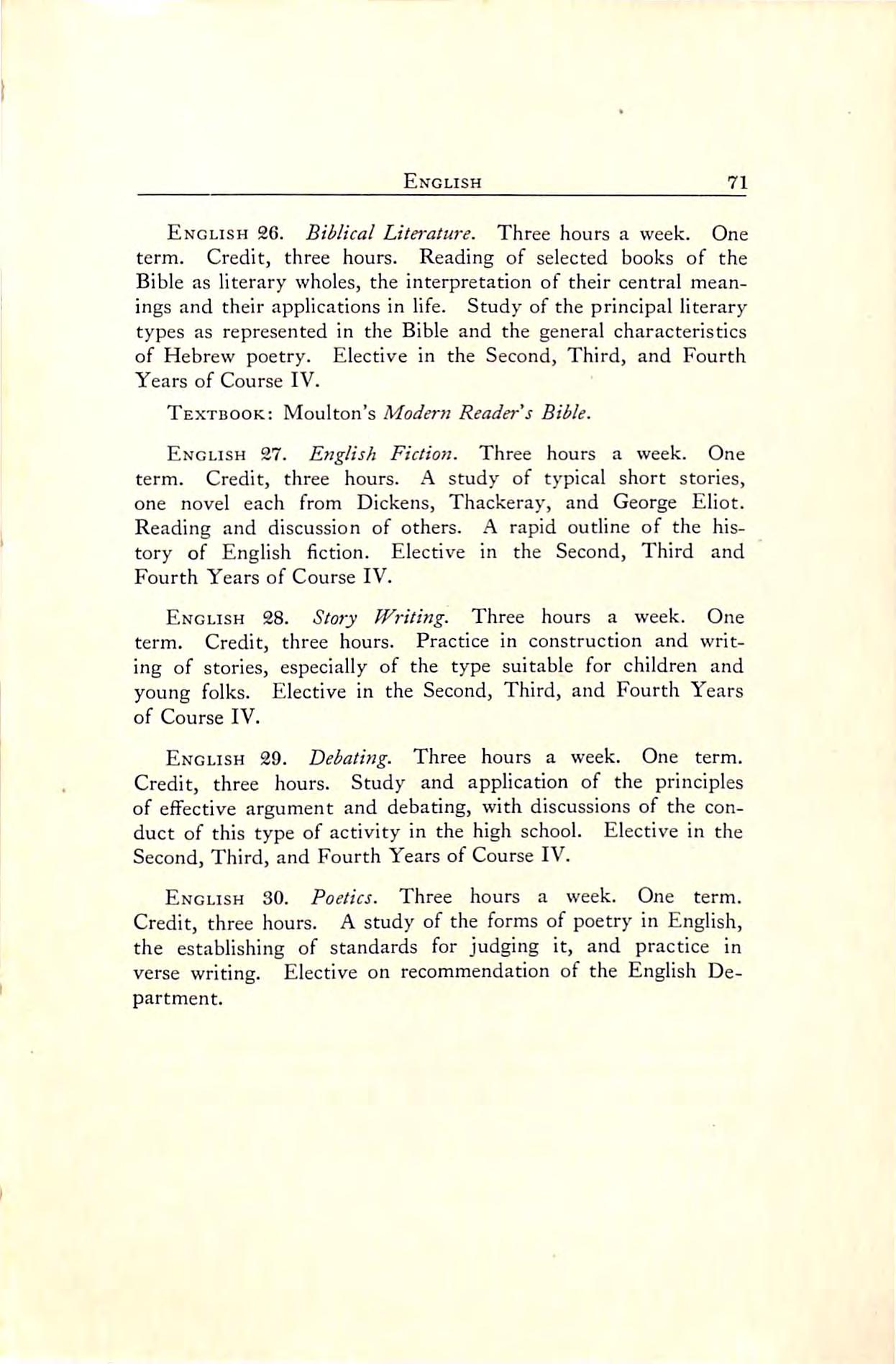
English 26. BiblicalLiterature. Three hours a week. One term. Credit, three hours. Reading of selected books of the Bible as literary wholes, the interpretation of their central mean ings and their applications in life. Study ofthe principal literary types as represented in the Bible and the general characteristics of Hebrew poetry. Elective in the Second, Third, and Fourth YearsofCourseIV.
Textbook;Moulton'sModemReader^sBible.
English 27. English Fiction. Three hours a week. One term. Credit, three hours. A study of typical short stories, one novel each from Dickens, Thackeray, and George Eliot. Reading and discussion ofothers. A rapid outline ofthe his tory of English fiction. Elective in the Second, Third and Fourth YearsofCourseIV.
English 28. Story Writing. Three hours a week. One term. Credit, three hours. Practice in construction and writ ing ofstories,especially ofthe type suitable for children and young folks. Elective in the Second, Third, and Fourth Years ofCourseIV.
English 29. Debating. Three hours a week. One term. Credit, three hours. Study and application of the principles of effective argument and debating, with discussions of the con ductofthistypeofactivityinthehighschool. Electivein the Second,Third,andFourthYearsofCourseIV.
English SO. Poetics. Three hours a week. One term. Credit,three hours. A study ofthe formsofpoetry in English, the establishing of standards for judging it, and practice in verse writing. Elective on recommendation of the English De partment.
English 71

Theaimofthisdepartmentisthree-fold: First,to train the studenttoobservecloselyandaccuratelythe worldin whichshe lives,and by careful reasoning to come to definite conclusion about certain phenomena. Second, through the study of the races of mankind,their homes,industries, habits,and general responsesto physicalenvironment,to lead her to widersympa thies and broader views. Third, to prepare her to teach geog raphyinthepublicschools.
Geography 1. General Geography Review. Three hours a week. Winterterm. Credit,threehours. Astudyofmostim portant countries, emphasis on geographic facts that make each suitableasahomeforman. FirstYear,CourseI. Textbook;Tobesupplied.
Geography 2. Principles and Methods of Geography. Two hours a week for one term. Offered Winter and Spring terms. Credit, two hours. Home Geography—subjects suitable for children in third and fourth grades. Methods of presentation. Suggestions as to sources of available materials for primary grades. First Year,Course II.
Textbook: Brigham and McFarlane's Essentials of Geography. Book I.
Geography 3. Principles and Methods of Teaching Geog raphy. Five hours a week. Spring term. Credit, five hours. Review of fundamental principles, and of subject matter taught in the intermediate and grammar grades. Methods of presen tation. Suggestions as to materials to be used. First Year of CourseIII.
Textbook: Branom's The Teaching of Geography^ and Brigham and McFarlane's Essentials of Geography^ Book II.
72 Departments of Instruction
GEOGRAPHY MISS DIETRICH
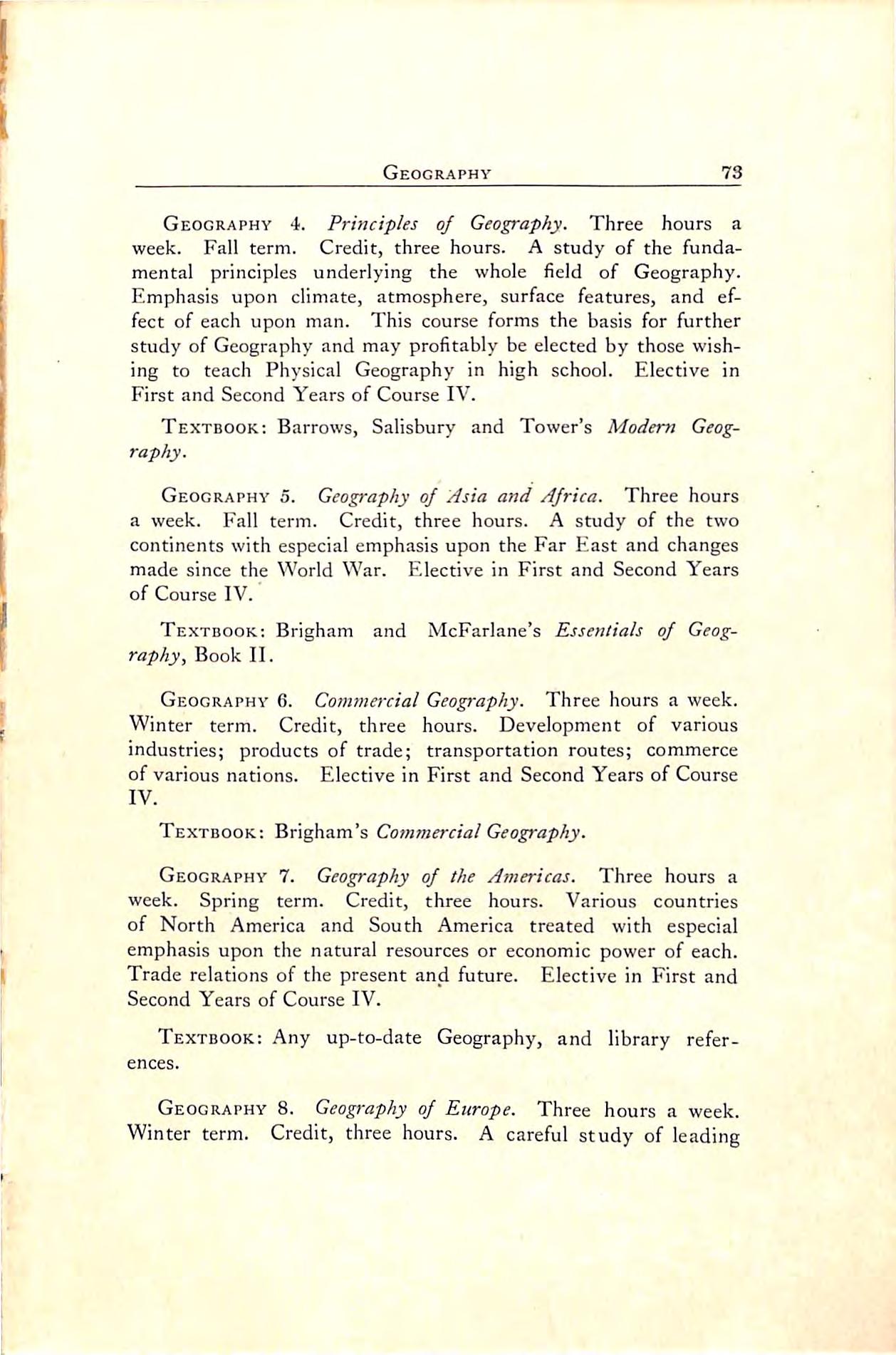
Geography
Geography 4. Principles of Geography. Three hours a week. Fall term. Credit, three hours. A study of the funda mental principles underlying the whole field of Geography. Emphasis upon climate, atmosphere,surface features, and ef fectofeach upon man. Thiscourseformsthebasisforfurther studyofGeographyandmayprofitablybeelectedbythosewish ing to teach Physical Geography in high school. Elective in FirstandSecond YearsofCourseIV.
Textbook: Barrows, Salisbury and Tower's Modem Geog raphy.
Geography 5. Geography of Asia and Africa. Three hours a week. Fall term. Credit, three hours. A study of the two continentswithespecialemphasisupontheFarEastandchanges madesince the World War. Electivein Firstand Second Years ofCourseIV.
Textbook: Brigham and McFarlane's Essentials of Geog raphy^ Book II.
Geography 6. Commercial Geography. Three hours a week. Winter term. Credit, three hours. Development of various industries; productsoftrade; transportation routes; commerce ofvariousnations. ElectiveinFirstandSecondYearsofCourse IV.
Textbook: Brigham's CommercialGeography.
Geography 7. Geography of the Americas. Three hours a week. Spring term. Credit, three hours. Various countries of North America and South America treated with especial emphasisupon thenaturalresourcesoreconomic powerofeach. Trade relations of the present and future. Elective in First and SecondYearsofCourseIV.
Textbook: Any up-to-date Geography, and library refer ences.
Geography 8. Geography ofEurope. Three hours a week. Winter term. Credit, three hours. A careful study of leading

DepartmentsorInstruction
nationsofEurope,withemphasisuponthenew Balticcountries. Electivein FirstandSecondYearsofCourseIV.
Textbook,: Same as for Geography 5.
Geography9. BiblicalGeop-aphy. Three hoursa weekfor one term. Spring term. Credit, three hours. Alternates with Geography 10. Given in 1922-23. A study of Palestine and neighboring districts. Present-day conditions compared with those of Bible times. Purpose: A better acquaintance with people and places mentioned in the Bible.
Textbook:Tarbell'sInOurMaster'sCountry^theBible,and library references.
Geography 10. Human Geography. Three hours a week. Spring term. Credit, three hours. Alternates with Geography 9. Given in 1923-24. The study of the relation of geographic environmenttohuman activity. Afewspecialproblemsstudied toillustrate theinfluenceofgeographic conditions upon human progress. ElectiveinSecond,ThirdandFourthYearsofCourse IV.
Prerequisite:ThreetermsofGeography.
Textbook: Huntington & Cushing's Principles of Human Geography.
Geography11and12. PoliticalGeography. Threehoursa week, for two terms—Fall and Winter. Credit, three hours each term. Alternates with Geography 13and 14,Influence of Geography on American History. Given in 1922-23. A careful study of strength and weaknessofgreat nations of the world, especially those of Europe. Political boundaries as they now exist. Problems confronting the nations of to-day. A helpful coursefor theteacherofEuropean History. Electivein Third and Fourth Years of Course IV.
Prerequisite:One term of Geography,and a good back groundofEuropean History.
Textbook: Isaiah Bowman's The New World.
74

Geography
Geography 13 and 14. Influence of Geography on American History. Three hours a week for two terms—Fall and Winter. Credit, three hours each term. Alternates with Geography 11 and 12—Political Geography. Given in 1923-24. Geographic conditions leading to discovery of United States. Perman ent settlements on continent. Expansion from Atlantic sea board to Mississippi River. PurchaseofLouisiana Territory and expansion beyond the Rockies. A detailedstudy ofgeographic Influences on Civil War. Development of United States Into a world power.
Thiscoursepresupposesafamiliarity withfundamentalprin ciples of Geography and main facts of American History and is especially helpful to those who plan to teach American His tory in high schools. Elective in Third and Fourth Years of CourseIV.
Prerequisite: One year of Geography.
Textbooks:Semple's Influence of Geography on American History; Brigham's Geographic Influences in American His tory.
7^
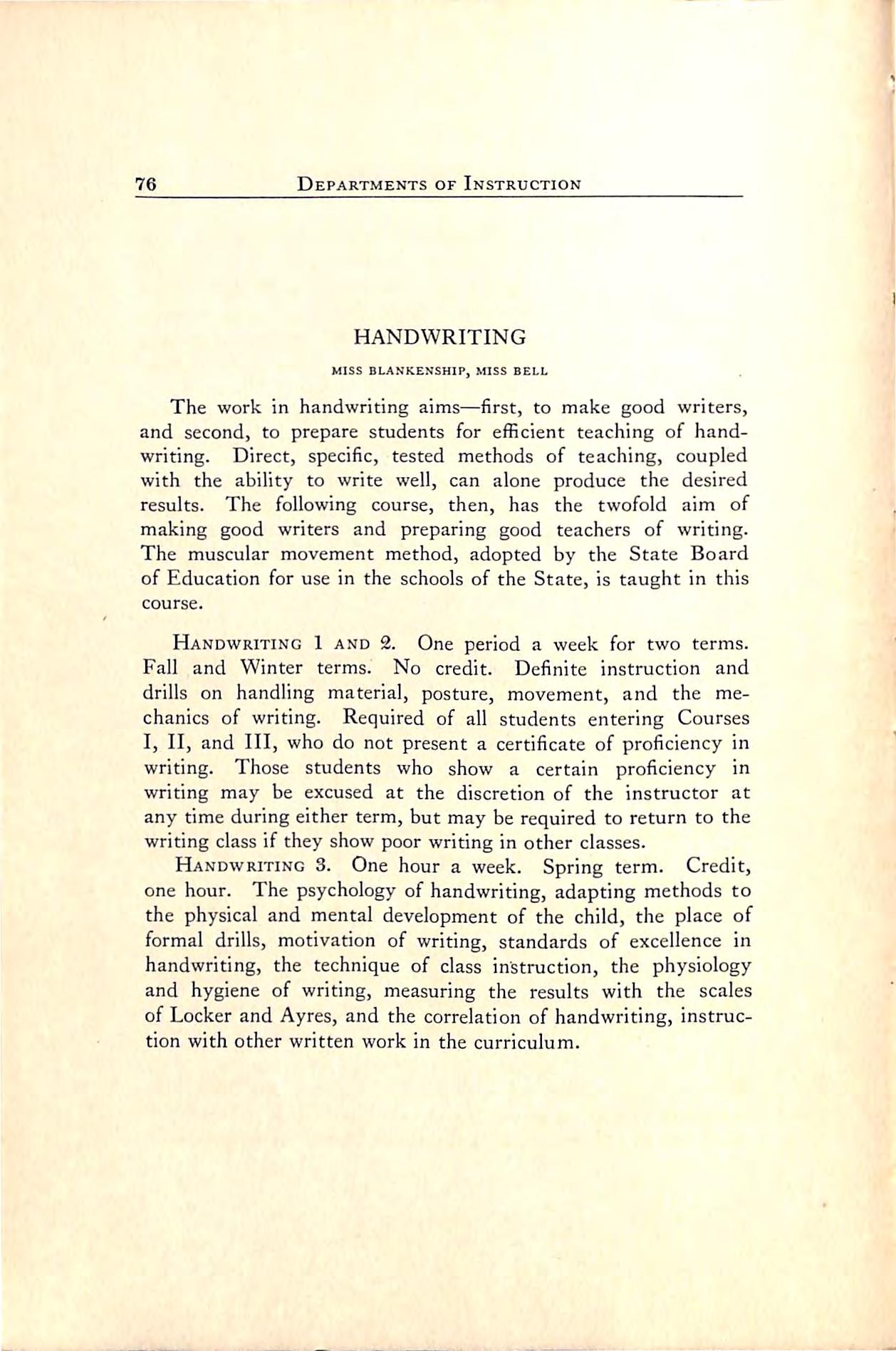
HANDWRITING
MISS BLANKENSHIP,MISS BELL
The work in handwriting aims—first, to make good writers, and second,to prepare students for efficient teaching ofhand writing. Direct, specific, tested methods of teaching, coupled with the ability to write well, can alone produce the desired results. The following course, then, has the twofold aim of making good writers and preparing good teachers of writing. The muscular movement method, adopted by the State Board ofEducationforuseintheschoolsoftheState,istaughtin this course.
Handwriting 1 and 2. One period a week for two terms. Fall and Winter terms. No credit. Definite instruction and drills on handling material, posture, movement, and the me chanics of writing. Required of all students entering Courses I,II,and III,whodo notpresentacertificateofproficiencyin writing. Those students who show a certain proficiency in writing may be excused at the discretion of the instructor at anytimeduringeitherterm,butmayberequiredtoreturntothe writingclassiftheyshowpoorwritinginotherclasses.
Handwriting 3. One hour a week. Spring term. Credit, onehour. Thepsychologyofhandwriting,adaptingmethodsto the physicaland mentaldevelopmentofthe child,the place of formal drills, motivation of writing, standards of excellence in handwriting,the technique of class instruction,the physiology and hygiene of writing, measuring the results with the scales ofLockerandAyres,andthecorrelationofhandwriting,instruc tionwithotherwrittenworkinthecurriculum.
I 76
Departments ofInstruction

HISTORY AND SOCIALSCIENCES
MR.LEAR,MISSTUCKER
The courses offered in this department besides being intended to prepare the students to teach a definite part of the curricu lum ofthe publicschools,are intended also to acquaint them with the organization of society—its structure, the interrelation ship of its component parts, its more important institutions— so that the student may be able not only to play a proper role as a member ofsociety but also to prepare others to play such a part.
Students majoring in this department are required to take the following courses: First Year,History 1, 2, and 3; Second Year,History 4,10,and 11,and Civics1; Third and Fourth Years,Economics2and3,Sociology2and3andanyothertwo coursesin thedepartmentopen to Third and Fourth Yearstu dents.
Sociology 1. Social Problems, Three hours a week for one term. Offered everyterm. Credit,three hours. Theinfluence of heredity and environment, social and physical, on group be havior; the origin and development of social institutions; ex isting pathological conditions,causes,and suggested remedies.
Textbook: Ellwood's Sociology and Modern Social Prob lems.
Sociology 2. Advanced Sociology. Three hours a week. Winter term. Credit, three hours. Open to Third and Fourth Year students.
Textbook: Hayes'Introduction to the Study of Sociology.
Sociology 3. Advanced Sociology. Three hours a week. Spring term. Credit,three hours. Open toThird and Fourth YearstudentswhohavehadSociology2.
Textbook:SameasforSociology2.
Economics 1. Elementary Economics. Three hours a week for one term. Given upon demand. Credit,three hours. An elementarycourseineconomics; relationship of wealthandwel fare,factors ofproduction,problemsof distribution, needofa
11
History and SocialSciEhfCES

social rather than individual point of view. Elective in First andSecondYearsofCourseIV.
Textbook: Marshall and Lyon's Our Economic Organization.
Economics 2. Advanced Economics. Three hours a week. Spring term. Credit,three hours. Open to Third Yearstudents.
Textbook; Taussig'sPrinciples ofEconomics.
Economics 3. Advanced Economics. Three hours a week. Fall term. Credit, three hours. A continuation of Economics 2. Open to those students who have had Economics 2. Textbook: Taussig'sPrinciples ofEconomics.
Civics 1. Three hours a week. Offered every term. Credit, three hours. Need ofgovernment; its origin, development,and present organization; modern reforms such as: referendum,ini tiative, commission form of city government. Required in all courses.
Textbook:Long'sGovernmentandthePeople.
History 1. Ancient History. Three hours a week. Fall term. Credit, three hours. Prehistoric man in contrast with man to-day; contributions made to our civilization by Egypt, Babylon,Phoenicia, Greece, and Rome. Elective in First Year ofCourseIV.
Textbook:Tobeselected.
History 2,3,and 4- Medievaland Modern History. Three hoursaweekforthreeterms. WinterandSpringtermsofFirst Year and Fall term of Second Year." Credit, three hours each term. The Holy Roman Empire, the Papacy, Renaissance, Reformation, origin of modern European states, the French Revolution, the Industrial Revolution, Napoleonic wars, strug gle between autocracy and democracy, unification of Germany and of Italy, modern commercialism, the World War. Elective inCourseIV.
Textbook:Tobeselected.
History6and6. EuropeanHistorysinceFrenchRevolution. Three hours a week for two terms. Winter and Spring terms. Credit,three hourseach term. Thiscourse gives the historical
78
DepartmentsofInstruction

History and Social Sciences 79
background necessary to understanding the conditions leading to the World War and the present European situation. Open to ThirdandFourthYearstudents.
Textbook:Tobeselected.
History7and 8. EvoliitioJi of European Civilization. Three hoursaweekfortwoterms. Winterand Springterms. Credit, three hourseach term. Thiscourse attempts to give in broad lines the evolution ofthe civilization ofEurope. Itisopen to ThirdandFourthYearstudents. Willnotbeofferedin1923-24.
History 9. /American History. Five hours a week. Winter term. Credit,five hours. European background,discovery, and settlement; strife between nationalism and sectionalism, French and English rivalries, growth of democracy in England and America, the conflict of systems, the new government, develop ment of the West, Industrial Revolution,slavery and secession, reconstruction,andmoderndevelopment.FirstYearofCourseIII.
Textbook:Tobeselected.
History 10. America^i History. Three hours a week. Winter term. Credit,three hours. A course covering the Co lonialPeriodto1812. OpentoSecondYearstudents.
Textbook:Tobeselected.
History 11. American History. Three hours a week. Springterm. Credit,threehours. AcoursecoveringtheRevo lutionand CivilWarPeriods. OpentoSecondYearstudents.
Textbook:Tobeselected.
History 12. American History. Three hours a week. Fall term. Credit,three hours. A course covering the period from1876tothepresent. Emphasisonpersonalitiesandpolitical questions. The relation between the government and the rail roads,andindustrialenterprises; welfareofagriculturalandwageearning classes; assimilation of immigrants; conservation of resources; tariffs; CivilService; money and financialquestions, imperialism; United States and the World War. Elective in Third and Fourth Years of Course IV. Offered alternate years. Given 1923-24.
Textbook: Lingley's Since the Civil War.

History IS and 14, Government and Politics. Three hours a week for two terms. Fall and Winter terms. Credit, three hours each term. An advanced course in Political Science. Development, methods, and procedure in Federal and State Government; Political Parties—origin, development, organiza tion,control through them,Constitution of Virginia; National and State politics from magazines and daily papers. Elective in Third and Fourth Years of Course IV. Offered alternate years. Given 192£-23.
Textbook;Beard's American GovernmentandPolitics.
History 15. International Relations. Three hours a week. Spring term. Credit, three hours. International trade and international peace; diplomacy of the entente powers in the Near East; the Paris Conference and afterwards; the case of Greece before the world; problems of Italy,Japan,and Mexico; the New Turkey; the League of Nations. Lectures and maga zinesusedasabasisforthiscourse. ElectiveinThirdandFourth YearsofCourse IV. Offered alternate years. Given 1922-23.
History 16. His-panic American History in the igth and 20th Centuries. Three hours a week. Winter term. Credit, three hours. Revoltofcolonies; nationalleaders andabrief history ofeach republic; industrial,social,and political condition and possibilities of each; relations with United States from the standpoint of Monroe Doctrine; territorial, commercial and po litical expansion; the Carribean and Mexican Problems; PanAmericanism. ElectiveinThird and Fourth YearsofCourse IV. Offered alternate years. Given 1923-24.
Textbook:Tobeselected.
History 17. Expansion of Europe. Three hours a week. Spring term. Credit, three hours. Preliminary analysis of motives of contemporary imperialism; history of efforts of civilized powers to acquire colonies,protectorates,and spheres of influence in Africa, Asia, the Pacific Ocean; political and eco nomicphasesofimperialism;theMoroccoQuestion;theBalkan Question;theFar Eastern Question. ElectiveinThirdandFourth YearsofCourseIV. Offeredalternateyears. Given1923-24.
Textbook:RamseyMuir'sExpansionofEurope.
80
DepartmentsofInstruction
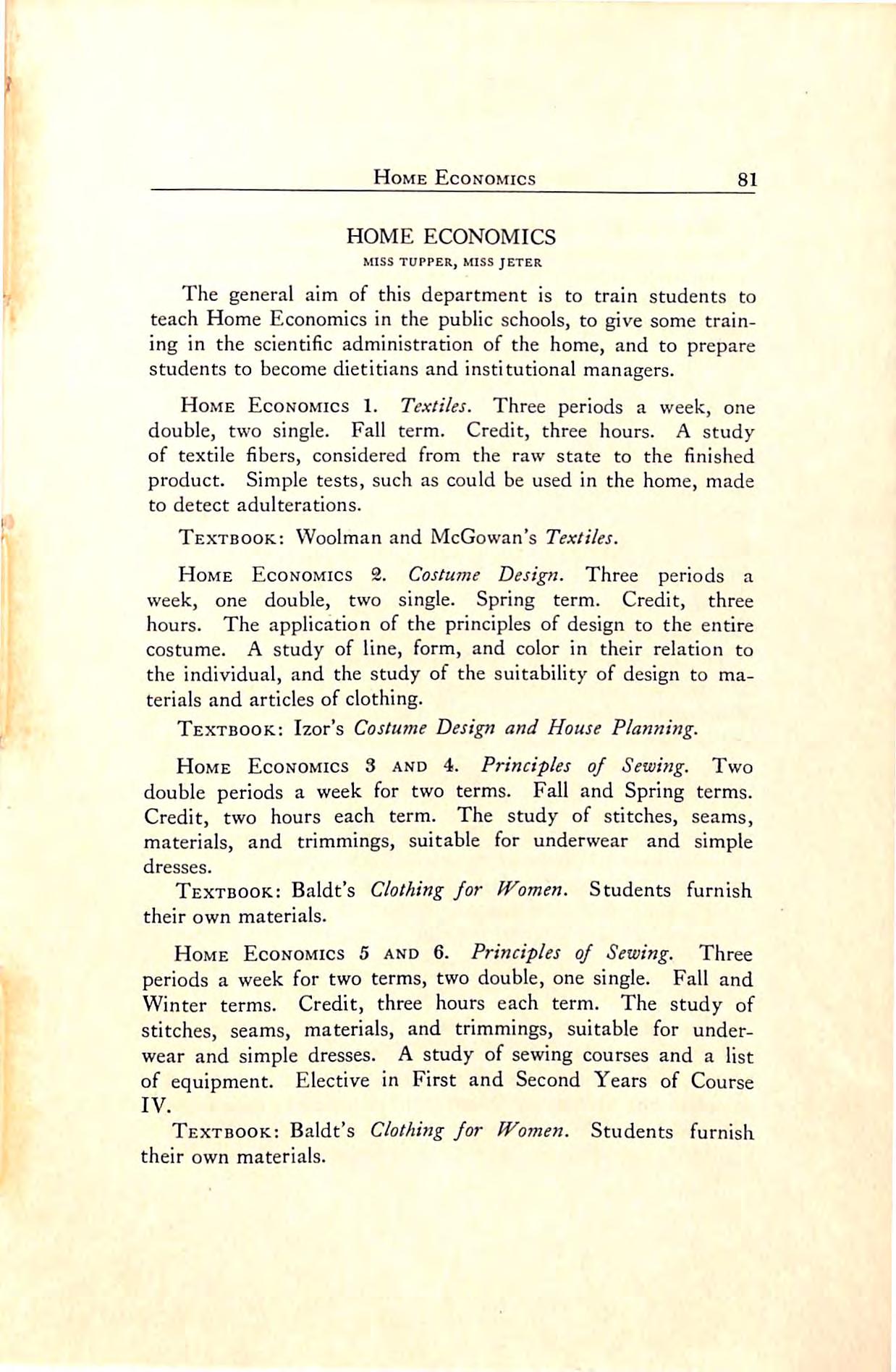
HOMEECONOMICS
MISSTUPPER,MISSJETER
The general aim ofthis departmentis to train students to teachHomeEconomicsin thepublicschools,togivesometrain ingin thescientificadministration ofthe home,and to prepare students to become dietitians and institutional managers.
Home Economics I. Textiles. Three periods a week, one double, two single. Fall term. Credit, three hours. A study of textile fibers, considered from the raw state to the finished product. Simple tests,such as could be used in the home,made todetectadulterations.
Textbook.; Woolmanand McGowan'sTextiles.
Home Economics 2. Costume Design. Three periods a week, one double, two single. Spring term. Credit, three hours. The application of the principles of design to the entire costume. A studyofline,form,and colorin their relation to theindividual,andthestudyofthesuitabilityofdesign to ma terials and articles ofclothing.
Textbook: Izor's Costume Design and House Planning.
Home Economics 3 and 4. Principles of Sewing. Two double periods a week for two terms. Fall and Spring terms. Credit, two hours each term. The study of stitches,seams, materials, and trimmings,suitable for underwear and simple dresses.
Textbook: Baldt's Clothing for fVomen. Students furnish theirownmaterials.
Home Economics 5 and 6. Principles of Sewing. Three periodsa weekfortwoterms,twodouble,onesingle. Fall and Winter terms. Credit, three hours each term. The study of stitches,seams, materials, and trimmings, suitable for under wear and simple dresses. A study of sewing courses and a list of equipment. Elective in First and Second Years of Course IV.
Textbook: Baldt's Clothing for fVomen. Students furnish theirownmaterials.
HomeEconomics 81
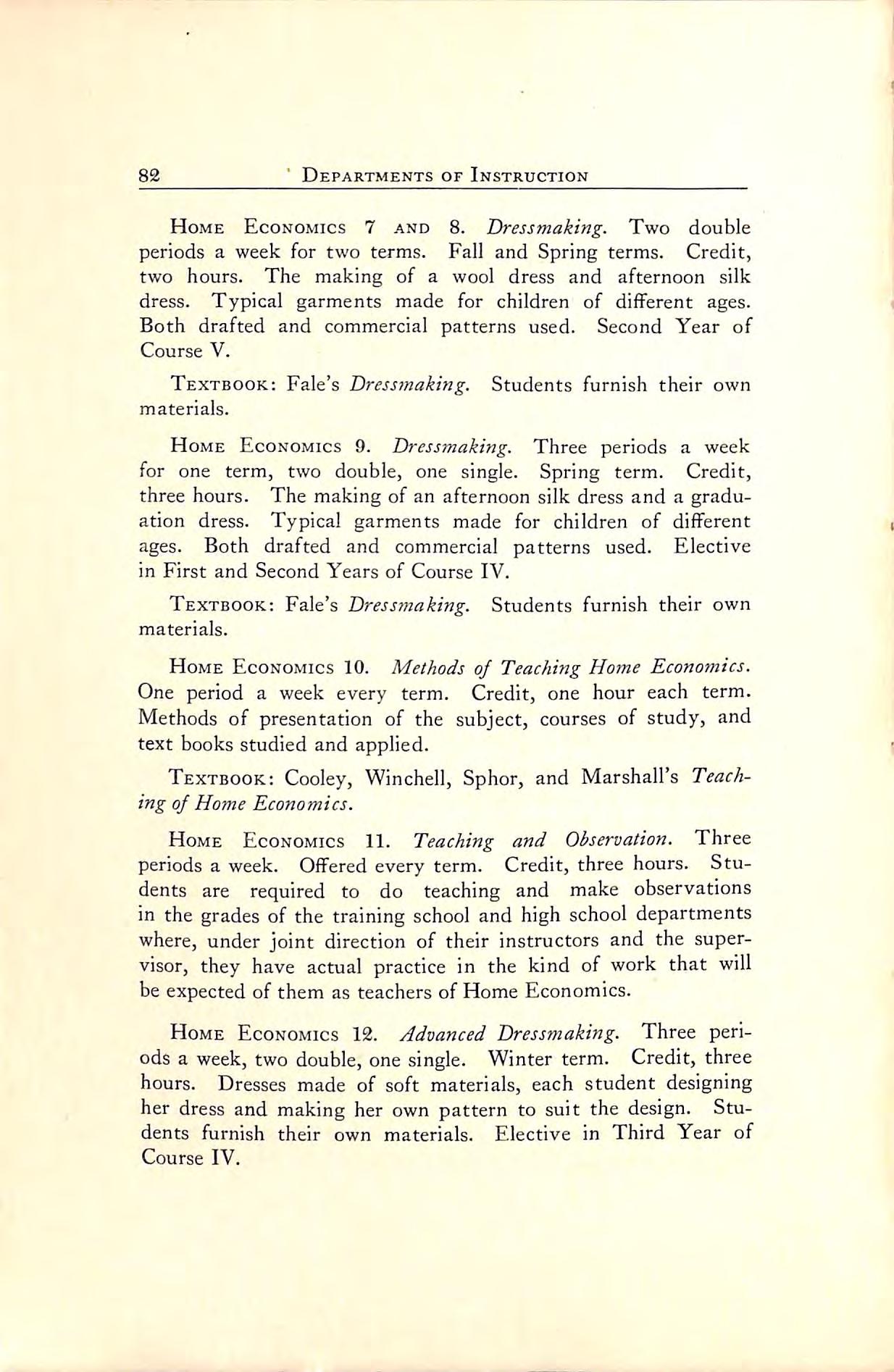
Home Economics 7 and 8. Dressmaking. Two double periods a week for two terms. Fall and Spring terms. Credit, two hours. The making of a wool dress and afternoon silk dress. Typical garments made for children of different ages. Both drafted and commercial patterns used. Second Year of Course V.
Textbook: Fale's Dressmaking. Students furnish their own materials.
Home Economics 9. Dressmaking. Three periods a week for one term, two double, one single. Spring term. Credit, threehours. Themakingofanafternoonsilkdressandagradu ation dress. Typical garments made for children of different ages. Both drafted and commercial patterns used. Elective inFirstandSecondYearsofCourseIV.
Textbook: Fale's Dressmaking. Students furnish their own materials.
HomeEconomics10. MethodsofTeachingHomeEconomics. One period a week every term. Credit,one hour each term. Methods of presentation of the subject, courses of study, and textbooksstudiedandapplied.
Textbook:Cooley,Winchell,Sphor,and Marshall's Teach ing ofHome Economics.
Home Economics 11. Teaching and Observation. Three periodsaweek. Offeredeveryterm. Credit,three hours. Stu dents are required to do teaching and make observations in thegradesofthetrainingschooland highschooldepartments where, under joint direction of their instructors and the super visor, they have actual practice in the kind of work that will beexpectedofthemasteachersofHomeEconomics.
Home Economics 12. Advanced Dressmaking. Three peri ods a week,two double,onesingle. Winter term. Credit,three hours. Dresses made ofsoft materials,each student designing her dress and making her own pattern to suit the design. Stu dents furnish their own materials. Elective in Third Year of CourseIV.
82 'Departments ofInstruction

Home Economics 13. House Planning and Furnishing. Threeperiodsaweek,onedouble,twosingle. Fallterm. Credit, three hours. The houseanditsconstruction,furnishings,deco rations,and care. The study of house materials,colors, har mony in furnishings, the selection and arrangement of furni ture, etc. Elective in Fourth Year of Course IV.
Home Economics 14. Millinery. Three periods a week, one double,two single. Spring term. Credit, three hours. The making and covering of frames, trimmings, and the renovation ofmaterials. One fabricstreethat made,and twospring hats, one a street hat, and the other a dress hat. Open to Third and FourthYearstudentsofCourseIV.
Home Economics 15 and 16. Elementary Study of Foods. Threeperiods a week for two terms, two double, one single. Winter and Spring terms. Credit, three hours each term. A study of the composition of foods, the principles underlying their preparation, the sources,manufacture,and cost offoods; and the preparing, planning, and serving of meals. Elective in First or Second Years of Course IV,and required in First YearofCourseV.
LaboratoryFee:Onedollaraterm.
Textbook: Bailey's Source^ Chemistry, and Uses of Food Products.
Home Economics 17. Advanced Study of Foods. Three periods a week for one term,two double,one single. Offered FallandSpringterms. Credit,threehours. A continuationof Home Economics 12 and 13. A more advanced study of foods, with special emphasis on food preservation and table service. Electivein Firstand SecondYearofCourseIV,andrequiredin SecondYearofCourseV.
Prerequisite: Home Economics 12and 13.
LaboratoryFee:Onedollarandahalfaterm.
Home Economics 18 and 19. Nutrition. Three periods a weekfor twoterms,twodouble,onesingle. WinterandSpring
HomeEconomics 83
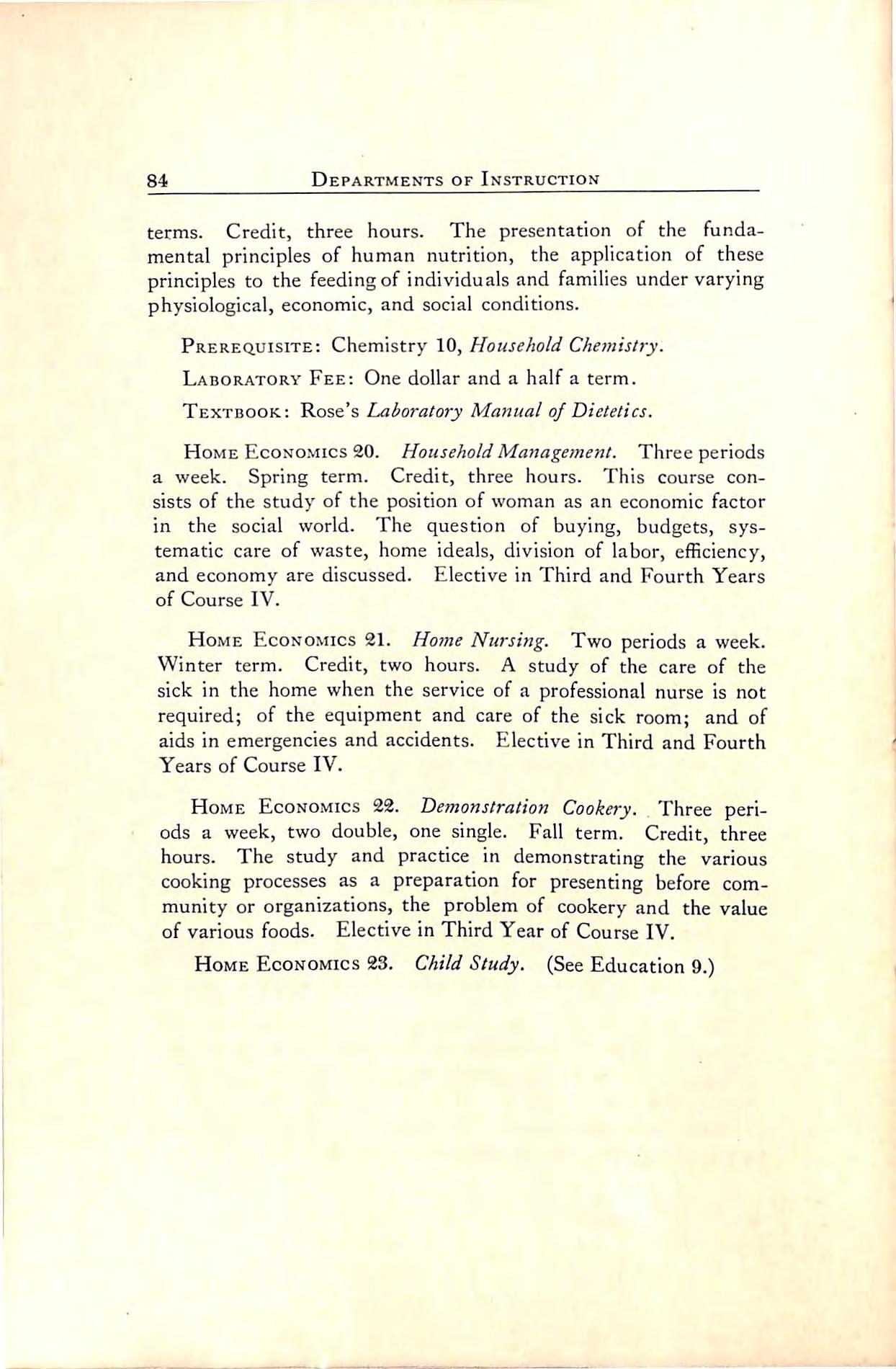
terms. Credit, three hours. The presentation of the funda mental principles of human nutrition, the application of these principles to the feedingofindividuals and families under varying physiological,economic,andsocialconditions.
Prerequisite: Chemistry 10,Household Chemistry.
LaboratoryFee:Onedollarandahalfaterm.
Textbook: Rose's Laboratory Manual ofDietetics.
HomeEconomics20. HouseholdManagement. Three periods a week. Spring term. Credit, three hours. This course con sists of the study of the position of woman as an economic factor in the social world. The question of buying, budgets, sys tematic care ofwaste,homeideals,division oflabor,efficiency, and economy are discussed. Elective in Third and Fourth Years ofCourseIV.
HomeEconomics21. HomeNursing. Twoperiodsaweek. Winter term. Credit, two hours. A study of the care of the sickin the homewhen theserviceofaprofessionalnurseisnot required; of the equipment and care of the sick room; and of aidsin emergencies and accidents. Elective in Third and Fourth YearsofCourseIV.
Home Economics 22. Demonstration Cookery. Three peri ods a week, two double, one single. Fall term. Credit, three hours. The study and practice in demonstrating the various cooking processes as a preparation for presenting before com munityororganizations,the problemof cookeryand thevalue of various foods. Elective in Third Year of Course IV.
HomeEconomics23. ChildStudy. (SeeEducation9.)
84 DepartmentsofInstruction
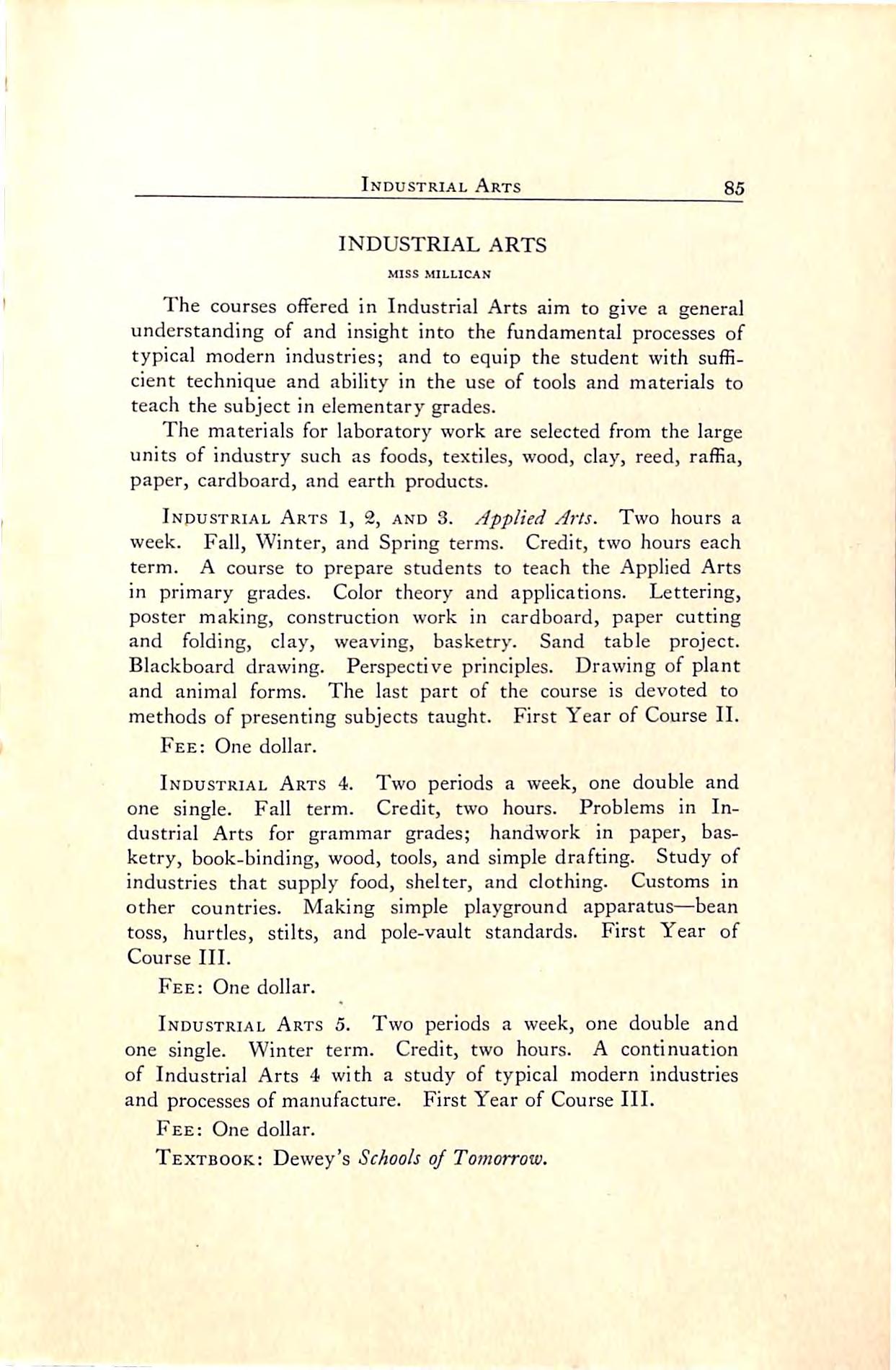
INDUSTRIALARTS
MISS MILLICAK
The courses offered in Industrial Arts aim to give a general understandingofand insightinto the fundamental processesof typical modern industries; and toequip thestudent with suffi cienttechnique and abilityin the useoftoolsand materials to teachthesubjectinelementarygrades.
Thematerialsforlaboratoryworkareselectedfrom thelarge unitsofindustrysuch asfoods,textiles,wood,clay,reed,raffia, paper, cardboard, and earth products.
IndustrialArts1,2,and 3. AppliedArts. Two hoursa week. Fall, Winter,and Spring terms. Credit, two hours each term. A course to prepare students to teach the Applied Arts in primary grades. Color theory and applications. Lettering, poster making, construction work in cardboard, paper cutting and folding, clay, weaving, basketry. Sand table project. Blackboard drawing. Perspectiveprinciples. Drawingofplant and animal forms. The last part of the course is devoted to methodsofpresentingsubjectstaught. FirstYearofCourseII.
Fee:Onedollar.
Industrial Arts 4. Two periods a week,one double and one single. Fall term. Credit, two hours. Problems in In dustrial Arts for grammar grades; handwork in paper, bas ketry,book-binding,wood,tools,andsimpledrafting. Studyof industries thatsupply food,shelter,and clothing. Customsin other countries. Making simple playground apparatus—bean toss, hurtles, stilts, and pole-vault standards. First Year of CourseIII.
Fee:Onedollar.
Industrial Arts 5. Two periods a week,one double and one single. Winter term. Credit,two hours. A continuation of Industrial Arts 4 with a study of typical modern industries and processes ofmanufacture. First Year ofCourse III.
Fee:Onedollar.
Textbook:Dewey'sSchoolsojTomorrow.
Industrial Arts 85
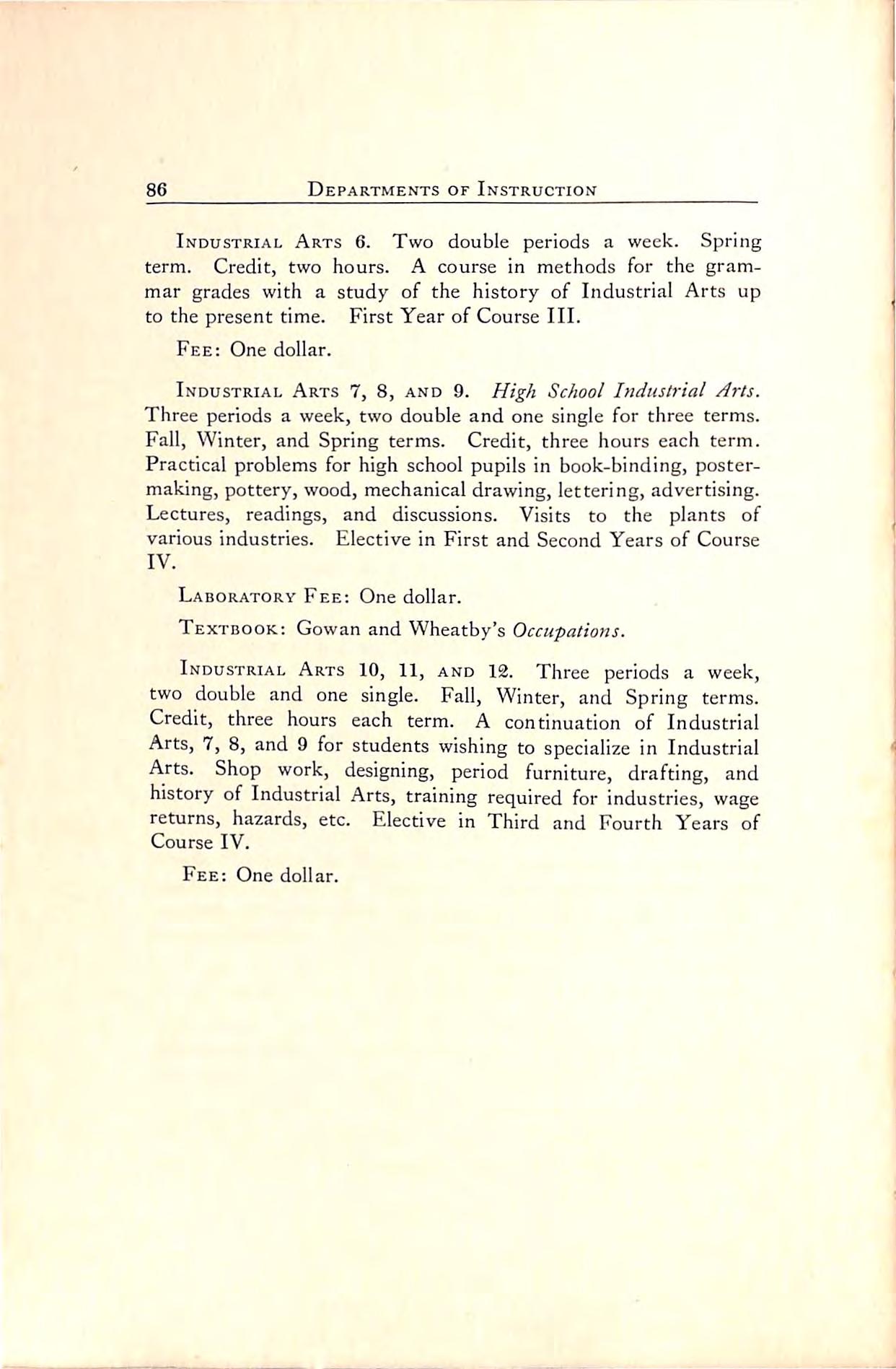
Industrial Arts 6. Two double periods a week. Spring term. Credit, two hours. A course in methods for the gram mar grades with a study of the history of Industrial Arts up to the presenttime. First YearofCourse III.
Fee:Onedollar.
IndustrialArts7,8,and 9. High SchoolIndustrialArts. Threeperiodsaweek,twodoubleandonesingleforthreeterms. Fall,Winter,andSpringterms. Credit,three hourseach term. Practical problems for high school pupils in book-binding,postermaking,pottery,wood,mechanicaldrawing,lettering,advertising. Lectures, readings, and discussions. Visits to the plants of various industries. Elective in First and Second Years of Course IV.
LaboratoryFee:Onedollar.
Textbook: Gowan and Wheatby's Occupations.
Industrial Arts 10, 11, and 12. Three periods a week, two double and one single. Fall, Winter, and Spring terms. Credit, three hours each term. A continuation of Industrial Arts, 7, 8, and 9 for students wishing to specialize in Industrial Arts. Shop work, designing, period furniture, drafting, and history of Industrial Arts, training required for industries, wage returns, hazards, etc. Elective in Third and Fourth Years of CourseIV.
Fee:Onedollar.
86 DepartmentsofInstruction^

LATIN
MISS RICE
The work of the first two yearsin Latin is planned to prepare teachersofLatin for thefirstand second yearsofthe high schools. Thecoursemappedoutin thethirdandfourth yearsisintended for students who wish peparation for teaching four years of Latin.
Latin 1. Intensive Study of Casar. Three hours a week. Fall term. Credit, three hours. Personality and career of Caesar, significance of his conquests, his writings as history and as literature; Roman military system; geography of Gaul; sen tence structure and word order; drill in the building of a vo cabulary; practice in sight reading.
Prerequisite: Three high school units in Latin. Elective inFirstYearofCourseIV.
Textbook: Ceesar's Gallic Wars; Bennett's Grammar; D'Ooge'sCompositionParti.
Latin 2. Intensive Study of Casar. Three hours a week. Winter term. Credit, three hours. Continuation of Latin 1. Elective in First Year of Course IV.
Latin 3. Teaching ofLatin. Three hours a week. Spring term. Credit, three hours. Review of pronunciation; rapid surveyofthesyntax ofcases,moods,and tenses; principlesof Latin order; simple sentence structure; methods ofpresentation; proper emphasis upon geography, ancient life, and hisotrical connections; useofmaps,pictures,and variousclassroom helps. ElectiveinFirstYearofCourseIV.
Textbooks:PrimusAnnus; Andrew'sPraceptor; Johnston's ThePrivateLifeoftheRomans.
Latin 4. Intensive Study of Cicero. Three hours a week. Fall term. Credit, three' hours. Brief history of the last cen turyoftherepublic; personalityandcareerofCicero; compar-
Latin 87

ison between Csesar and Cicero; typical structure ofa Roman oration; practice in sight reading. Elective in Second Year of CourseIV.
Textbooks: Cicero's Orations; Bennett's Grammar; D'Ooge's Composition^ Part 2.
Latin 5. Intensive Study of Virgil. Three hours a week. Winter term. Credit,three hours. Roman mythology and re ligion; the Augustan age; life of Virgil and the effect of envi ronment upon his poetic genius and literary art; Roman Epic poetry; studyofthehexameter; essaysonVirgilfrom standard works. ElectiveinSecondYearofCourseIV.
Textbooks:Virgil's Mneid; Fairbank's Mythology of Greece andRome;Glover'sStudiesin Virgil.
Latin 6. Life and Literature of the Romans. Three hours a week. Spring term. Credit, three hours. Roman life as seen in Roman literature; life and literature ofthe Romansas a factor in modern civilization; brief history of the Latin lan guage and its relation to English. Elective in Second Year of CourseIV.
Textbooks: Peck and Arrowsmith's Roman Life in Latin Prose and Verse; Duff's A Literary History of Rome.
Latin7. Roman History. Three hoursa week. Fallterm. Credit, three hours. Elective in Third Year of Course IV.
Textbooks: Livy, Book 1; Bennett's Grammar\ D'Ooge's Composition.,Part 1.
Latin 8. Roman History. Three hours a week. Winter term. Credit,three hours. A continuation ofLatin 7. Elec tive in Third Year of Course IV.
Textbooks:Livy,BookXXI; Bennett's
Latin 9. Essays. Three hours a week. Spring term. Credit,three hours. Electivein Third Year ofCourseIV.
Textbooks:Cicero'sDeAmicitiaandHeSenectute.
88
DepartmentsofInstruction

Latin 10. Writings of Horace. Three hours a week. Fall term. Credit, three hours. Elective in Fourth Year of Course IV.
Textbook: Moore's Odes\ Satires and Epistles.
Latin 11. Writings of Horace. Three hours a week. Win ter term. Credit, three hours. Elective in Fourth Year of Course IV.
Textbook;DeArtePoetica.
Latin 12. Writings of Horace. Three hours a week. Spring term. Credit, three hours. Elective in Fourth Year of Course IV.
Textbook: Plinys Letters.
Latin 89

MATHEMATICS
MISS LONDON,MISSTALlAFERaO
This department offers courses in arithmetic, algebra, geom etry, trigonometry, analytics and calculus, and method courses in teaching artihmetic in the elementary schools, a method course in teaching algebra and plane geometry in the secondary schools, a course in the history of mathematics for degree stu dents majoring in mathematics, and a course in thrift and the making of personal and household budgets. All work in the department is given with a full appreciation of the need for vitalization in all school work and the effort is made everywhere tolinkuptheworkwiththedemandsofreallife.
Students who majorin mathematicsarerequired to takethe followingcourses: FirstYear,Mathematics3,4,5;SecondYear, Mathematics6,7,8; Third Year,Mathematics 9,10,11; Fourth Year,Mathematics 12,13,14. The minor requirement is the work of the first two years.
Mathematics 1. Arithmetic. Three hours a week for one term. Offered every term. Credit,three hours. Nota review of grade arithmetic, but an advanced course given from a more personal point of view. Emphasis upon the arithmetic required for personal finance, such as conducting business at a bank, stocks and bonds as means of investments, comparison of time and cash payments, etc. Special attention given to laws of thriftandtothemakingofpersonalandhouseholdbudgets.
Textbook: Ball and West's Household Arithmetic.
References: Government Bulletins on Thrift.
Mathematics 2. Arithmetic and Primary Methods. Three hours a week. Spring term. Credit,three hours. Arithmetic reviewed from the point of view ofthe primary teacher. The development of numbers,and of the characteristic principles of the Hindoo Arabic system discussed. Material available for classroom use listed with emphasis upon the importance of linking up number work with life experiences and school-room
90
Departments of Instruction
activities. A tentative course of study for the first four grades outlined and definite methods of classroom procedure suggested. Illustrations of the use ofstandard tests taken from the work ofthe Training School. Required,First Year of Course 11.
Textbooks: Klapper's The Teaching of Arithmetic; Brown andCofFman'sHowto Teach Arithmetic.
References: J. W. A. Young's The Teaching of Mathe matics; David Eugene Smith's The Teaching of Elementary Mathematics; and other library references.
Mathematics 3. Arithmetic and Grammar Grade Methods. Five hours a week. Fall term. Credit, five hours. A review
of the subject matter of arithmetic from the point of view of thegrammargrade teacher,with emphasisupon the arithmetic needed by the average citizen rather than the special worker, and upon the choice of subject matter from real life situations and in accordance with modern business customs. Emphasis placed upon the importance of arithmetic as a tool subject. Somediscussion ofgeneral methodsapplied to arithmetic,such ; astheanalyticapproach to problems,theinductiveestablishing of principles and rules, the use of the laboratory method in
teaching measures, and of the project method, in such topics as
have been definitely worked out in the Training School. The function of the drill lesson and laws governing the same. A tentative course of study outlined and requirements of an ideal course discussed. Required, First Year of Course III and First Year of Course IV, of students majoring or minoring in Mathematics.
Textbooks:SameasforMathematics2.
References:SameasforMathematics2.
Mathematics 4. College Algebra I. Three hours a week. Winter term. Credit,three hours. A review ofhigh school alge bra,chieflyfrom the teacher's viewpoint,followed by the usual topics of college work; oral and written reports from required reading. Elective in First Year ofCourse IV.
Textbook:Fife'sCollegeAlgebra.

Mathematics 91
I ^
I
I
I
92

Departments of Instruction
Prerequisite:One and one-halfunitsofalgebra and plane geometry. Students majoring in Mathematics are advised to take Arithmetic 1 as an elective during their course.
Mathematics 5. College Algebra II. Three hours a week. Spring term. Credit, three hours. A continuation of Math ematics4. ElectiveinFirstYearofCourseIV.
Mathematics 6. Methods of Teaching High School Mathmatics. Three hours a week. Fall term. Credit, three hours. Reasons for teaching the different branches of mathematics, a brief history of their development, correlation with other sub jects,thesubject matterto beoffered,astudyofthe presenta tionoftypicalparts,observation,supplementarystudyofmaga zinesandreference books. ElectiveinSecondYearofCourse IV.
Textbooks: J. W.A.Young's The Teaching of Mathematics; David EugeneSmith's The TeachingofGeometry.
Mathematics 7. Solid Geometry. Three hours a week. Winter term. Credit, three hours. The usual propositions and original exercises with applications; parallel review of plane geometry. ElectiveinSecondYearofCourseIV.
Textbook: Wells and Hart's Solid Geometry.
Mathematics 8. Trigonometry. Three hours a week. Spring term. Credit,threehours. Studentsled todiscoverthefunda mental principles, field work with improvised instruments to stress the practical nature of the subject. Elective in Second YearofCourseIV.
Textbook: Palmer and Leigh's Plane Trigonometry.
Mathematics 9. Analytics. Three hours a week. Fall term. Credit,three hours. Elective in Third Year ofCourse IV.
Textbook: Smith and Gale's New Analytic Geometry.

Mathematics 10. Analytics. Three hours a week. Winter term. Credit, three hours. A continuation of Mathematics 9. Electivein ThirdYearofCourseIV.
Mathematics 11. History of Mathematics. Three hours a week. Spring term. Credit, three hours. Elective in Third YearofCourseIV.
References: Histories of Mathematics and other librarymaterial.
Mathematics 12. Calculus. Three hours a week. Fall term. Credit, three hours. Principles and applications. Elec tiveinFourthYearofCourseIV.
Textbook:Davis's TheCalculus.
Mathematics 13. Calculus. Three hours a week. Winter term. Credit, three hours. A continuation of Mathematics 12. ElectiveinFourthYearofCourseIV.
Mathematics 14. Calculus. Three hours a week. Spiing term. Credit, three hours. A continuation of Mathematics 12. andIS. ElectiveinFourthYearofCourseIV.
Mathematics 93

MODERN LANGUAGES
MISS SMITHEY,MISS DRAPER
The work of the courses in Modern Languages for the First and Second Yearsisdesigned togivestudents wishing to teach in the junior high schools of the State a more thorough mastery of the language studied especially with respect to pronunciation, grammar,andoralexpression.
The work of the Third and Fourth Years is designed to meet the needs of students who, having completed the work of the First and Second Years,or its equivalent, wish to qualify them selves to teach in the accredited four-year high schools ofthe State.
The departmentoffers coursesin French,Spanish,and Ger man.
French
French 1. Three hours a week. Fall term. Credit, three hours. Critical study ofgrammar and pronunciation; reading ofsimpletexts;oralandwrittenreproduction;dictation; phonics.
The work of this term is the basis for the courses offered in the First and Second Years. Elective in First Year of Course IV.
Prerequisites: Three unitsofLatin and two unitsofFrench, ortwounitsofLatinandthreeofFrench.
French 2. Three hours a week. Winter term. Credit, three hours. This course is a continuation of the work of French 1. ElectiveinFirstYearofCourseIV.
French 3. Three hours a week. Spring term. Credit, three hours. The teaching of French; principles of Modern Language teaching; methods of instruction; organization and presentation of subject matter. Elective in Second Year of CourseIV.
Textbooks: Gouin's The Art of Learning and Studying Languages; Bahlsen'sTheTeachingofModernLanguages; Breal's TheTeachingofModemLanguagesinSecondarySchools; Report ofCommitteeofTwelve.
94 DepartmentsofInstruction
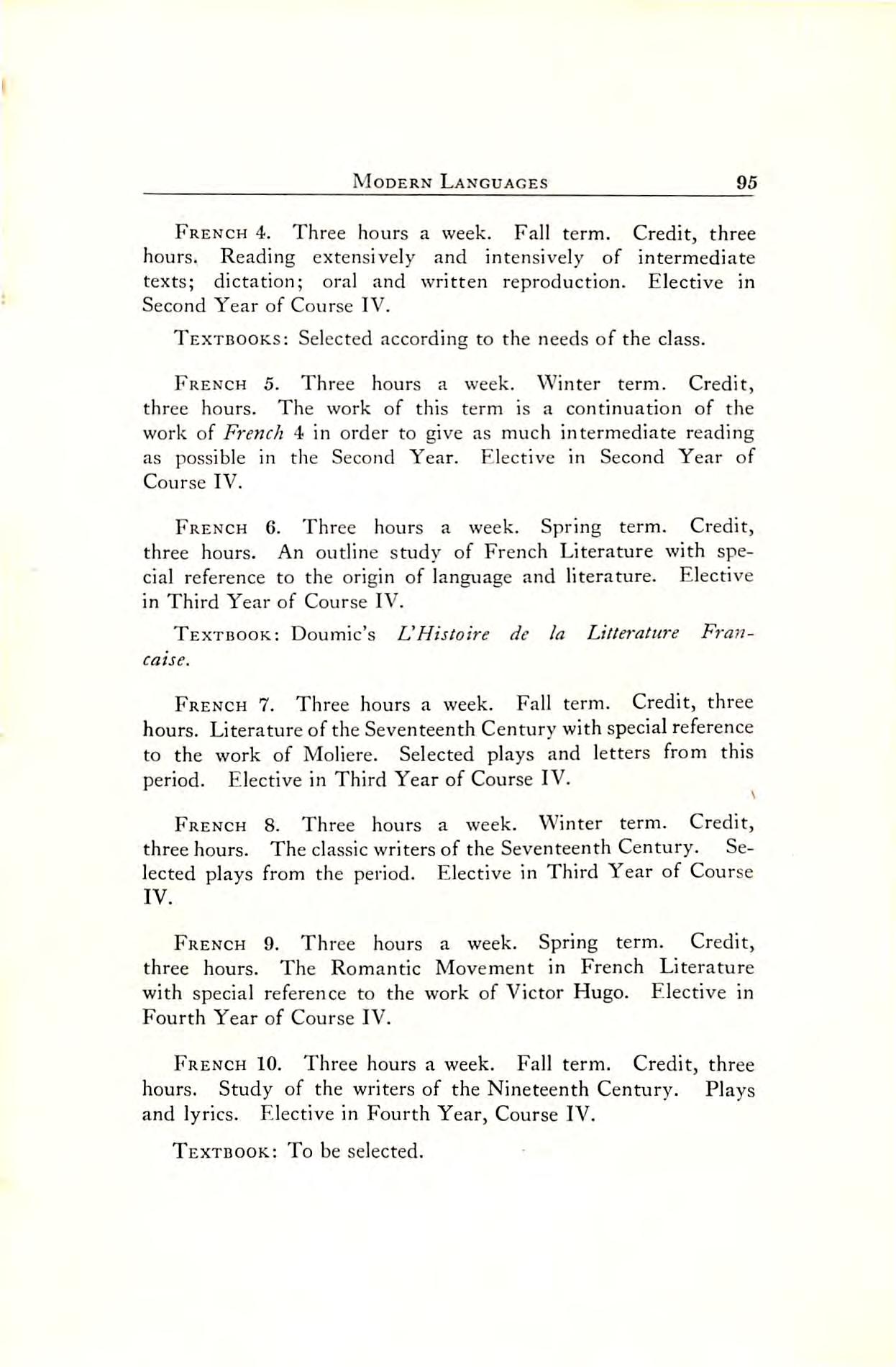
French 4. Three hours a week. Fall term. Credit, three hours. Reading extensively and intensively of intermediate texts; dictation; oral and written reproduction. Elective in Second Year ofCourse IV.
Textbooks: Selected according to the needs ofthe class.
French 5. Three hours a week. Winter term. Credit, three hours. The work of this term is a continuation of the work of French 4 in order to give as much intermediate reading as possible in the Second Year. Elective in Second Year of Course IV.
French 6. Three hours a week. Spring term. Credit, three hours. An outline study of French Literature with spe cial reference to theorigin oflanguageand literature. Elective inThirdYearofCourseIV.
Textbook:Doumic's L'Histoire de la Litteratiire Francaise.
French 7. Three hours a week. Fall term. Credit, three hours.LiteratureoftheSeventeenthCenturywithspecialreference to the work of Moliere. Selected plays and letters from this period. ElectiveinThirdYearofCourseIV.
French 8. Three hours a week. Winter term. Credit, three hours. The classic writers of the Seventeenth Century. Se lected plays from the period. Elective in Third Year of Course IV.
French 9. Three hours a week. Spring term. Credit, three hours. The Romantic Movementin French Literature withspecialreference to the workofVictorHugo. Electivein FourthYearofCourseIV.
French 10. Three hours a week. Fall term. Credit, three hours. Study ofthe writersoftheNineteenthCentury. Plays and lyrics. Elective in Fourth Year,Course IV.
Textbook:Tobeselected.
ModernLanguages 96

French 11. Three hours a week. Winter term. Credit, three hours. A study of Rostand and his work. Elective in FourthYearofCourseIV.
French 12. Three hours a week. Spring term. Credit, three hours. Some aspectsofFrench Literature ofthe present century. Thiscourseincludesthereadingofsomelyrics. Elective inFourthYearofCourseIV.
Spanish
Spanish 1. Three hours a week. Fall term. Credit, three hours. A critical study ofgrammar and pronunciation; read ing ofsimple texts; dictation; oral and written reproduction; phonics.
ThiscourseIsthebasisfortheworkintheFirstandSecond Years. ElectiveinFirstYearofCourseIV.
Prerequisites:ThreeunitsofLatinandtwounitsofSpanish, orthreeunitsofSpanishandtwounitsofLatin.
Spanish 2. Three hours a week. Winter term. Credit, three hours. A continuation of the work of Spanish 1; reading ofsimple texts; oral and written reproduction; dictation. Elec tiveinFirstYearofCourseIV.
Textbooks:Selected according to the needs ofthe students.
Spanish 3. Three hours a week. Spring term. Credit, three hours. Reading of Spanish texts suitable for second year high school classes; the study of the principles of Modern Lan guageinstruction. ElectiveinSecondYearofCourseIV.
Texbooks: The same as for French 3.
Spanish 4. Three hours a week. Fall term. Credit, three hours. The reading of plays and stories of intermediate grade with reference to teaching in secondary schools. Elective in Second Year of Course IV.
Textbooks: Selected to suit the needs of the students.
96 DepartmentsofInstruction

Spanish 5. Three hours a week. Winter term. Credit, three hours. Selected readings in prose and poetry for classes in secondary schools. Elective in Second Year of Course IV.
Spanish 6. Three hours a week. Spring term. Credit, three hours. Outline course in Spanish literature as a basis for further study ofsome of the great Spanish writers. Elective in ThirdYearofCourseIV.
Textbook; To be selected.
Spanish 7. Three hours a week. Fall term. Credit, three hours. A continuation of Spanish 6. Elective in Third Year ofCourseIV.
Textbook:Tobeselected.
Spanish 8. Three hours a week. Winter term. Credit, three hours. The reading of plays,stories, and lyrics of medium and advanced difficulty. Extensive and intensive reading. ElectiveinThirdYearofCourseIV.
Spanish 9,10,11,and 12willfollow thegeneral method of the courses outlined for the French 9, 10, 11, and 12. Elective inFourthYearofCourseIV.
German
Courses in German similar to those in French and Spanish will begiven should there be a demandfor them.
NOTE:—A beginner'seoureoin French andSpanishisgivenforthe benefitofstudentsin CourseIV whowishaModernLanguageasanelectiveandwhohavenotbadthenecessaryprerequisitesfortheregular workinthisdepartraent. Thisclassmeetsfivetimesa weekthroughoutthe year. Asan electivechosen byFirstandSecondYearstudentsitreceivesthreehours"credit,chosenbyThirdandFourthYearstudents itreceivestwo-thirdscr^t. Iffullcreditisdesired,one-thirdmoreworkmustbedoneintheformofout sideassignments.
Modern
97
Languages

MUSIC
MUNOZ
The general aim of this department is to emphasize the intel lectual, aaesthetic, and social values of music, to broaden the popular conception of the function of music in the public school, and to prepare students to teach it.
The department provides for two classesofstudents: those who have had no music and those who have had either two years ofhighschool music,ortwo years'studyofinstrumental music andtwoyears'voiceculture,andwhowishtopreparetosupervise music in the public schools.
Music I. Two hours a week. Fall term. Credit,one hour. The beginningofa three-term course in CoursesI and II,pro vided for those students who have had no music. Sight-singing, observation,and analysisofsongsused asa basisfor thestudy of the rudiments of Music. Work in voice and ear training.
Music 2. Two hours a week. Winter term. Credit, one hour. Voice training,ear training, music reading, part singing, the writing ofsymbols used to represent the time and tune of music. FirstYearofCourseI.
Textbook for Music 1 and 2: Ripley and Tapper's Har monic Primer.
Music 3. Two hours a week. Spring term. Credit, one hour. A continuation of Music 1 and 2. Methods for the teaching of Music in the Kindergarten and First Grade. Spe cial attention given to tonal and rhythmic games. Songs and their vital relation to the child's interests and activities. First YearofCourseI.
Music 4. Two hours a week. Winter term. Credit, one hour. A continuation ofMusic1. Thesubjectmatteris prac tically the work ofthe first seven gradesofthe elementaryschool. FirstYearofCourseII.
Textbook: Ripley and Tapper's Harmonic Second Reader.
98 Departments ofInstruction
MISS

Music 5. Two hours a week for one term. Offered Fall and Winter terms. Credit, one hour. A continuation of Music 1 and4. Methodsofteaching musicinthefirstfourgrades. The child voice. Songinterpretation,and simple partsongs. Out lines for grade work and programs for special days discussed. Second Year of Course 11.
Music C. Two hours a week. Spring term. Credit, one hour. The beginning of a three-term course, provided for those students who have had no music. Subject matter includes a critical study of song literature suitable for grammar grade students.FirstYearofCourseIII.
Music7. Two hoursa weekforoneterm. Offered Falland Winter terms. Credit, one hour each term. A continuation of Music 6. Subject matter includes sight reading, applying prin ciples embodied in Music C. A study oftime and time problems. SecondYearofCourseIII.
Music8. Twohoursaweekforoneterm. OfferedWinterand Springterms. Credit,onehoureachterm. AcontinuationofMusic 6 and 7. Methods based on those used in the Training School from the fourth through the eighth grades. Special study of the classification and use of voices for part singing. Lessons in the theory and practiceofteaching partsongs. A tentative course,adaptable to the average school,outlined. Second Year ofCourseIII.
Textbook: ManualofMusic.
Music9. AdvancedMusic. Threehoursaweek. Fallterm. Credit,three hours. Thisisa beginningofa three-term course provided for those students who wish to prepare to supervise music in the public schools. Elective in First and Second Years ofCourseIV.
Prerequisite: Two years'voice culture,or two years'in strumental music,or two years'public school music.
Textbooks: Brockhoven's Harmony; James Bates' Voice CultureforChildren;HarmonicSeries,BookIII.
Music ^
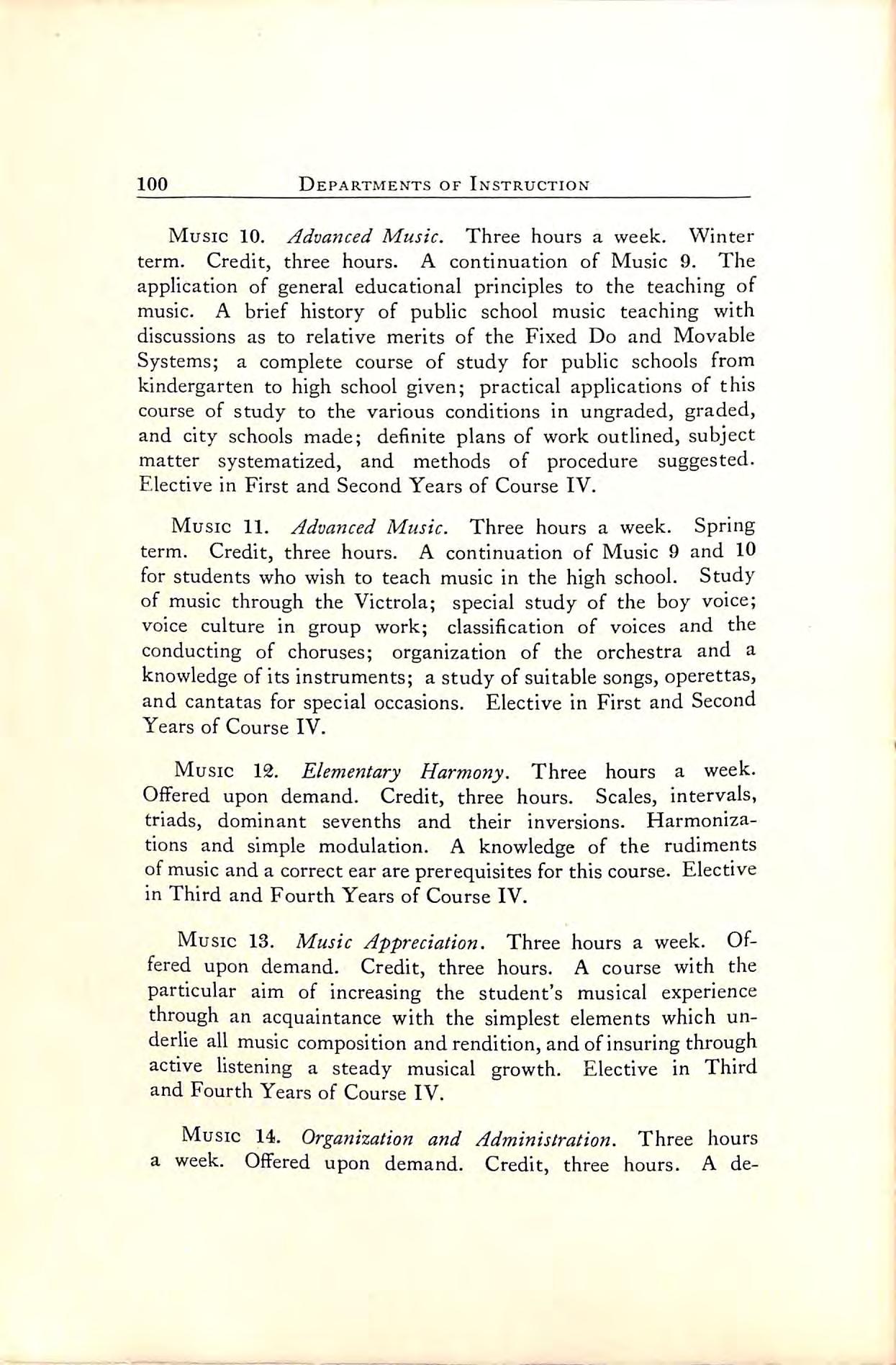
100 Departments of Instruction
Music 10. Advanced Music. Three hours a week. Winter term. Credit, three hours. A continuation of Music 9. The application ofgeneral educational principles to the teaching of music. A brief history of public school music teaching with discussionsastorelativemeritsoftheFixedDoandMovable Systems; a complete course ofstudy for public schools from kindergarten to highschoolgiven; practical applicationsofthis course ofstudy to the various conditionsin ungraded,graded, and city schools made; definite plans of work outlined,subject matter systematized, and methods of procedure suggested. ElectiveinFirstandSecondYearsofCourseIV.
Music 11. Advanced Music. Three hours a week. Spring term. Credit,three hours. A continuation ofMusic9and 10 for students who wish to teach music in the high school. Study of music through the Victrola; special study of the boy voice; voice culture in group work; classification of voices and the conducting of choruses; organization of the orchestra and a knowledgeofitsinstruments; astudyofsuitablesongs,operettas, and cantatas for special occasions. Elective in First and Second YearsofCourseIV.
Music 12. Elementary Harmony. Three hours a week. Offered upon demand. Credit, three hours. Scales, intervals, triads, dominant sevenths and their inversions. Harmoniza tions and simple modulation. A knowledge of the rudiments ofmusicandacorrectearareprerequisitesforthiscourse. Elective in Third and Fourth Years of Course IV.
Music 13. Music Appreciation. Three hours a week. Of fered upon demand. Credit, three hours. A course with the particular aim of increasing the student's musical experience through an acquaintance with the simplest elements which un derlie all music composition andrendition,andofinsuringthrough active listening a steady musical growth. Elective in Third and Fourth Years of Course IV.
Music 14. Organization and Administration. Three hours a week. Offered upon demand. Credit, three hours. A de-
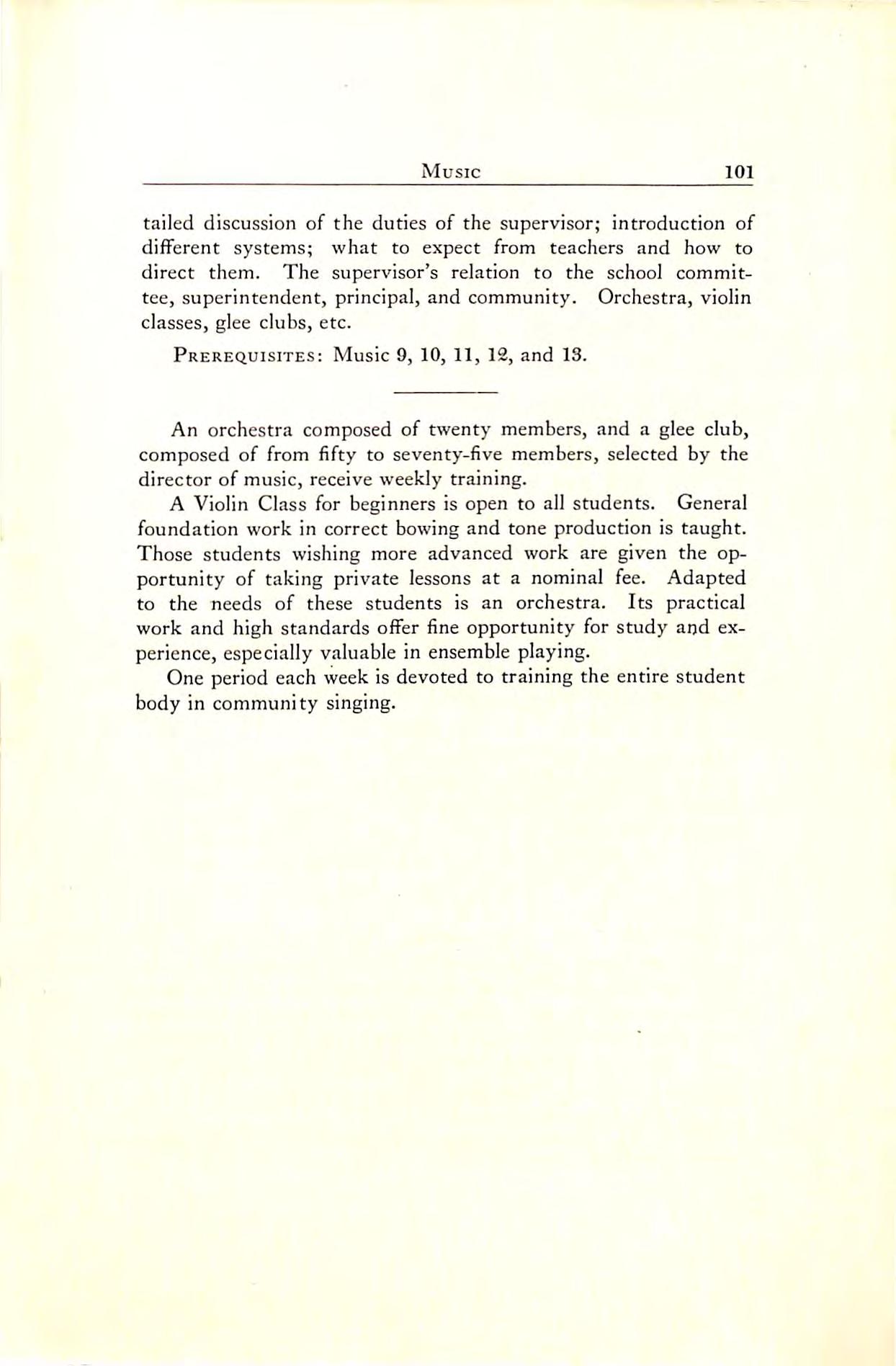
Music
tailed discussion of the duties of the supervisor; introduction of different systems; what to expect from teachers and how to direct them. The supervisor's relation to the school commit tee,superintendent, principal,and community. Orchestra, violin classes,glee clubs,etc.
Prerequisites: Music 9, 10, 11, 12, and 13.
An orchestra composed of twenty members,and a glee club, composedoffrom fiftytoseventy-five members,selected bythe director of music,receive weekly training.
A Violin Classforbeginnersisopen toallstudents. General foundation work in correct bowing and tone production is taught. Thosestudents wishing more advanced work aregiven theop portunity oftaking privatelessons ata nominal fee. Adapted to the needs of these students is an orchestra. Its practical workand highstandardsofferfineopportunityforstudyandex perience,especiallyvaluableinensembleplaying.
Oneperiodeachweekisdevotedtotrainingtheentirestudent bodyincommunitysinging.
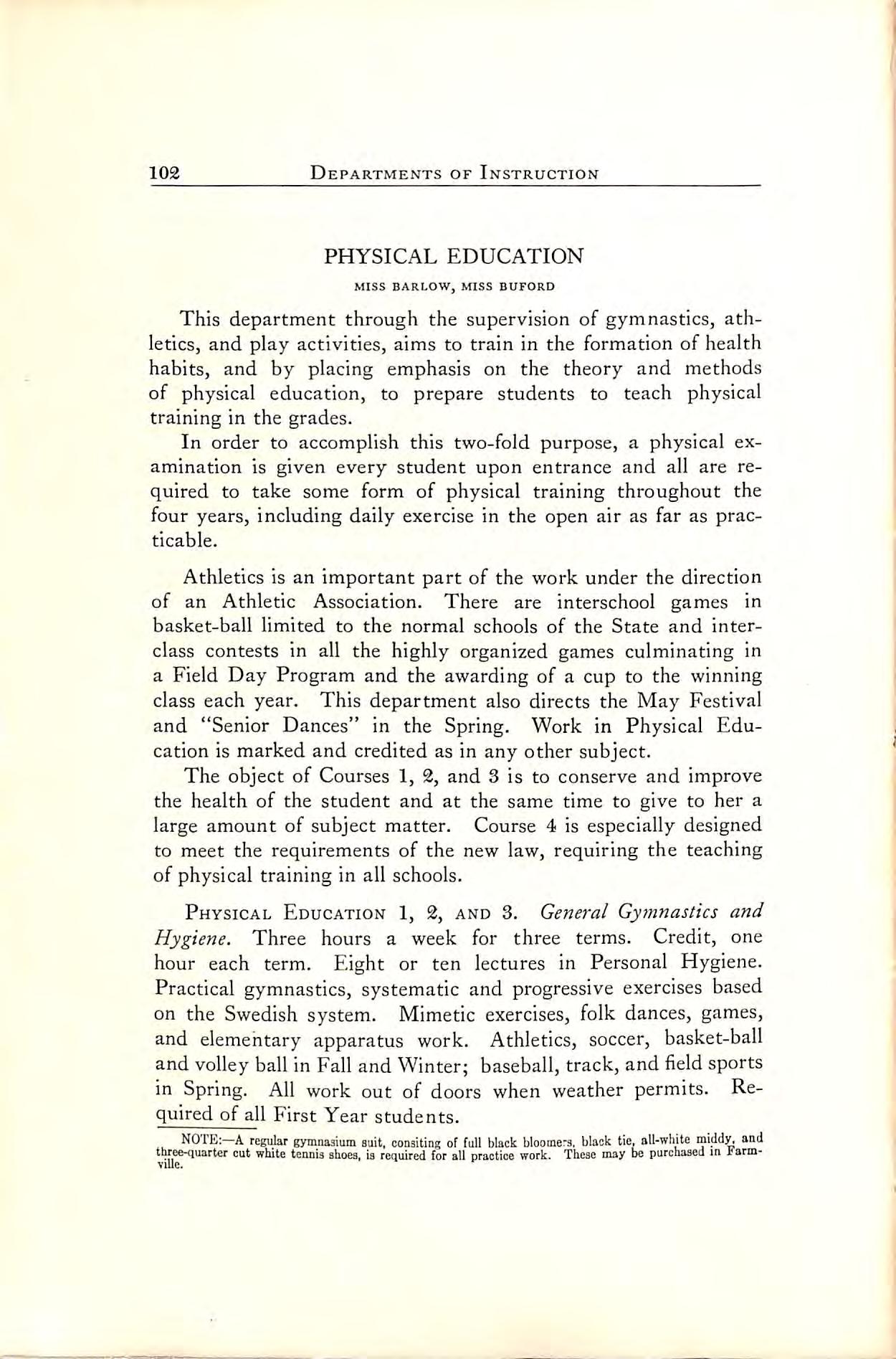
PHYSICAL EDUCATION
MISS BARLOW,MISS BUFORD
Thisdepartmentthrough thesupervisionofgymnastics,ath letics,andplayactivities,aimstotrainintheformationofhealth habits, and by placing emphasis on the theory and methods of physical education, to prepare students to teach physical training in the grades.
In order to accomplish this two-fold purpose, a physical ex amination is given every student upon entrance and all are re quired to take some form of physical training throughout the four years,including daily exercise in the open air as far as prac ticable.
Athletics is an important part of the work under the direction of an Athletic Association. There are interschool games in basket-balllimited to the normalschoolsoftheState and interclass contests in all the highly organized games culminating in aFieldDayProgramandtheawardingofacuptothe winning classeach year. Thisdepartmentalsodirectsthe MayFestival and "Senior Dances" in the Spring. Work in Physical Edu cation is marked and credited asin any other subject.
The object of Courses 1,2,and 3is to conserve and improve the health of the student and at the same time to give to her a large amount ofsubject matter. Course 4 is especially designed to meet the requirements of the new law,requiring the teaching ofphysical trainingin allschools.
Physical Education 1,2,and 3. GeneralGymnastics and Hygiene. Three hours a week for three terms. Credit, one hour each term. Eight or ten lectures in Personal Hygiene. Practical gymnastics,systematic and progressive exercises based on the Swedish system. Mimetic exercises, folk dances,games, and elementary apparatus work. Athletics, soccer, basket-ball andvolleyballin FallandWinter; baseball,track,andfieldsports in Spring. All work out of doors when weather permits. Required of all First Year students.
NOTE:—A remlar gymnMium suit, conaiting of full black bloomers, black tie, all-white ^idJy. and tlwee-quartercutwhiteteanisshoes,isrequiredforsUpracticework. ThesemaybepurchasedinFarmvilie.
102 DepartmentsofInstruction
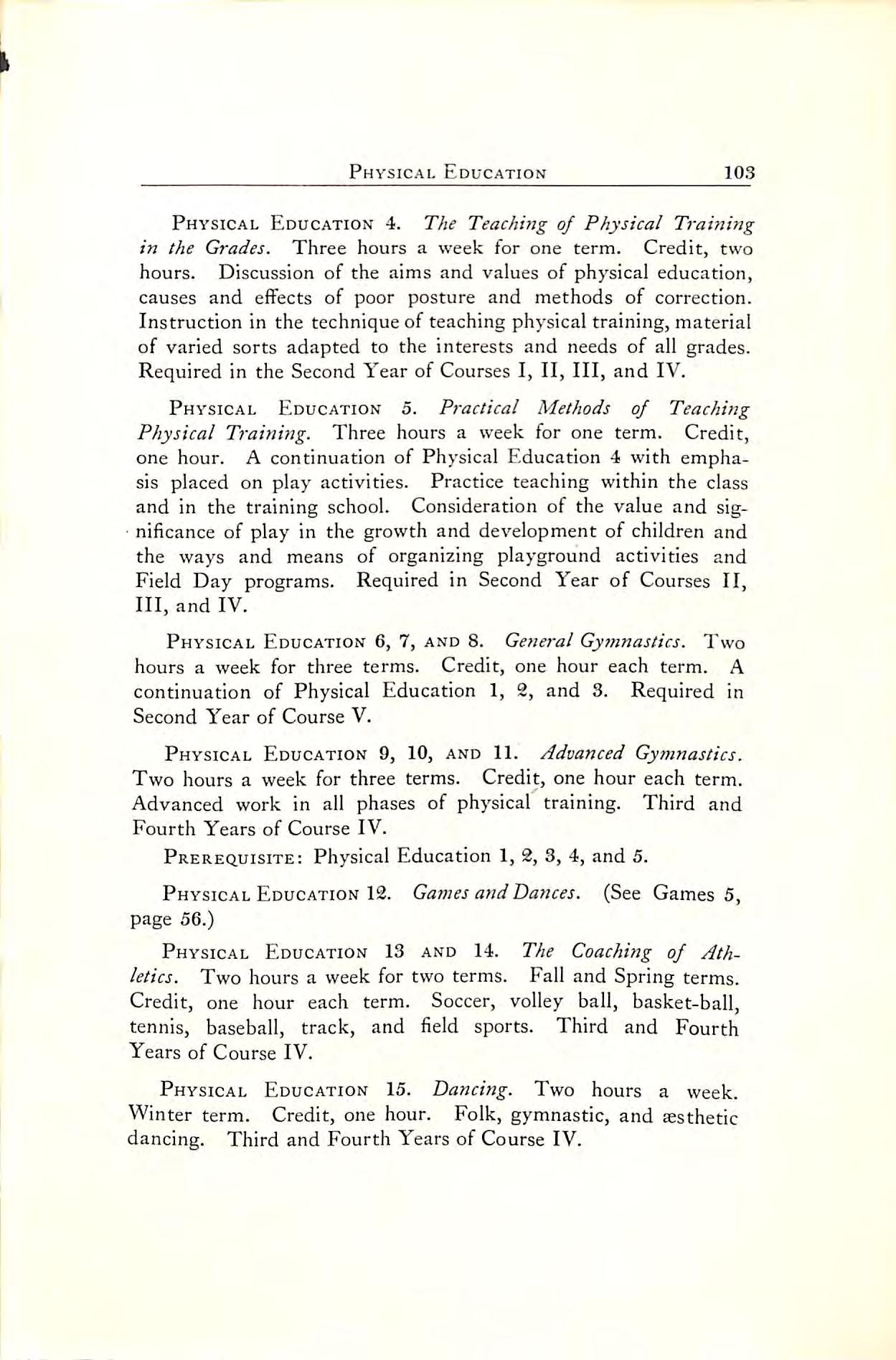
Physical Education 4. The Teaching ojPhysical Training in the Grades. Three hours a week for one term. Credit, two hours. Discussion of the aims and values of physical education, causes and effects of poor posture and methods of correction. Instructioninthetechniqueofteachingphysicaltraining,material of varied sorts adapted to the interests and needs of all grades. Required in the Second Year ofCourses I,II,III,and IV.
Physical Education 5. Practical Methods of Teaching Physical Training. Three hoursa week forone term. Credit, one hour. A continuation of Physical Education 4 with empha sis placed on playactivities. Practiceteaching within theclass andin the trainingschool. Consideration ofthe valueand sig nificanceofplayin thegrowthanddevelopmentofchildren and the ways and means of organizing playground activities and Field Day programs. Required in Second YearofCourses II, in,and IV.
Physical Education 6, 7, and 8. General Gymnastics. Two hours a week for three terms. Credit, one hour each term. A continuation ofPhysical Education 1,2,and S. Required in Second YearofCourseV.
Physical Education 9, 10, and 11. Advanced Gymnastics. Two hours a week for three terms. Credit,one hour each term. Advanced work in all phases of physical training. Third and FourthYearsofCourseIV.
Prerequisite: Physical Education 1,2,3,4,and 5. PhysicalEducation12. GamesandDances. (See Games5, page 56.)
Physical Education 13 and 14. The Coaching of Ath letics. Twohoursaweekfortwoterms. FallandSpringterms. Credit, one hour each term. Soccer, volley ball, basket-ball, tennis, baseball, track, and field sports. Third and Fourth YearsofCourseIV.
Physical Education 15. Dancing. Two hours a week. Winterterm. Credit,one hour. Folk,gymnastic,andesthetic dancing. ThirdandFourthYearsofCourseIV.
Physical Education 103

READING
hnss SPEAR
The aim ofthe reading departmentis to equip thestudent withthepowerofkeenanalysisandtheabilitytoextractthought from theprinted page. Thepupilisled toafurtherrealization ofthemeaningand beautyofliterature bytrainingin adequate vocal expression ofthe best literature.
Reading 1. Foundation Course in Reading. Two hours a week for one term. Offered Fall and Winter terms. Credit, two hours. Aimstogive thestudent distinct articulation,cor rectpronunciation,freedomandeaseinspeakingbeforeagroup, and power in critical analysis. First Year of Courses I,II, and III.
Textbook:Shakespeare'sJuliusCasar.
Reading2. ReadingMethods. Twohoursa week. Winter term. Credit, two hours. A study of the problems involved in the teaching of reading. Practice teaching before the class. Pieces ofliterature chosen and taught the class as models. First YearofCorseIII.
Textbook:Briggs and Coffman's Reading in the Public Schools.
Reading 3. Dramatics. Two hours a week. Winter term. Credit,two hours. A study of the educational value of dra matic presentations in the grades. Dramatization of suitable stories. Lectures and practical experience in stage mechanics anddirectingplays. FirstYearofCourseI.
A dramatic club,composed oftwenty-five or thirty members, chosen from the student body by the process of "trying out," gives opportunity for developing special dramatic talent. Two standard plays are presented each year.
104 DepartmentsofInstruction
TRAINING SCHOOL DEPARTMENT
iPACULTY
Joseph L. Jarman President
W.F. Tjdyman Director and Principal
2MarySaveoge SupervisorinJuniorHighSchool
LessieLea
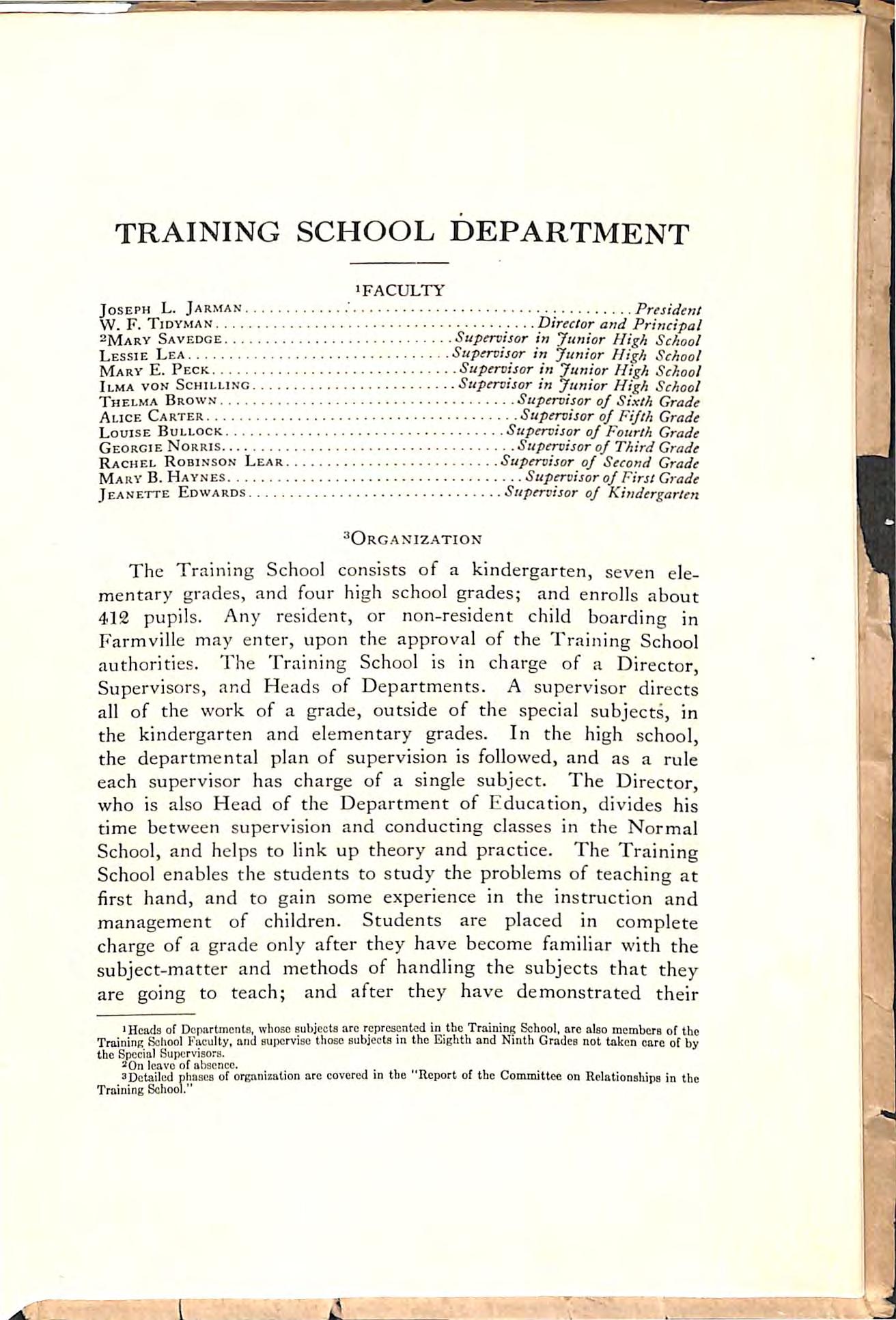
SupervisorinJuniorHighSchool
MaryE.Peck SupervisorinJuniorHighSchool
IlmavonSchilling SupervisorinJuniorHighSchool
ThelmaBrown SupervisorofSixthGrade
AliceCarter SupervisorofFifthGrade
Louise Bullock SupervisorofFourth Grade
GeorgieNorris SupervisorofThirdGrade
RachelRobinson Lear SupervisorofSecondGrade
MaryB.Haynes SupervisorofFirstGrade
Jeanette Edwards Supervisor of Kindergarten
^Organization
The Training School consists of a kindergarten, seven ele mentary grades, and four high school grades; and enrolls about 412 pupils. Any resident, or non-resident child boarding in Farmvilie may enter,upon the approvaloftheTrainingSchool authorities. The Training School is in charge of a Director, Supervisors, and Heads of Departments. A supervisor directs all of the work of a grade, outside of the special subjects, in the kindergarten and elementary grades. In the high school, the departmental planofsupervisionisfollowed,and as a rule each supervisor has charge of a single subject. The Director, who is also Head of the Department of Education, divides his time between supervision and conducting classes in the Normal School,and helps to link up theory and practice. The Training Schoolenablesthestudentstostudytheproblemsofteachingat first hand,and to gain some experience in the instruction and management of children. Students are placed in complete chargeofagradeonly aftertheyhave become familiar with the subject-matter and methods of handling the subjects that they are going to teach; and after they have demonstrated their
'HeadsofDcpartmonta,whoseBubjcctsarcrepresentedintheTrainingSchool,arealsomembersofthe TrainingSchoolFaculty,andsuiwrviscthosesubjectsintheEighthandNinthGradesnottakencareofby theSpecialSupervisors.aOnleaveofabsence. ,, 3Dctailcdphasesoforganizationarecoveredinthe ReportoftheCommitteeonRelationshipsinthe TrainingSchool."
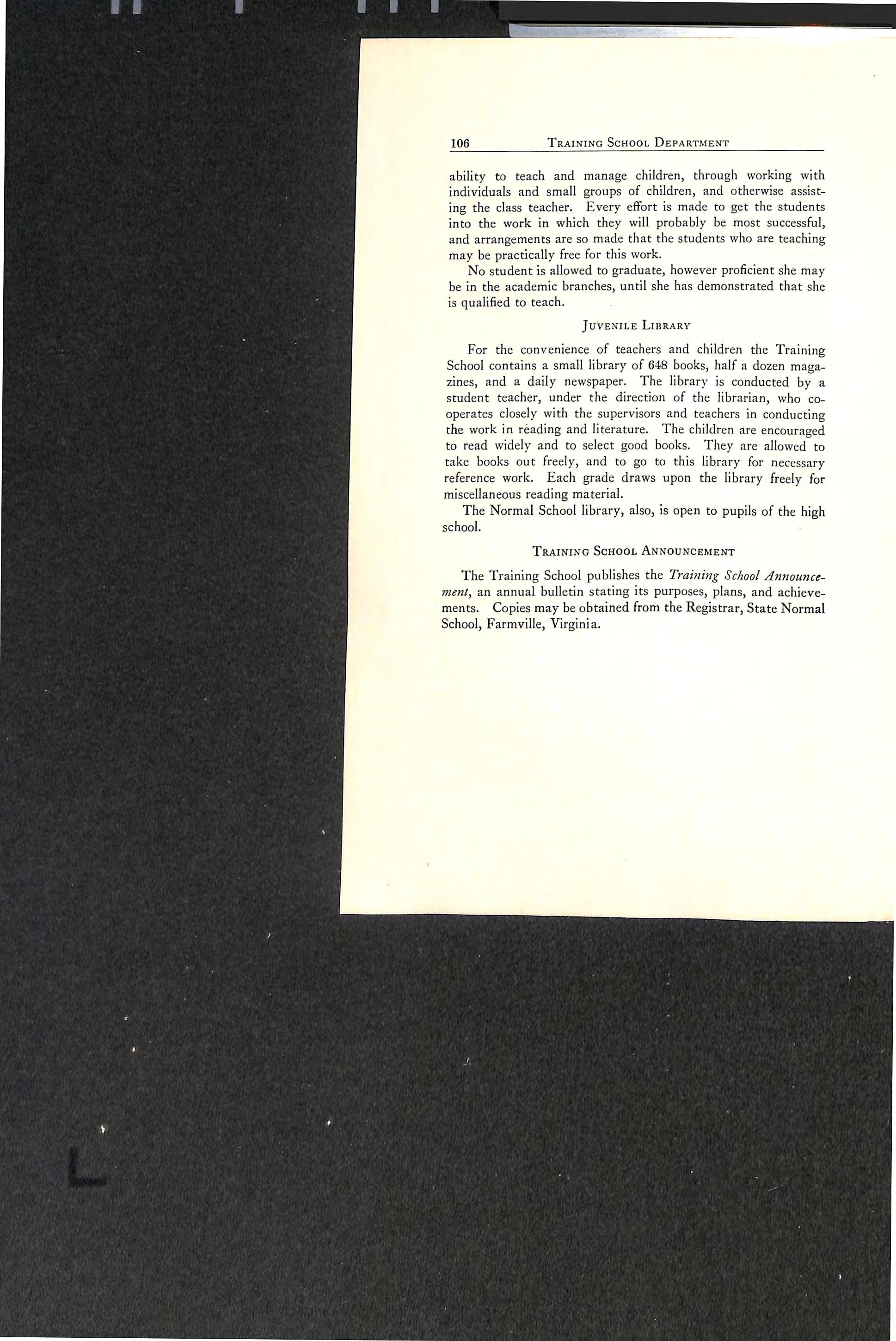
ability to teach and manage children, through working with individuals and small groups of children, and otherwise assist ingtheclass teacher. Everyeffortis madetogetthestudents into the work in which they will probably be most successful, andarrangementsaresomadethatthestudentswhoareteaching maybepracticallyfreeforthiswork.
Nostudentis allowed to graduate,however proficientshe may be in the academic branches, until she has demonstrated that she is qualified to teach.
Juvenile Library
For the convenience ofteachers and children the Training School contains a small library of648 books,halfa dozen maga zines, and a daily newspaper. The library is conducted by a student teacher, under the direction of the librarian, who co operates closely with the supervisors and teachers in conducting the work in reading and literature. The children are encouraged to read widely and toselect good books. They areallowed to take books out freely, and to go to this library for necessary reference work. Each grade draws upon the library freely for miscellaneous reading material.
The NormalSchoollibrary,also,isopen to pupilsofthe high school.
TrainingSchoolAnnouncement
TheTrainingSchoolpublishesthe TrainingSchoolAnnouncementy an annual bulletin stating its purposes,plans,and achieve ments. CopiesmaybeobtainedfromtheRegistrar,StateNormal School,Farmville, Virginia.
106 Training
School Department
Name
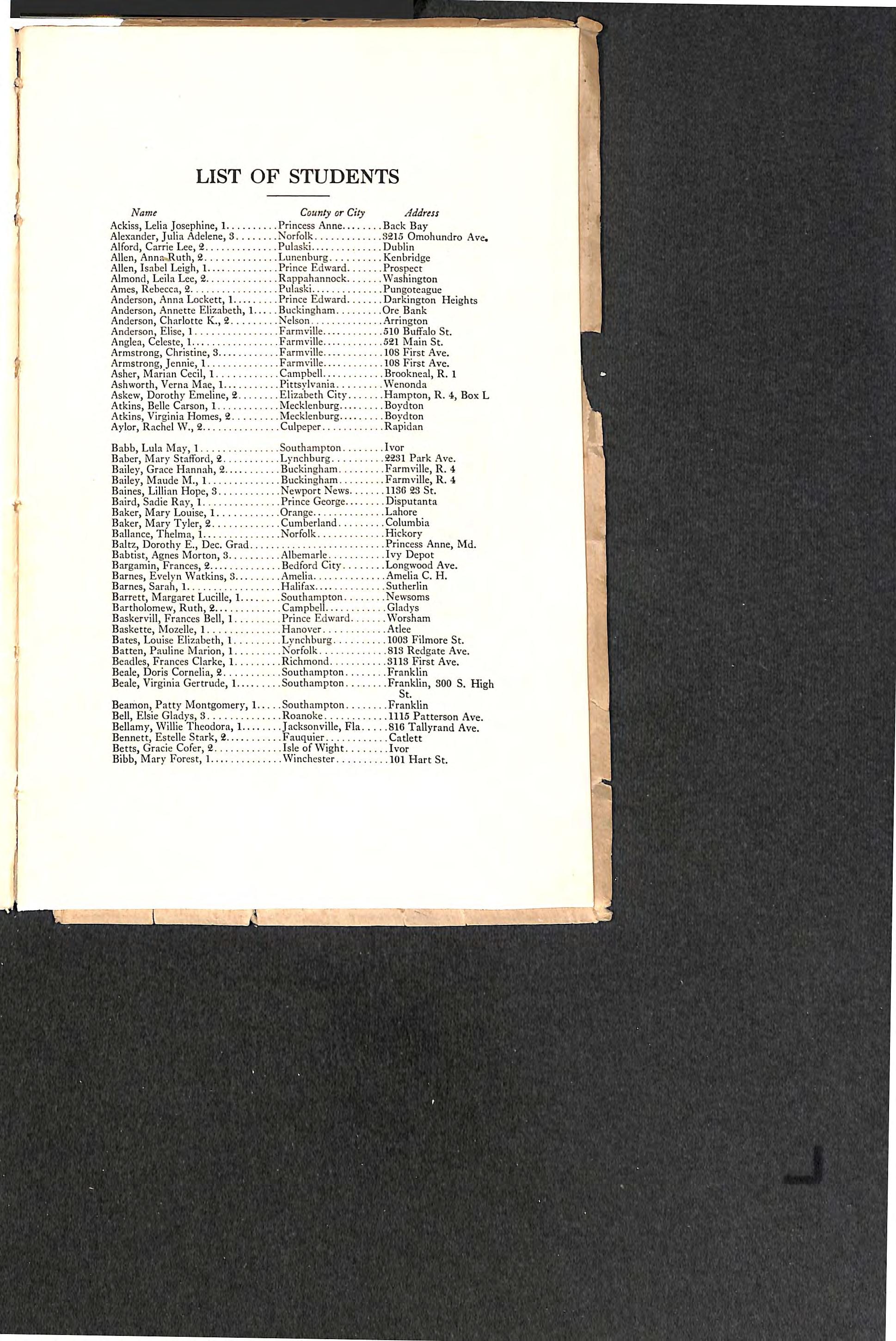
LIST OF STUDENTS
Ackiss,LeliaJosephine,1
CountyorCity Address
PrincessAnne BackBay Alexander,JuliaAdelene,3 Norfolk 8215OmohundroAve, Alford,CarrieLee,2
Pulaski Dublin Allen,AnnaJ^uth,2 Lunenburg Kenbridge Allen,IsabelLeigh,1
PrinceEdward Prospect Almond,LeilaLee,2 Rappahannock Washington Ames,Rebecca,2
Pulaski Pungotcague Anderson,AnnaLockett,1
PrinceEdward Darkington Heights Anderson,AnnetteElizabeth,1 Buckingham OreBank Anderson,CharlotteK.,2 Nelson Arrington Anderson,Elise,1
Farmville 510BuffaloSt. Anglea,Celeste,1
Farmville 621 Main St. Armstrong,Christine,3
Farmville 108FirstAve. Armstrong,Jennie,I Farmville 108FirstAve. Asher,MarianCecil,1 Campbell Brookneal,R.1 Ashworth,Verna Mae,1 Pittsylvania Wenonda Askew,DorothyEmeline,2 ElizabethCity Hampton,R.4,BoxL Atkins,BelleCarson,1 Mecklenburg Boydton Atkins,VirginiaHomes,2 Mecklenburg Boydton Aylor,RachelW.,2 Culpepcr Rapidan
Babb,LulaMay,1 Southampton Ivor Baber,MaryStafford,2 Lynchburg 2231ParkAve. Bailey,GraceHannah,2 Buckingham Farmville,R.4 Bailey,MaudeM.,1 Buckingham Farmville,R.4 Baincs,LillianHope,3 NewportNews 113623St. Baird,SadieRay,I PrinceGeorge Disputanta Baker,MaryLouise,I Or.ange Lahore Baker, Mary Tyler,2 Cumberland Columbia Ballance,Thelma,1 Norfolk Hickory Baltz,DorothyE.,Dec.Grad PrincessAnne,Md. Babtist,AgnesMorton,3 Albemarle IvyDepot Bargamin,Frances,2 BedfordCity LongwoodAve. Barnes,EvelynWatkins,8 Amelia AmeliaC.H. Barnes,Sarah,1 Halifax Sutherlin Barrett,MargaretLucille,1 Southampton Newsoms Bartholomew,Ruth,2 Campbell Gladys Baskervill,FrancesBell,1 PrinceEdward Worsham Baskette,Mozelle,1 Hanover Atlee Bates,LouiseElizabeth,1 Lynchburg 1003FilmoreSt. Batten,PaulineMarion,1 Norfolk 813RedgateAve. Beadles,FrancesClarke,1 Richmond 3113FirstAve. Beale,DorisCornelia,2 Southampton Franklin Beale,VirginiaGertrude,1 Southampton Franklin,300S.High St.
Beamon,PattyMontgomery,1 Southampton Franklin Bell,ElsieGladys,3 Roanoke 1115PattersonAve. Bellamy,WillieTheodora,1 Jacksonville,Fla 816TallyrandAve. Bennett,EstelleStark,2 Fauquier Catlett Betts,GracieCofer,2 IsleofWight Ivor Bibb,MaryForest,1 Winchester 101HartSt.
k
Name
CountyorCity Address
Bilisoly,VirginiaIsobel,1 Portsmouth 1023"A"St. Blair,MarthaBeavers,1 Pittsylvania Danville,R.0 Bland,MaryLouise,1 KingandQueen Cologne Blankenship,HattyeMyrtle,2 Wise Appalachia Blankenship,Lennie,3 Wise Appalachia Blanton,EdnaYoung,2 Powhatan Ballsville Blanton,LucieReed,1 Powhatan Tobaccoville Bolen,MaryGeorge,4 Culpeper Culpcper,R.1 Bondurant,VirginiaWalton,2
PrinceEdward Rice Bonnewell,GenevieveHoward,2...Warwick Morrison Booker,MaryElizabeth,2
PrinceEdward Pamplin Booth,FlorenceHaines,1 Danville 114HolbrookAve. Bowden,MarthaFarinholt,1 KingWilliam WestPoint Bowden,Mary Elizabeth,1 Norfolk 731 Yarmouth St. Bradley,ElizeEugenia,2 Albemarle University Brady,ElizabethGodwin,1 Nansemond Suffolk,R.4 Branche,EthelClaire,1 Southampton Ivor Brett,Lina Walton,1 Portsmouth 2208 King St. Brett,MarthaElma,2 Southampton Newsoms Britton, Mabel Claire,1 Norfolk 504 Graydon Park Brockman,F.lsieChristine,1 Amherst Amherst Brothers,Mildred,1 Norfolk Hickory Brown,Evelyn Maye,1 Appomattox Appomattox Brown,Hester Peebles,S Prince George Disputanta Brown,Katherine Loften,1 Buckingham Dillwyn Brown,Lucy Reid,2 Rappahannock Woodville Brown,Susan Field,1 Sussex Jarratt Browning,Mildred Berkeley,2 Orange Orange Bryant,MaryLewis,2 Amherst Sandidges Bugg,MaryElizabeth,1 Farmville 701HighSt. Burch,Mrs.Berkeley Gregory,1...Halifax Clover A Burnette,ViolaGillaspie,1 Lynchburg 1422FillmoreSt. i Burrow,LeliaPeebles,4 PrinceGeorge Disputanta ) Busch,RubyEleanor,1 Allegheny Covmgton,Box273 Butler,FrancesDunn,2 CliftonForge 200R.dpwaySt. Butler,IreneHenrietta,1 IsleofWight Carrsville Button,SallieElizabeth,2 Culpeper Rixeyville
Calcott,EmilySinclair,3 Norfolk 201MapleAve. Callaway,AnnaLouise,1 Lynchburg 351NorfolkAve. Camper,Ethel Marion,4 Orange Orange Carico,Agnes,1 Grayson Carlson,EllenSofia,4 Surry Claremont Carrington, Mary Emma,1 Nelson „ . Carroll,Kathleen McCarthy,2 Charlottesville Carter,Alice Louise,1 Albemarle ^ Carter,JessieKatharine,2 Martinsville 14L.ChurchSt. Carter,Sarah Ann,1 Nelson Carter,Virginia Armistead,1 Mecklenburg Boydton Carwile,EdwinaGrey,1 PrinceEdward Madisonvme Cathey,MabelAllen,1 Norfolk. 227E-42St. Cave,Julia Wolbert,2 Charlottesville i i Chapman,AnnieLucy,1 New Kent Barl^msville Chapman,Pauline,2 Roanoke 417DaleAve.,S.h. Chappell,ElizabethJ.C,2 PrinceEdward 5!^. Chick,MargieLouise,1 Cumberland GuineaMills
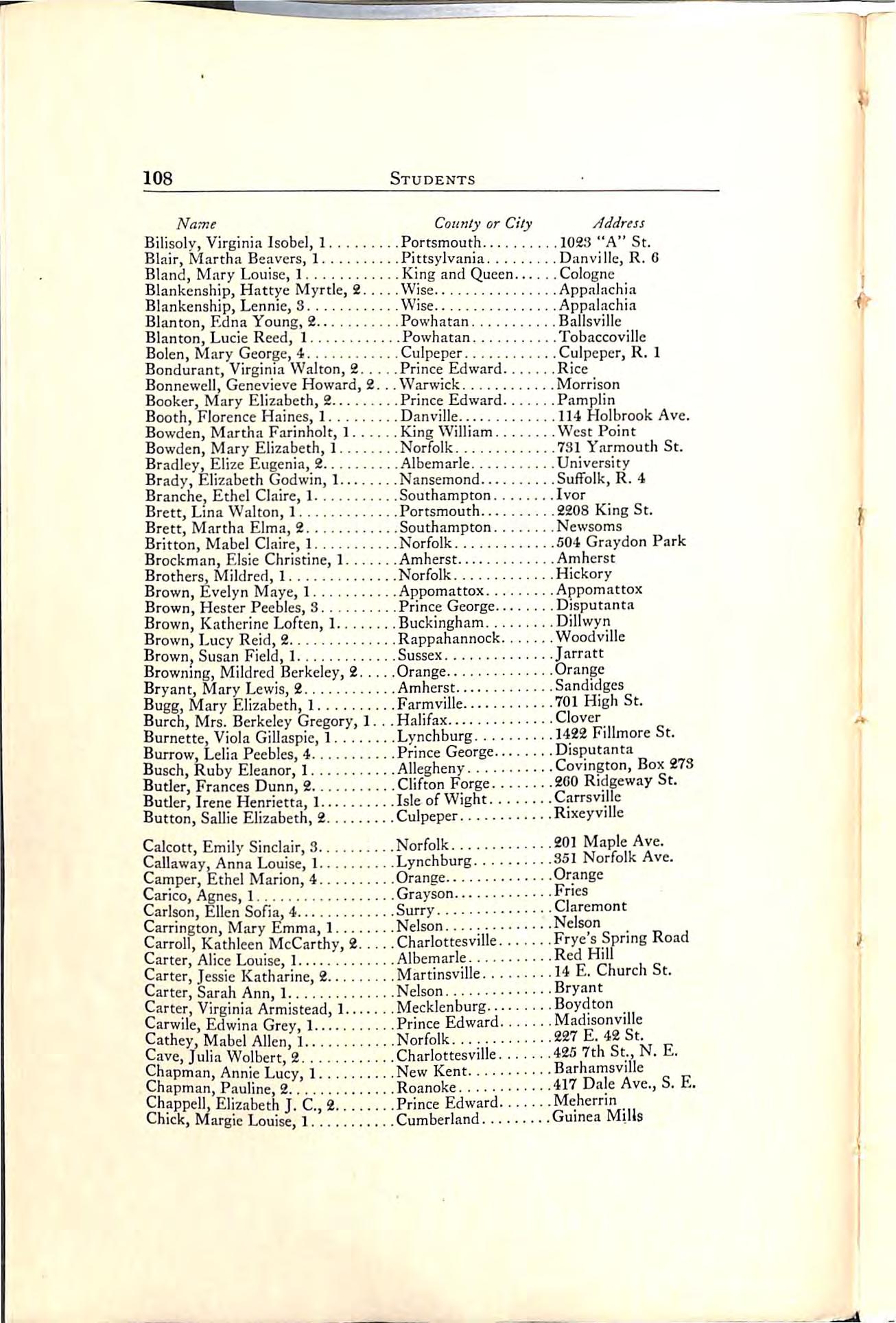
108
Students

Name CountyorCity Address
Childress,Lois,2 Roanoke 4225thSt.,S.E. Christie,EdnaMae,1 NewportNews 7.^927thSt. Christopher,Virgini.a,1 Northumberland Waddeys Clanton,Elizabeth,1 Patrick Stuart Clark,.AudreyElodye,1 Northumberland Remo Clarke,MaryWilkinson,2 Amelia .AmeliaC.H. Clarkson,MarionLemmie,S Augusta MountSolon Claud,EulaMargarette,Dec.Grad.Southampton Drewryville Clayton,MaryBelle,1 Southampton Ivor Cleasby,Violet,2 KingWilliam WestPoint Cleaton,Mary Davis,1 Mecklenburg LaCrosse Cleland,Ruth,1 Lynchburg 219NorfolkAve. Cobb,Frances,1 Farmville 401 SpruceSt. Cobbs,MildredF.,1 Pittsylvania Callands Cochran,Doris,I Greensville Emporia Cogbitl,Ardcllc,2 Mecklenburg Boydton Cogbill,Elizabeth,1 Petersburg 244LawrenceSt. Coghill,ElizabethEugenia,1 Caroline BowlingGreen Cole,ElizabethRebecca,1 Roanoke 6297thAve.,S.W. Coleman,Elizabeth,2 Northumberland Tibitha Coleman,HarrietEmbry,1 Mecklenburg Boydton Colonna,LeliaRandoph,2 Hampton 21BayleySt. Conway,DelmaClare,2 Northumberland Byrdton Cooke,AnnieLouise,2 Southampton Newsoms Cooper,Frances,1 Nashville,Tenn 901ArthingtonAve. Corley,Louise,2 Winnsboro,S.C.,Bojc 261
Cosby,Lois Lee,1 Roanoke 516 Bellvill Road, RaleighCourt Cousins,MaryClement,1 Danville Danville,Box444 Cox,RuthAmandus,1 Farmville 803BuffaloSt. Craft,Susi^2 Charlottesville 100E.MarketSt. Crawford,ElizabethMcDowell,1...Dinwiddie Reams Cr.-iwley,JaneMadison,1 Cumberland Farmville,R.F.D. Crockin,Frieda,1 Portsmouth 419LondonSt. Crowder,IsabelGladys,2 Mecklenburg JefFress Grumpier,MaryGertrude,2 Suffolk 107LindenAve. Crute,KathleenGordon,2 Cumberland Farmville,R.1 Daniel,MaryMargaret,1 Middlesex Nohead Daniel,MaryRegina,1 Farmville 401ChambersSt. Daniels,KatherineHawthorne,1...Brunswick Danieltown Darden,IndiannaUnderwood,2....IsleofWight Smithfield Davies,NellieLoomis,3 Farmville Box33 Davis,ElizaBruce,3 Halifax Paces Davis,MargaretLouise,1 Warwick HiltonVillage Davis,MaryElizabeth,I Franklin Henry Day,Louise,2 CliftonForge 62JeffersonAve. Day,Margaret,1 Waynesboro 528 Chestnut Ave. Deaver,PaulineFrances,1 Lexington 98S.MainSt. Dedmon,AliceRebecca,2 Mecklenburg ChaseCity Dickenson,Irma,2 W.ishington Wallace Dickcrson,GraceTruman,2 Lunenburg Kenbridge Dickerson,Virginia,1 Patrick ...Stuart Diehl,DorothyNevin,3 Farmville 401HighSt. Diehl,ElizabethKready,1 Farmville 401HighSt.
Students 109
Name
Students
CountyorCity Address
Disharoon, Alice May,1 Northampton Cape Charles , Dortch,Marrie,1 Mecklenburg Union Level j Draper,RuthElizabeth,1 Charlottesville Fry'sSpringRoad a Doling,ElizabethThomas,2 Appomattox Pamplin T Duling,MabelVirginia,2 Appomattox Pamplin Dunning,Roxie,2 Suffolk 201CentralAve. '
Easley,EllenCelestial,2 Pittsylvania Chatham j Edwards,AbbyeMay,1 Mecklenburg ChaseCity
Edwards,MabelJacqueline,1 Norfolk 820E.28thSt. Egleston,MaryNevins,1 Norfolk 740RedgateAve. Elliott,FrancesLee,1 Bedford 700BaltimoreAve. Eubank,ElizabethFord,1 Charlotte Keysville Eustace,Fannie Mason,1 Fauquier Calverton Eustace,HallieLucie,1 Fauquier Calverton Evans,CharlieChristine,1 Nelson Lovingston Evans, Frances Irving,3 Amelia Amelia C. H. J
Faison,Sara Lee,1 Sussex Wakefield ' Farrar,AnnieRay,1 Charlotte DrakesBranch Farrar,LucileMarie,2 CliftonForge 69AUeghanySt. Field,HelenStadon,I Asheville,N.C 39ChestnutSt. Finch,MargaretGoode,2 Mecklenburg ChaseCity Fitch,HelenLeake,2 Lynchburg 810CourtSt. Fletcher,Doris,2 Accomac Parksley Floyd,SusieVann,2 Warwick HiltonVillage Folk,MaryLee,1 Nansemond Suffolk,R.F.D. Folston,Sylvia,1 Norfolk 4517MyersAve. |
Forbes, Christine Nowlin,1 Roanoke 702Stewart Ave.,S.E. i Forbes, Mary Venable,2 Cumberland Farmville, R.F. D. U Ford,Florence Virginia,2 Brunswick Kingsford Ford, Marion Emma,2 Brunswick Kingsford Foster,AnnaElizabeth,1 Mathews Grimstead Foster, Christine Lee,1
Prince Edward Pamplin,R. F. D. Foster,Katherine,Estelle,2 Farmville 531PineSt. I Foster,LeliaWhite,1
PrinceEdward Farmville ' Fowlkes,ThelmaAdele,1 Dinwiddie Ford i Fox,Virginia,2 King William Aylett Fraser,NellieGray,1 Nottoway Crewe i Fray,Emma Katherine,2 Madison Madison | Friend, Mary Bruce, 1 AUeghany Covington Fuqua,Mary Elizabeth,2
Prince Edward Prospect Gable,Catherine,2 Albemarle Covesville | Galloway,EllenMargaret,1 Tazewell Graham Gannaway, Alice Cabell,2 Pulaski Draper v' Garden,ElizabethBeverly,2
PrinceEdward Prospect | Garden,Lucile, 1
Prince Edward Prospect | Garden,Susie Cathryn, 1
Prince Edward Prospect Garland, Mary Freear,S Farmville 205 High St. Garnett,EdnaGertrude,2 Farmville IllBridgeSt. Garter,Mary Lee,1 Sussex Stony Creek J Gibson,Dorothy Lee,1 Charlottesville 612 Maple Ave. Gilchrist, Annie Claudia,3 Columbia,S. C 928 King St. Gillette, Elizabeth, 1 Southampton Adams Grove Gilliam,Janie Fleet,1 Charlotte Phenix
Gilliam, Mary Loften,2 Sussex Yale

110
i
' j,
I
Name CountyorCity Address
Gills,EdithGoode,1 Powhatan Powhatan
Gilme^ Louise Cabell, March Grad.Lynchburg 228 Norfolk Ave.
Gish,Ethel May,1
Glenn,Helen Janie,I

Lynchburg 481 Rivermont Ave.
PrinceEdward Prospect Glenn,Louise,8
Prince Edward Prospect Glenn,MargaretRay,2
PrinceEdward Prospect Goodman,Daisy Rose,2 Portsmouth 202MiddleSt. Goodwin,MarthaDabney,2 Albemarle Scottsville Grant,FrancesM.,1 Clarksburg,W.V....HeleneApts.,W.Main St.
Gravely,CassieEdith,1 Henry Martlnsville Gravely,MaryPermelia,1 Henry Martlnsville Gray,ElsieMcNena,2 Southampton Boykins Greathead,VirginiaMarshall,1....Norfolk 31734thSt. Gregory,LouMcCargo,4 Lunenburg Ontario Griffin,Gladys,1 Lynchburg S3HillcrestApts. Griffin,LillianVirginia,2 Nansemond Chuckatuck Griffin,MildredElizabeth,Dec. Grad IsleofWight Windsor Grigg,LauraVashti,2 Richmond 3113SecondAve. Grimes, Margaret May,1 South Norfolk 76 Jackson St. Grizzarcl,EthelMauzy,1 Southampton Branchville Guthrie, Martha,2 Buckingham Guinea Mills
Haden,Virginia W.,2 Albemarle Crozet Hailey, Elsie Mae,2 Charlotte Drakes Branch Hall,Henrietta Williamson,1 Norfolk Norfolk,R.4 Hall,IdaMildred,2 IsleofWight IsleofWight Hall,MildredPaulina,1 Middlesex Wake Hancock,Emma,1 Bedford Huddleston Hardy,Nellie,2 Lunenburg Victoria Hardy,SallieKate,1 Bedford Bedford,R 1
Harmon,Zernie Pearl,2 Covington 8 Sunset HiU Harper,Sadie K.atherine,3 Rockmgham MountClinton Harris,Bernice Crocker,1 Portsmouth 126Broad St. Harris, Eula Briggs,2 Brunswick Harris,Laura Fr.ances,1 Mecklenburg South Hill Harris,Lucile,2 Charlotte Keysville Harrison,EvelynByrd,I Mecklenburg LaCrosse Harrison,Iva Valentine,1 Middlesex Wake Harvey,MyrtleElizabeth,2 Lynchburg 1311MadisonSt. Healy,KatherineWinifred,1 Lynchburg 1515GraceSt. Heatwole,RubyeLucille,2 Covington 14u CourtSt. Heflin, Clara Virginia,2 Loudoun Hill,Dama,2 Culpeper Hill Ida,2 Culpeper Mitchells Hill'Nellie Moore,1 Amherst Sandidges Hillsman,MaryElizabeth,1 Amelia Jetersville Hines,Annie Kate,1 Halifax... Clarkton Hinton,RuthEstelle,1 Richmond Farnham Hodgkin,RobertaDay,8 Fauquier Warrenton. Hodnett,MarthaAlise,1 Halifax fu;herlin Hogge,Lucille,2 Gloucester. Wicomico Holland,AmyLolys,2 HeofWight Windsor Holland,StellaBarton,1 IsleofWight Windsor Holmes,Mabel A.,1 Mecklenburg Union Level
111
Students
Name
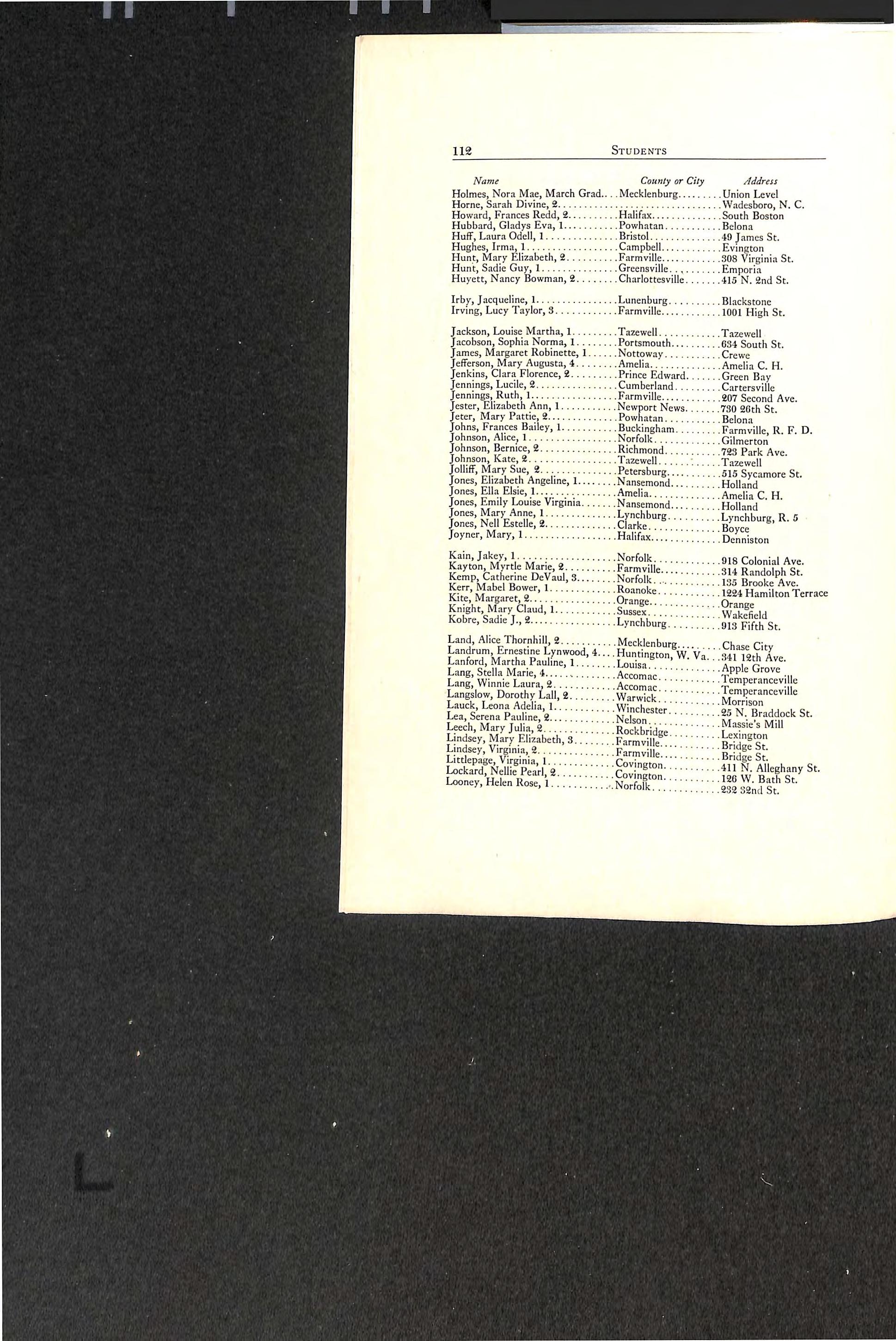
CountyorCity Address
Holmes,NoraMae,MarchGrad.. .Mecklenburg UnionLevel Home,SarahDivine,2 Wadesboro,N.C. Howard,FrancesRedd,2 Halifax SouthBoston Hubbard,GladysEva,I Powhatan Belona Huff,LauraOdell,1 Bristol 49JamesSt. Hughes,Irma,1 Campbell Evington Hunt, Mary Elizabeth,2 Farmville 308 Virginia St. Hunt,Sadie Guy,1 Greensville. Emporia Huyett,Nancy Bowman,2 Charlottesville 415 N.2nd St.
Irby,Jacqueline,1 Lunenburg. Irving,LucyTaylor,3 Farmville.. .Blackstone .1001 High St.
Jackson,LouiseMartha,1 Tazewell Tazewell Jacobson,SophiaNorma,1 Portsmouth 634SouthSt. James,MargaretRobinette,1 Nottoway Crewe Jeilerson,MaryAugusta,4 Amelia AmeliaC,H. Jenkins,ClaraFlorence,2 Prince Edward Green Bay Jennings,Lucile,2 Cumberland Cartersville Jennings,Ruth,1 Farmville 207 Second Ave. Jester,ElizabethAnn,1 NewportNews 73020thSt Jeter, Mary Pattie,2 Powhatan Belona Johns,FrancesBailey,1 Buckingham Farmville,R.F.D. Johnson, Alice, 1. Norfolk Gilmerton Johnson,Isernice,2 Richmond 723 Park Ave Johnson, Kate,2 Tazewell Tazewell Jolliff,MarySue,2.. .. Petersburg 515SycamoreSt. Jones,Elizabeth Angeline,1 Nansemond... Holland Jones,EllaElsie,1 Amelia AmeliaC H Jones,EmilyLouiseVirginia Nansemond... Holland
Joyner, Mary,1 Halifax .Boyce .Denniston
Kaytoi, Myrtle Maria,2 Farmiuie ? 4 R I f h sf' Ktmp,Catherine DcVaul,3 Sik Randolph St. Kerr,MabelBower,1...... Roanoke oLH° n T Kite,'Margrtret,2..'.!!!!!iSran°ln.terrace KSa''s" ' wSld Kobre,SadieJ.,2 Lynchburg 913pifthSt. Land,AliceThornhill,2 Mecklenburg.... ChaseCirv !;a^tTKfrh?Ku'ir„":r'''••• ■ Lang,StellaMarie,4.... I' ■„ Lang, Winnie Laura, 2 AcSmae Temperancev. e Langslow, Dorothy Lall, 2 Warwick Temperancevillc Lauck, Leona Adelia, 1 Winchester.'.' !! ! M n" Braddock St Lea, Serena Pauline, 2 Nelson Leech,MaryJulia,2 !''Rockbridce Lindsey. Mary Elizabeth, 3 Farmville Bridge S? vTrgini!'1 ^^■BHdg
Looney,Helen Rose, 1 Norfolk ;232 Sncl St
112
Students
}r::L-:::::::::::'
J<lame

CountyorCity Address
Luck,Dorothy,1 Hanover Ashland Lyne, Nancy Moncure,1 Orange o •Lyons,DorothyCatherine,1 Petersburg 320N.WestSt.
McArdle,NellIsabel,3 Norfolk. Norfolk,R.1,Box130 McDufRe,MargaretAgnes,3 Columbia,S.C 928K'ngbt. McNamee,ViolaLouise,2 Farmville 208Second Ave. Marshall,ThelmaMarguerite,1....Botetourt Buchanan Martin,Janie,1 Charlotte Cullen Mason,AliceLeigh,1 Petersburg Mason,EvelynDoughty,1 Craddockville Mason,MargaretDabney,2 Mecklenburg Uarksviile Mason,Min Mac,MarchGrad Giles.. Pearisljurg Masten,Virginia,1 Lunenburg .u ..i Matthews,MargaretMitchell,2 Norfolk. 70-Olnej Road Maupin,Mary,2 ^bemarle A Mavs,Mabel,1 Portsmouth 315VSeb^erAve. Meeder,Pauline Caroline,1 "j % Meeks, Cora Helen, 1 P/ince Edward Farmville, R.3 Meredith,AnneShelton,4 f Merryman,JosephineFrances,1....Campbell Rustburg Micks,Magruder,1 u Miller,Florence,2 i w'®? f Miller, Helen Thomas,2 Rappahannock Washington Miller Margaret Cornelia,1 G.lea -Newport^
mISII:?a"Je Me,iV.:!!!!:'.! iSussex.; Jarratt Mitchell,FlossieRuth,2 Greenville Moir, Catherine Burton,2 V n"r N W Moore. Estelle Holmes.1 ?' '' PriLfct Moore, Gladys Rebecca,2 ^'-11. .11'.::'.SlTK Ridge St.
M^re:Lula Ardelie, 2.; MecMcnburg Clarksrille Moore,NellieEstelle,1.^£Se!!!.'i.dlOIndS?. Moore, CoSnbia,S.C 1424 Washington St. Morpn,Kathleen C. M.,2 parmville 416 Virginia St. Moring, Mary Elizabeth,4 harmv Montpelier Station Morns,MaryLouis1 Virgilina,Va. Morrow,Caroline, ' rr<»u/p S:losr;,'^S?e\SE-.-.::::::Br-«if ::■KGhdTs'f :pS^vania Chatham MosS:jose/hine'Agnes,1 Nottoway...........Cre™^^ ^ Moss,FayAnita, pittsylvania Chatham Motley, Agnes Rebecca, 2 J ^ ^ en '• .Ro'^kc WoodsAve. Mundy,Aleen, --- Farmville 315PineSt. Munoz, Harriet Judson, 3 Nottoway Blackstone Murdoch, Catherine, „ , PAvkinci
Myrick, Lucile Frances, 2 Southampton Boykins
Newell, Annie Elizabeth, 1 Sussex Homeville Newell, Susie Virginia, 1 Sussex Homeville
•Deceased.
Students 113
ti 4 i-"'

CountyorCity Address
Nichols,Mary,4 Petersburg 227StAndrewsSt. Noel,Grace,1 Farmville 523MainSt.
Noell, Addle Annie,1 v ;• "'xt' c®
Norman,ElizabethHill,1 Winston-Salem,N.C.6USpringSt. Norman,Nellie Virginia,1 Culpeper,R 2 Nunn,Lillian,1 Farmville 205SpruceSt
Obenshain,Gretchen,2 Botetourt Buchanan Odom,MiriamElizabeth,1 Nansemond Driver Ogburn,AlmaHaynie,1 BridgeSt. Ogden,Elizabeth Morton,2 Bedford Coleman Falls
Palmer,EvaLucile,1 Richmond 224E.13thSt.
Parker Bessie Lou,1 Cumberland Cartersville Parker'May Colgin,1 NewportNews 12227thSt. Parker,Mildred Conway,2 Franklin 103High St. Parker,Sue Brown, March Grad—Sussex Littleton Parker,Thelma Irene, 1 Sussex Stony Creek Parr, Catherine Rose, I Amherst Pedlar Mills Parsons,Mary Louise,2 Petersburg 701 Harrison St. Paylor, Elizabeth Odelle, 1 Sussex Wakefield Payne, Caroline Mortimer,2 Roanoke 703 Denniston Ave. Payne,Olive,2 Prince Edward Darlington Heights Pearman, Elizabeth Catharine,2...Ronaoke ;335 Elm Ave.,S. W. Pearson,Florrie Gay,1 Brunswick Lawrenceville
Pease, Anne Vivian, 1 Columbus,Ga 1438 3rd Ave. Peebles, Hester Elizabeth,2 Sussex Waverly Peirce, Flementine Ball,2 Lancaster Nuttsville Perry,Anne Glenn,2 Mecklenburg Chase City Peters, Ellen Gertrude,2 Southampton Franklin Phenix, Kathryne,1 Nottoway Crewe Phillips, Catherine Mary,1 Warwick Hilton Village Phillips, Cora Mildred,2 Prince Edward Pamplin Phillips, Martha Lauretta, 1 Warwick Hilton Village Phipps, Jettie,2 _ Dickenson Clintwood Phipps,M.irgaret Rebecca Daniel,1 Beckley, W.Va.,Box 696
Pierce,ElizabethAgnes,1 Nansemond Buckhorn Piercy,MayGeorgie,1 Loudoun Purcellville Pike, Helen Elizabeth,2 Roanoke Roanoke,R.3, Box 52 Pittard,Jessie Lee,2 Mecklenburg Buffalo Junction Pollard,MarionGarnett,1 Buckingham Sheppards Ponton,HattieLeGrande,1 Charlotte Ontario Porter,AlmaWrenn,I Powhatan FineCreekMills Potter,Janie Maclin,2 Buckingham Dillwyn Powell,JeanDickerson,1 Patrick Stuart Powell,OliveFerguson,2 Accomac BelleHaven Price, Ruby Pearl, 1 Cumberland Farmville,R.5 Price, Viola Myrtle, I Cumberland Farmville,R.6 Priddy,Lovard Lee,2 Charlotte Keysville Prince,Estelle,2 Sussex Jarratt Prout,HarrietRinggold,1 Owings,Md. Pruden,Emma Harriet,1 Edenton, N.C. Pruden,Ruth Clara,1 Edenton,N.C. Pruitt,Lucy Christine,1 Brunswick Edgerton.
114
Students
l'<lame

CountyorCity Address
Quarles,MaryLydia,2 Hanover Ashland Quarles, Nina,2 Roanoke 217 ^jemarle Ave.,
Rader,Eva Robinson,2 Rockbridge „ Ramsey,MaryElizabeth,2 IsleofWight Ivor,R.3 Raney,Ann Elizabeth,1 IsleofWight Read,HelenHayes,1 Mecklenburg PalrnerSprings Reames,Louise Archer, 1 Dinwiddie Reams,Anna Branch,1 Russell • c Redford,Gertrude,1 Danvie 644MamSt. Rcdford,Kathryn,1 Danville 644MamSt. Rcid,JuliaLouise,1 Roanoke 504D.ayAve.,S.W. Reynolds,Birdie,1 Giles.. Newport Rhodes,ThelmaPauline,2 Cumberland Cartersviile Richardson,EssieRuth,1 Campbell LyndiStation Richardson,HettieAlice,3 Farmville 806HighSt. Rimcl,VirginiaRuth,1 Augusta. Waynesboro Rives,Sally Royston,2 Dmwiddie Mckenney Roberts,Elizabeth Helena,1 Northampwn Bridgetown Robertson,ElizaAnne,1 Portsmouth 740LindenAve. Robertson,LoisFrances,1 Nottoway Crewe Rose,IdaAnnette,I Meekenburg LaCrosse Rose,Ruby,1 Mecklenburg LaCrosse
Ryland, Clarice, I Middlesex Urbanna Sadler, Kate Grayson,1 Zuni Russell Cast S lewood alyer, Maud,1. ■ -y'';;;;WyThe. Max Meadows
Sexton,MamieLouise,2 Shackelford, Mjgaret Wilson,2....Oraj^e.^ ;?Sford
ItTard,IStieGuthrie,-2!!!!!!!!!BuckinghamGuineaMilk
Sjzemore Virgmia ;;;;;;;;;;;;;wL Forest, N.c.
Sleddl Marion, MarchGrad Powhatan RichmS^ R *F D
Sledd NevaW., Hanover ' Smith, Ada Cameron, 1 Caroline SS m ; or Smith Anne Fontaine, 1 ^ lol Smith BessieSibley,1 NewportNews 32950thSt. Smith EmmaMargaret,1 Botetourt Amsterdam
Students 115
Name
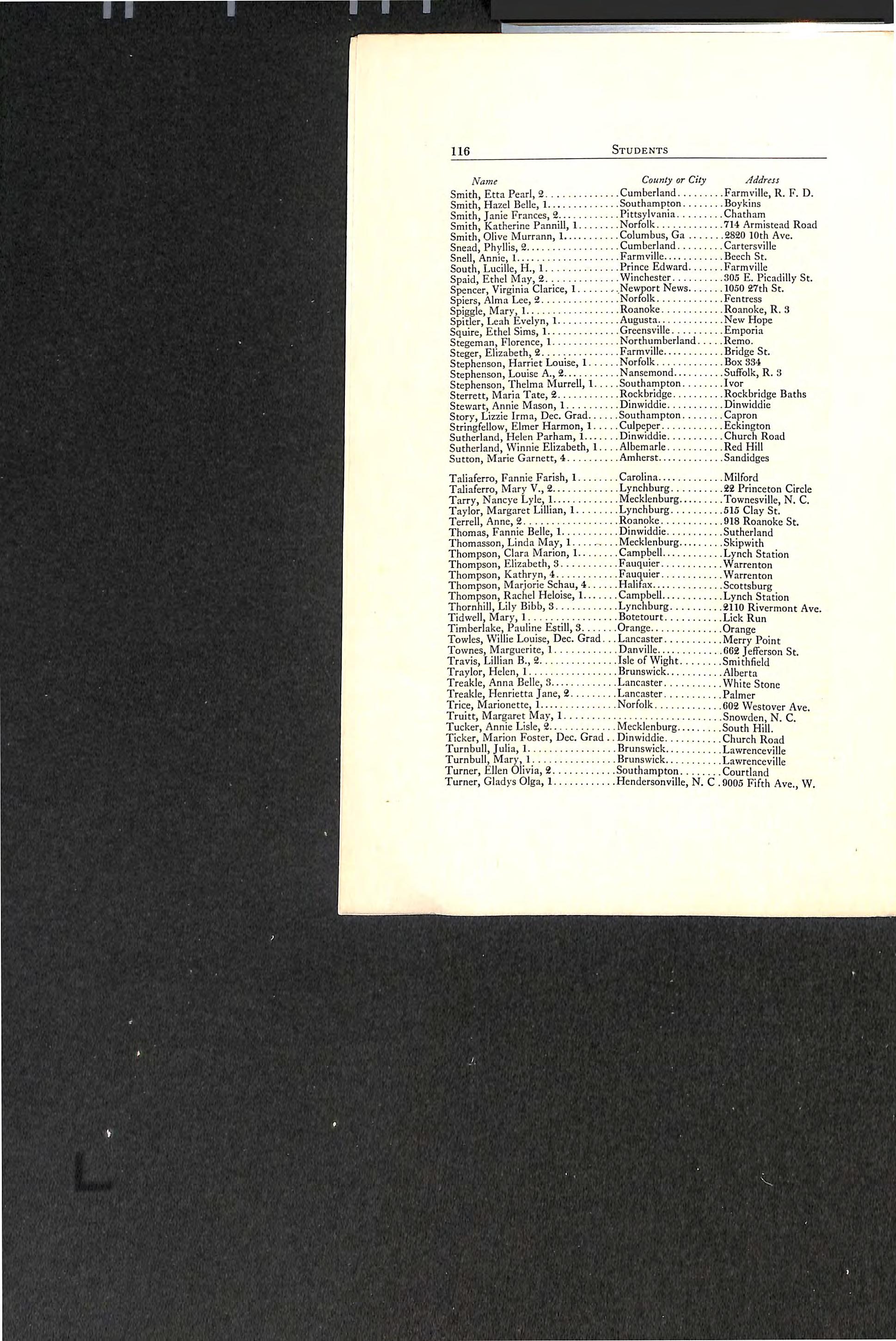
County orCity Address
Smith,Etta Pearl,2 Cumberland Farmville,R. F. D.
Smith,Hazel Belle, 1 Southampton Boykins
Smith,Janie Frances,2 Pittsylvania Chatham
Smith, Katherine Pannill,1 Norfolk 714 Armistead Road
Smith,Olive Murrann,1 Columbus,Ga 2820 10th Ave.
Snead,Phyllis,2 Cumberland Cartcrsville
Snell, Annie, 1 Farmville Beech St.
South,Lucille, H., 1 Prince Edward Farmville
Spaid,Ethel May,2 Winchester 305 E.Picadilly St.
Spencer,Virginia Clarice,1 .Newport News 105027th St.
Spiers, Alma Lee,2 Norfolk Fentress
Spiggle, Mary,1 Roanoke Roanoke,R.3
Spitler, Leah Evelyn, 1 Augusta New Hope
Squire, Ethel Sims, 1 Greensville Emporia
Stegeman,Florence, 1 Northumberland Remo.
Steger, Elizabeth,2 Farmville Bridge St.
Stephenson,Harriet Louise,1 Norfolk Box 334 Stephenson,Louise A.,2 Nansemond Suffolk,R.3
Stephenson,Thelma Murrell, 1 Southampton Ivor
Sterrett, Maria Tate,2 Rockbridge Rockbridge Baths
Stewart, Annie Mason,1 Dinwiddie Dinwiddic Story,LizzieIrma,Dec.Grad Southampton Capron Stringfellow,ElmerHarmon,I Culpeper Eckington Sutherland,HelenParham,1 Dinwiddic ChurchRoad Sutherland, Winnie Elizabeth, 1. .Albemarle Red Hill
Sutton,MarieGarnett,4 Amherst Sandidges
Taliaferro, Fannie Farish, 1 Carolina MUford Taliaferro,MaryV.,2 Lynchburg 22PrincetonCircle Tarry,Nancye Lyle, 1 Mecklenburg Townesville,N.C. Taylor, Margaret Lillian, 1 Lynchburg 515 Clay St. Terrell,Anne,2 Roanoke 918RoanokeSt. Thomas,FannieBelle,1 Dinwiddie Sutherland Thomasson,LindaMay,1 Mecklenburg Skipwith Thompson, Clara Marion,1 Campbell Lynch Station Thompson,Elizabeth,3 Fauquier Warrenton Thompson,Kathryn,4 Fauquier Warrenton Thompson,MarjorieSchau,4 Halifax Scottsburg Thompson,RachelHeloise,1 Campbell LynchStation Thornhill,LilyBibb,3 Lynchburg 2110RivermontAve. Tidwell,Mary,1. Botetourt LickRun Timberlake,Pauline Estill,3 Orange Orange Towles, Willie Louise, Dec. Grad...Lancaster Merry Point Townes, Marguerite, 1 Danville GG2 Jefferson St. Travis,LillianB.,2 IsleofWight Smithfield Traylor,Helen,1 Brunswick Alberta Treakle,AnnaBelle,3 Lancaster WhiteStone Treakle,HenriettaJane,2 Lancaster Palmer Trice, Marionette, 1 Norfolk 602 Westover Ave. Truitt, Margaret May,1 Snowden, N. C. Tucker,AnnieLisle,2 Mecklenburg SouthHill. Ticker,MarionFoster,Dec.Grad..Dinwiddie ChurchRoad Turnbull,Julia,1 Brunswick Lawrenceville Turnbull,Mary,1 Brunswick Lawrenceville Turner,EllenOlivia,2 Southampton Courtland Turner,GladysOlga,1 Hendersonville,N.C.9005Fifth Ave.,W.
116 Students
Name Upton,Lucille,2.
Valiska,Emily,1
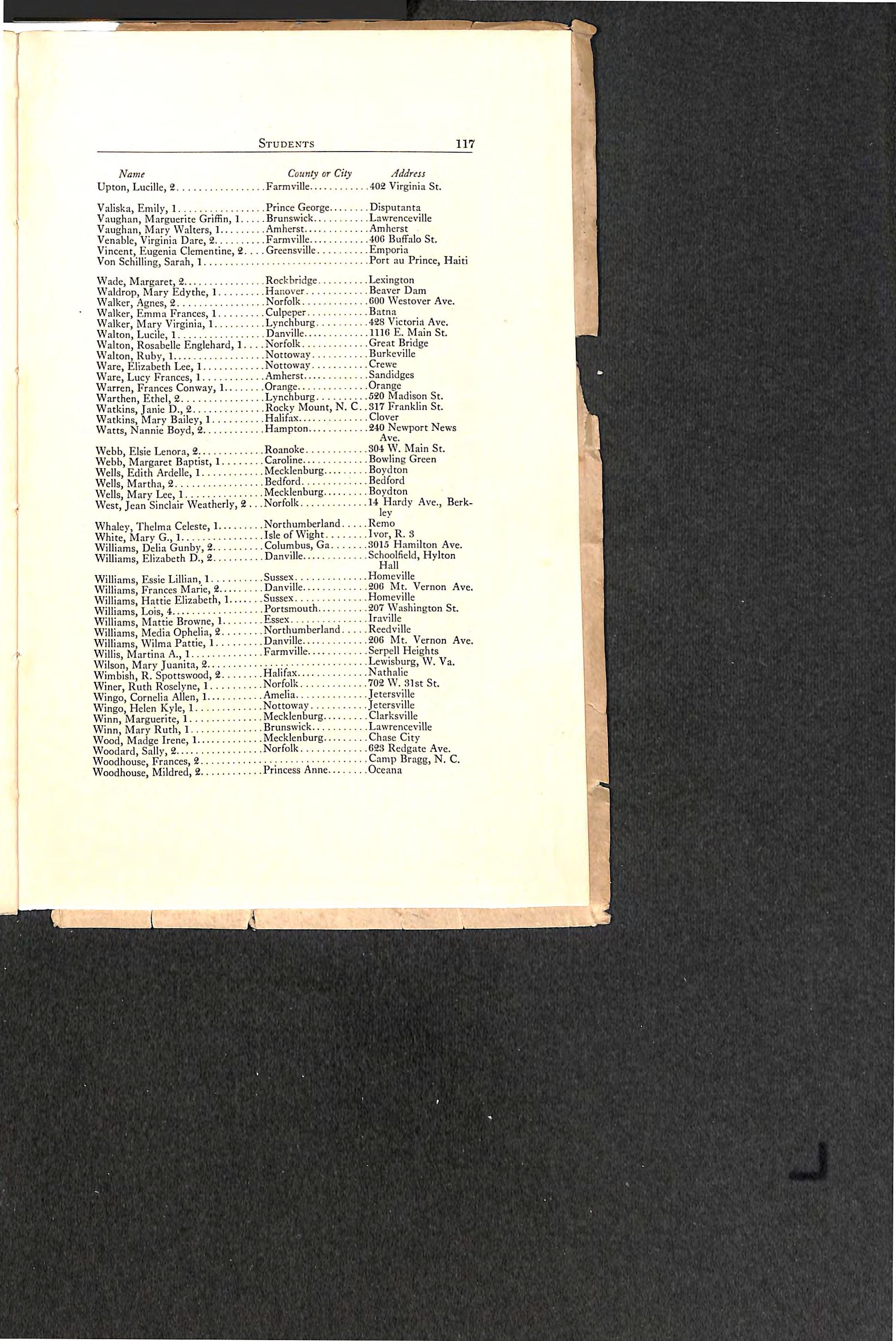
Students
CountyorCity Address .Fannville 402VirginiaSt
PrinceGeorge Disputanta Vaughan,MargueriteGriffin,1 Brunswick Lawrenceville Vaughan,MaryWalters,I Amherst Amherst Venablc,VirginiaDare,2 Farmville 40CBuffaloSt. Vincent, Eugenia Clementine,2....Grcensville Emporia Von Schilling,Sarah,1 Port au Prince,Haiti
Wade,Margaret,2
Rockbridgc Lexington Waldrop, Mary Edythe,1 Hanover Beaver Dam Walker, Agnes,2 Norfolk COO Westover Ave. Walker,Emma Frances,1 Culpeper Batna Walker, Mary Virginia,1 Lynchburg 428 Victoria Ave. Walton,Lucite,1 Danville UlC E. Main St. Walton,Rosabelle Englehard,1. .Norfolk Great Bridge Walton,Ruby,1 Nottoway Burkevillc Ware,Elizabeth Lee,1 Nottoway Crewe Ware,Lucy Frances, 1 Amherst Sandidges Warren,Frances Conway,1 Orange Orange Warthen,Ethel,2 Lynchburg 520MadisonSt. Watkins,JanieD.,2 Rocky Mount,N.C..317FranklinSt. Watkins,Mary Bailey,1 Halifax Clover Watts,Nannie Boyd,2 Hampton 240 NewportNews Ave.
Webb,ElsieLenora,2 Roanoke 804W.MainSt. Webb,Marg.iretBaptist,1 Caroline Bowling Green Wells,Edith Ardelle,1 Mecklenburg Wells,Martha,2 Bedford Bedford Wells,MaryLee,1 Mecklenburg Boydton West,JeanSinclairWeatherly,2...Norfolk 14HardyAve.,Berklev
Whaley,ThelmaCeleste,1
Northumberland Remo White,MaryG.,1 IsleofWight Ivor,R.3 Williams,DeliaGunby,2 Columbus,Ga SOUHamiltonAve. Williams,ElizabethD.,2 Danville Schoofield,Hylton Hall
Williams,EssieLillian,1 S"®sex Homeyille Williams,FrancesMarie,2 Danville 200 Mt. Vernon Ave, Williams,Hattie Elizabeth,1 Sussex... ® Williams,Lois,4 Portsmouth 207WashingtonSt. Williams,Mattie Browne,1 Essex. Williams,MediaOphelia,2 Northumberland Reedvillc Williams,WilmaPattie,1 Danville 20G Mt.Vernon Ave Willis,M.irtina A.,1 Farmville SerpellHeights Wilson,MaryJuanita,2 Wimbish,R.Spottswood,2 Hali/ax c Winer,RuthRoselyne,1 Norfolk 702W..SlstSt. Wingo,CorneliaAllen,1 Amelia Jetersvie Wingo,HelenKyle,1 Nottoway ? Winn,Marguerite,1 Mecklenburg Qarksville Winn,MaryRuth,1 Brunswick Lawrenceville Wood,MadgeIrene,1 Mecklenburg Chase City Woodard,Sally,2 Norfolk 623Redgate Ave. Woodhouse,Frances,2 CampBragg,N.C. Woodhouse,Mildred,2 PrincessAnne Oceana
Name

Students
CountyorCity Address
Woolfolk,EllaThelma,1 Caroline Woodford Wright,BessieLee,I Nelson Lovingston Wright,MargaretElizabeth,1 Norfolk. Portsmouth,R.2 Wyche,LauriceLee,I Greensville Emporia
Yates,GladysHarrell,2 Suffolk 452W.WashingtonSt. Yeatts,EthelKathleen,1 Danville GOOJeffersonSt. Yost,RebeccaSylvia,1 Roanoke 207GrandinRoad Young,MaryHazel,1 Dinwiddie McKenney Young,MaryPearie,4 Farmville SerpeilHeights
Zehmer,Eslie,1 Dinwiddie McKenney Zehmer,RobertaRuth,1 Dinwiddie McKenney
RECAPITULATION
NOTE:—FiRurcafollowingnamcaofstudentsindicateClass:as,1,FirstYear;2,SecondYear;3,Third Year;4,FourthYear.
StudentsintheThird and Fourth Yearshavecompleted thetwo-yearcourserequiredforthediploma andarenowIntinefortheDegreeofBachelorofScienceinEducation.
118
ProfessionalDepartment 591 TotalinHighSchoolDepartment 112 TotalinGrades 300
Totalin
in the School 1,003
717 Grand total since June,1922
Total number of graduates
Total receiving instruction
StudentsinSummerSchool,1922
1,720
2,623
JANUARY S M T W T F S 1 2 3 4 5 6
7 8 9 10 11 12 13 14 15 10 17 18 19 20 21 22 23 24 25 26 27 28 29 30 31
FEBRUARY 1 2 3 4 5 6 7 8 910 11 12 13 14 15 16 17 18 19 20 21 22 23 24 25 28 27 28
4 5 6 7 8 010 11 12 13 14 15 16 17 18102021222324 25 26 27 28 29 30 31 SEPTEMBER 2 3 4 5 6 7 8 9 10 11 12 13 14
2 3

APRIL 1 2 3 4 6 6 7 8 91011 121314 15161718192021 222324252627 28 2930
MAY 1 2 346 6 7 8 9101112 13141516171816 20212223242526 2728293031
JUNE 1 2
3 4 5 6 7 8 9 10111213141516 1718 19 2021 2223 24252627282030
OCTOBER 1 2 3 4 5 6 7 8 0 10 11
NOVEMBER 1 2 3 4 6 6 7 8 9 10 11 12 13 14 15 16 17 18 19 20 21 22 23 24 25 26 27 28 29 30
DECEMBER 1 2 3 4 5 6 7 8 9 10 11 12 13 14 15 16171819202122 23 24 25 26 27 28 29 30 31
MAY 1 2 3 4 5 6 7 8 9 10 11 12 13 14 15 16 17 18 19 20 21 22 23 24 25 26 27 28 29 30 31
JUNE 1 2 3 4 5 6 7 8 91011 121314 16 16 17 13 19 20 21 22 23242526 27 28 2930
- 1 2 3 4 5 6 7 8 9 10 11 12 13 14151617IS1920 21222324252627 28 29 30
1 2 3 4 5 6 7 8 91011 12131415161718 19 20 21 22 23 24 25 28 27 28 29 30 31
NOVEMBER 2 3 4 5 6 7 8 9 10 11 12 13 14 15 16171819202122 23242528272829 30
DECEMBER - 1 2 3 4 6 6 7 8 9 10 11 12 13 1415 16 17 18 19 20 21 2223 24 25 26 27 28 293031
1923 1924
CALENDAR
JULY
22
JANUARY
-.-
0 7 8 9 10 11 12 13141516171819 20 21 22 23 24 25 26 27 28 29 30 31 JULY
S M T W T F S 1 2 3 4 5 6 7 8 0 10 11 12 13 14 15 16 17 18 19 20 21
23 24 25 26 27 28 29 30 31
S M T W T F S
1 2 3 4 5
5 M T W T F 8 1 2 3 4 5 6 7 8 9101112 13 14 15 16 17 18 19 20212223242526 2728293031
AUGUST
5
11
19
23 24 25 26 27 28 29 30 31 FEBRUARY 1 2 3 4 5 6 7 8 9 10 11 12 13 14 15 16 17 18 19 20 21 22 23 24 25 26 27 28 29 AUGUST
1 2 3 4
6 7 8 9 10
12131415161718
20 21 22
1 2 3 4 5 6 7 8 0 10 11 12 13 14 15 16 17181920212223 24252627282930 31 MARCH 1
15 16171819202122 23242526272829 30 MARCH 2 3 4 6 6 7 8 9 10 11 12 13 14 15 16 17 18 19 20 21 22 23 24 25 26 27 28 29 30 31 SEPTEMBER
12 13 14 16 16 17 18 19 20 21 22 23 24 25 26 27 28 29 30 31 APRIL
45 6 7 8
13141516171819
1 2 3
9101112
20212223242526 27282930 OCTOBER
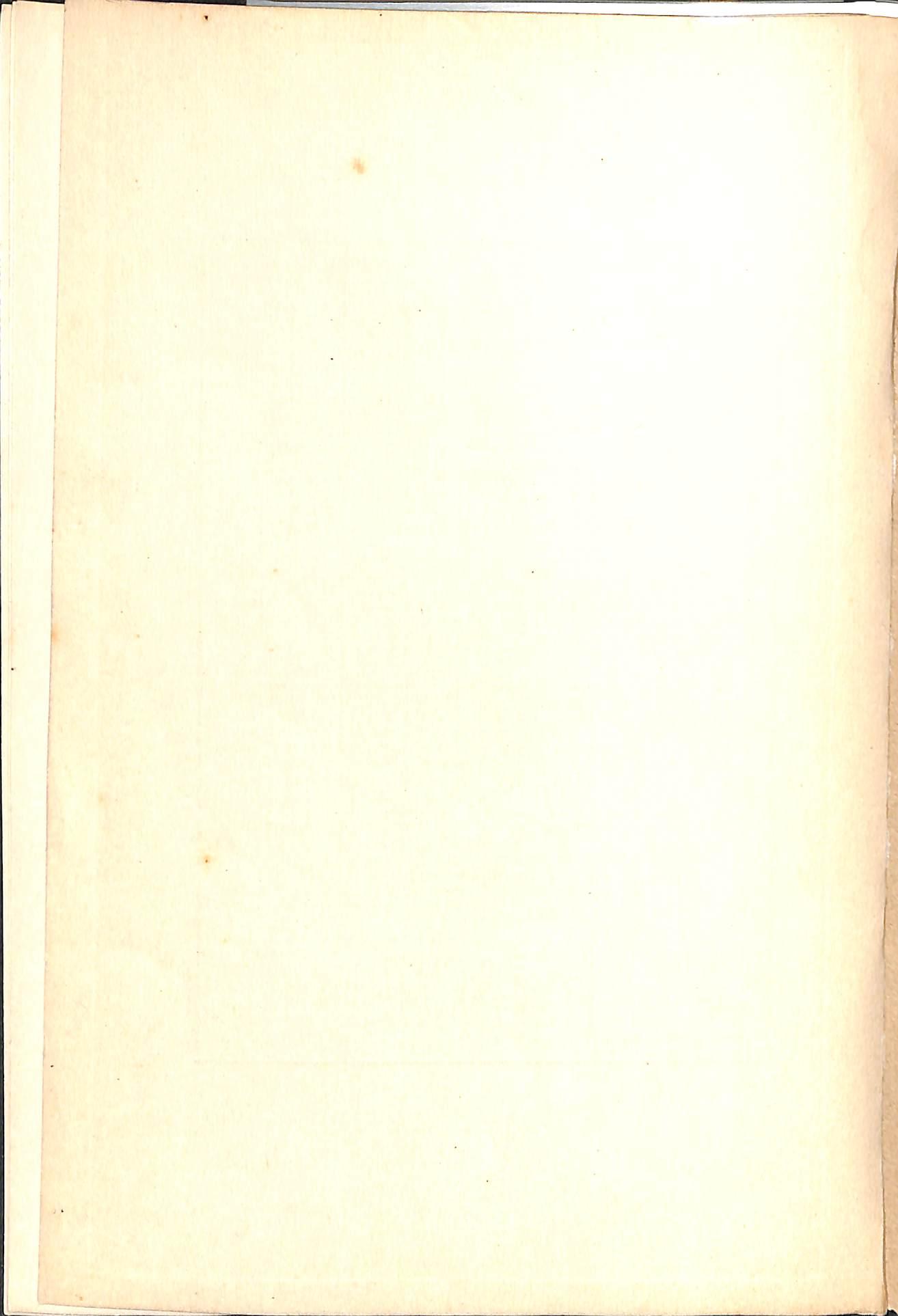
f
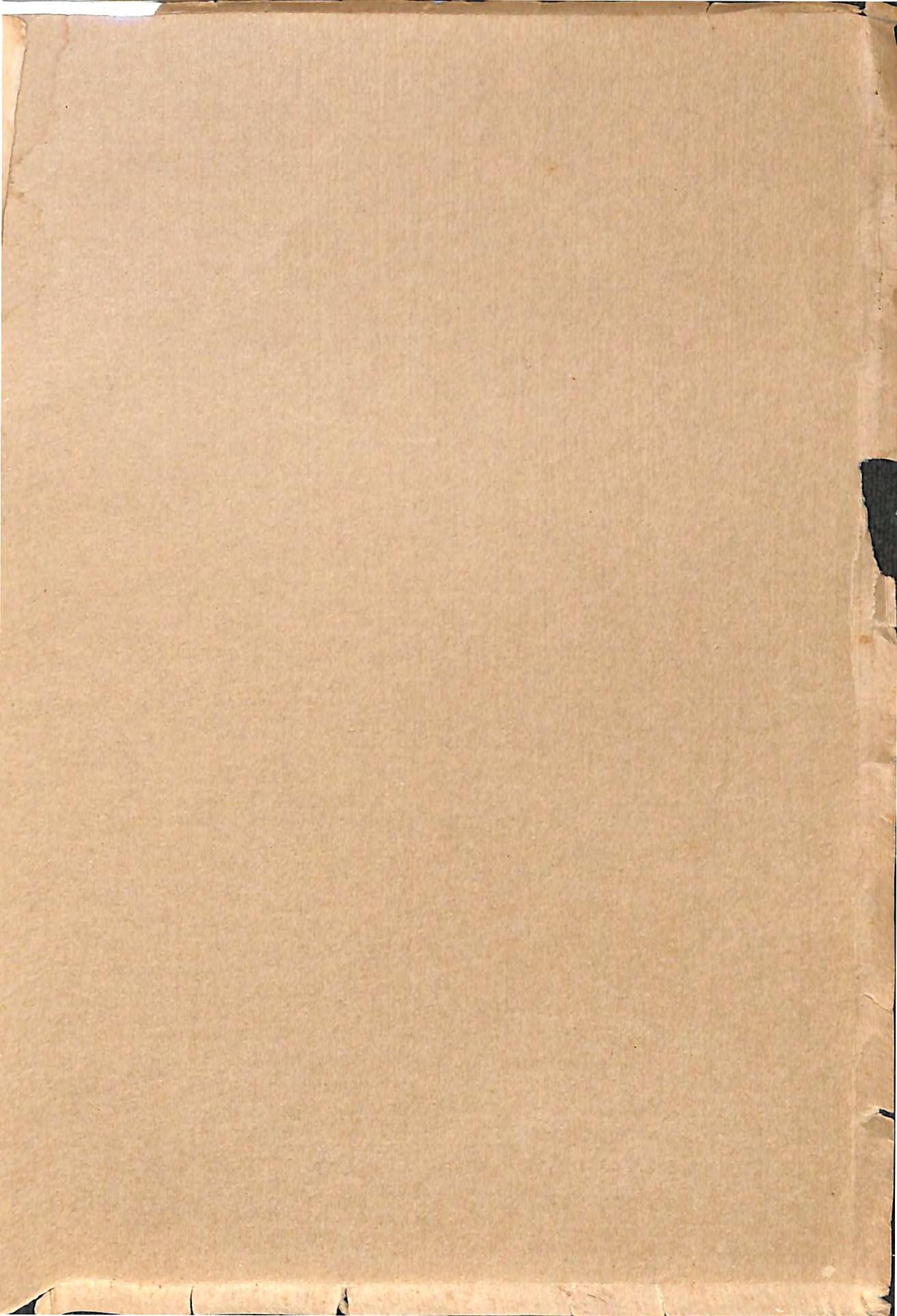
I ; - .' ■ •'; '.• •"'?"■'■••■ 7 '.■• ■: "aJ: i •» 'til '•' I*" .«'. ) >W' iXi n\,x\
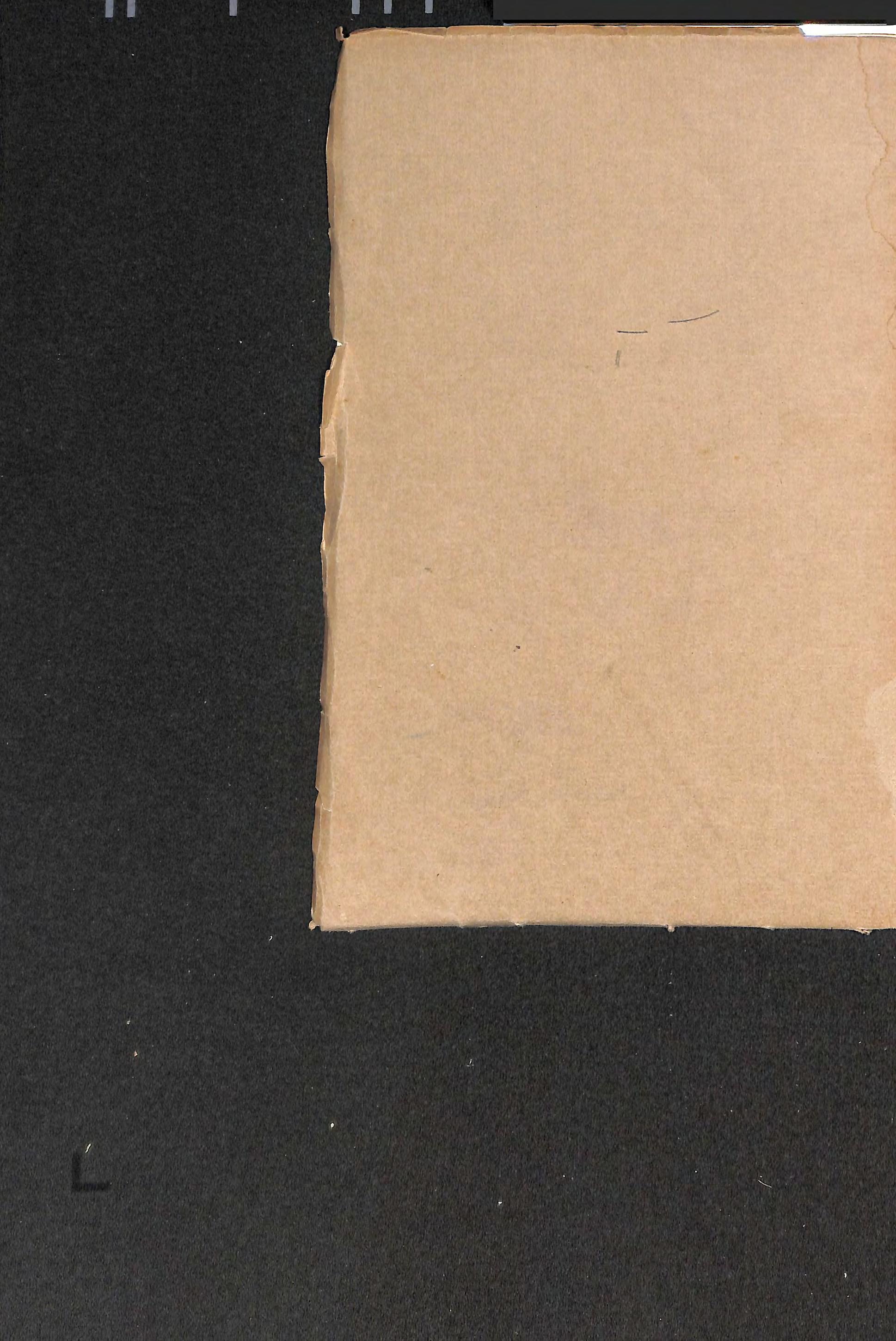
.V _ . ,U-' . V ., , /. " •' "'t/- . Ki-' ■V'i. :






























































































































